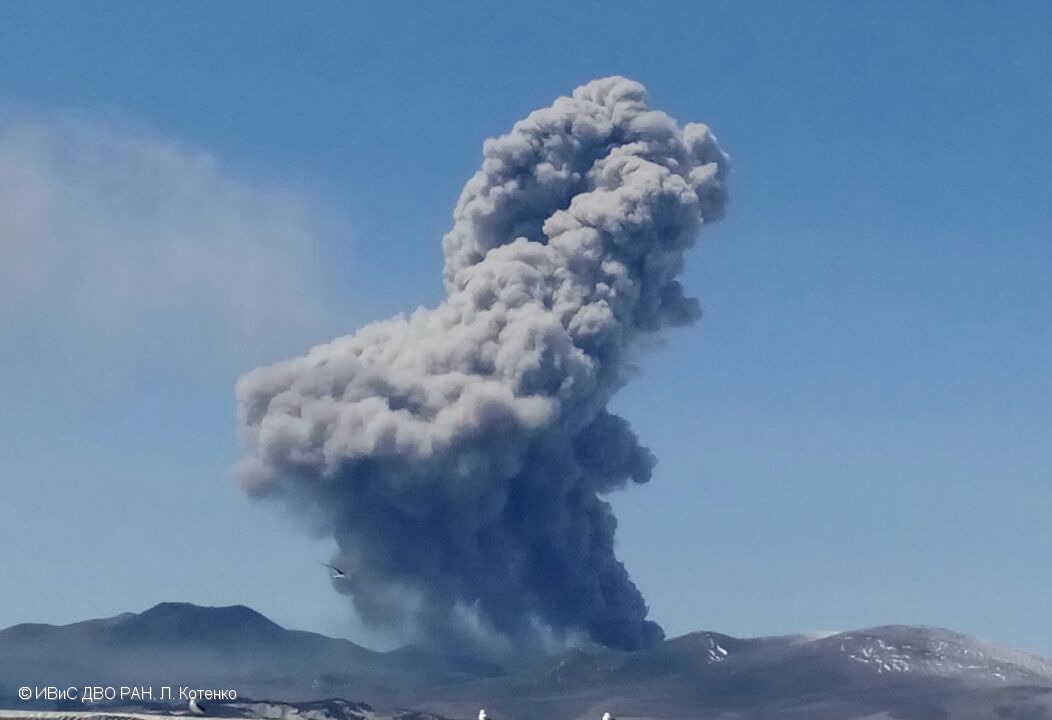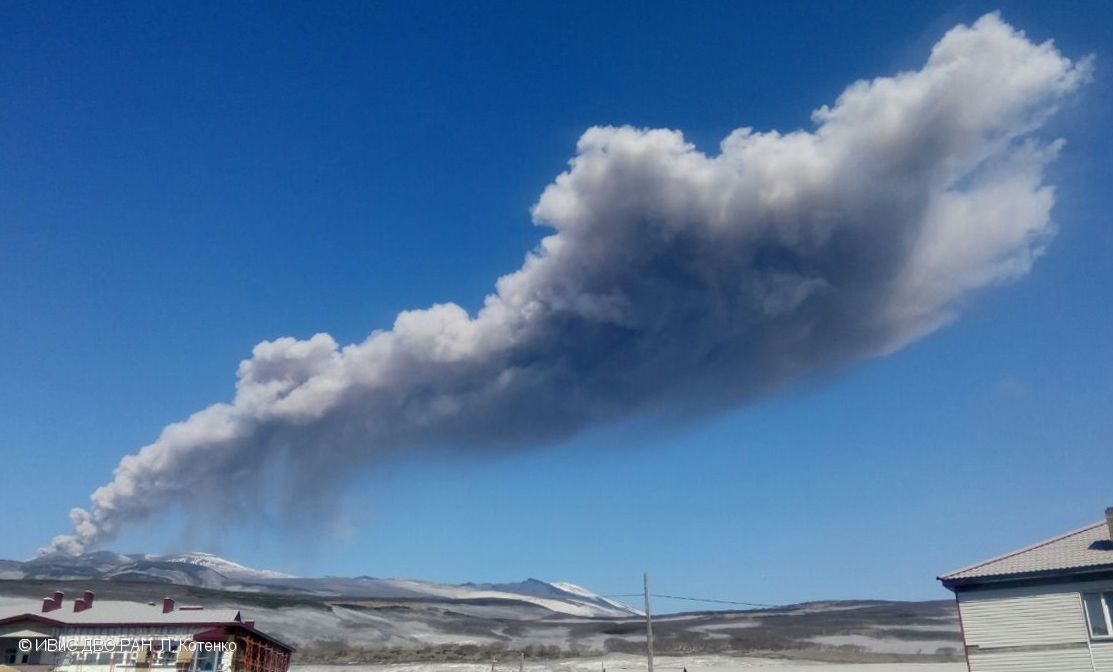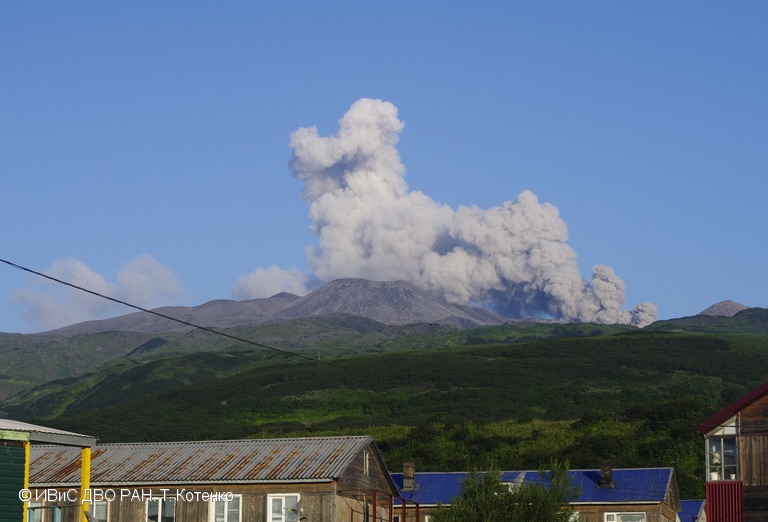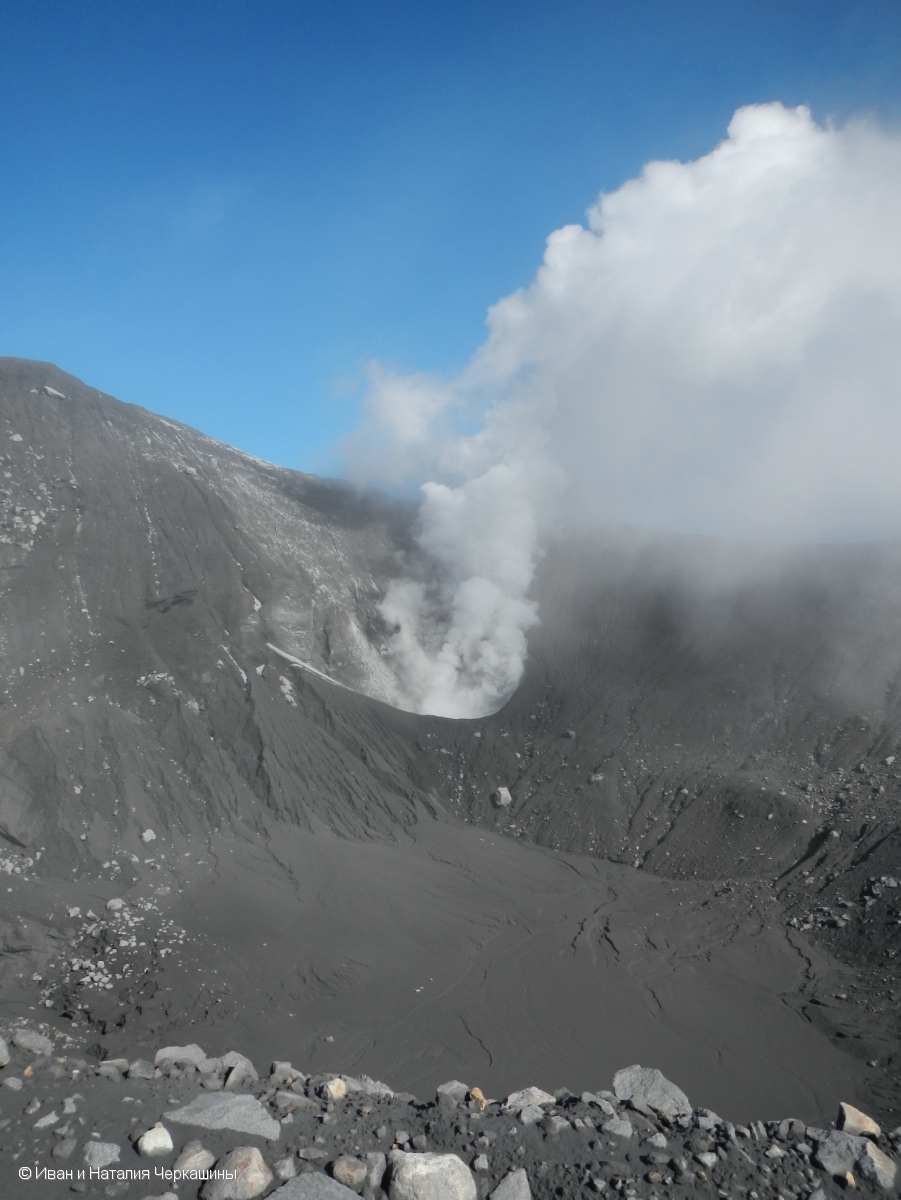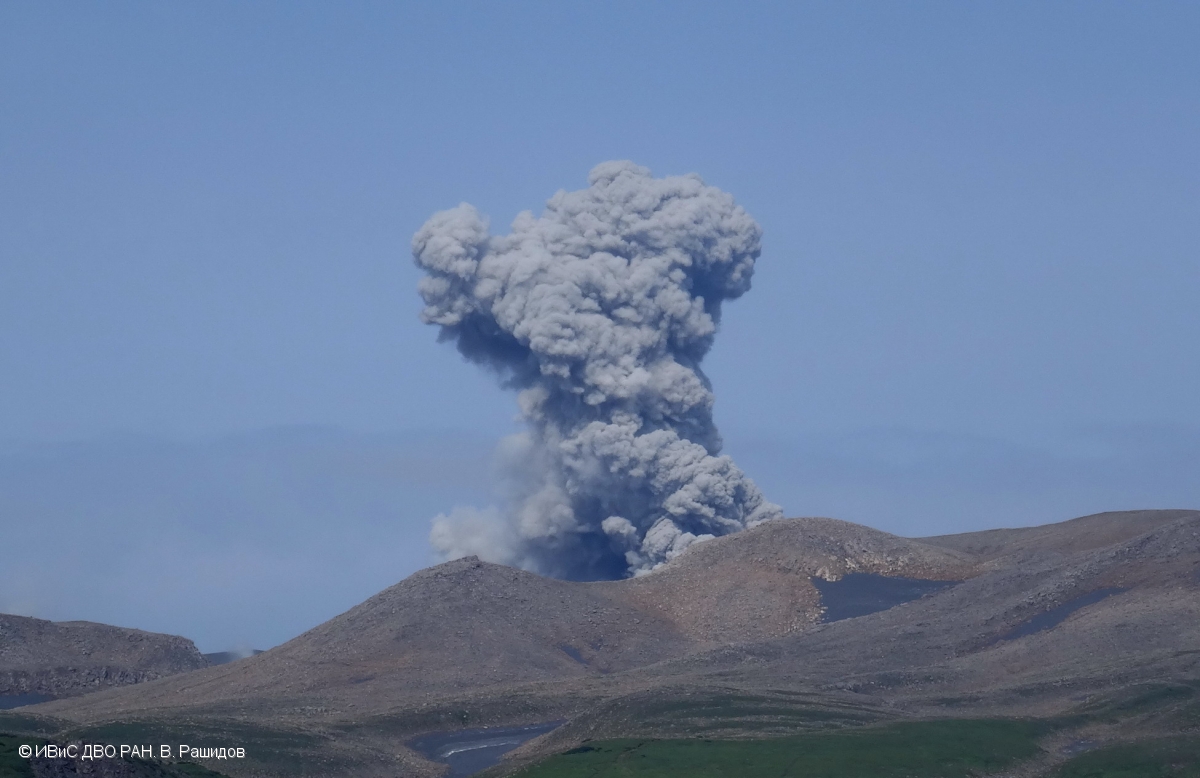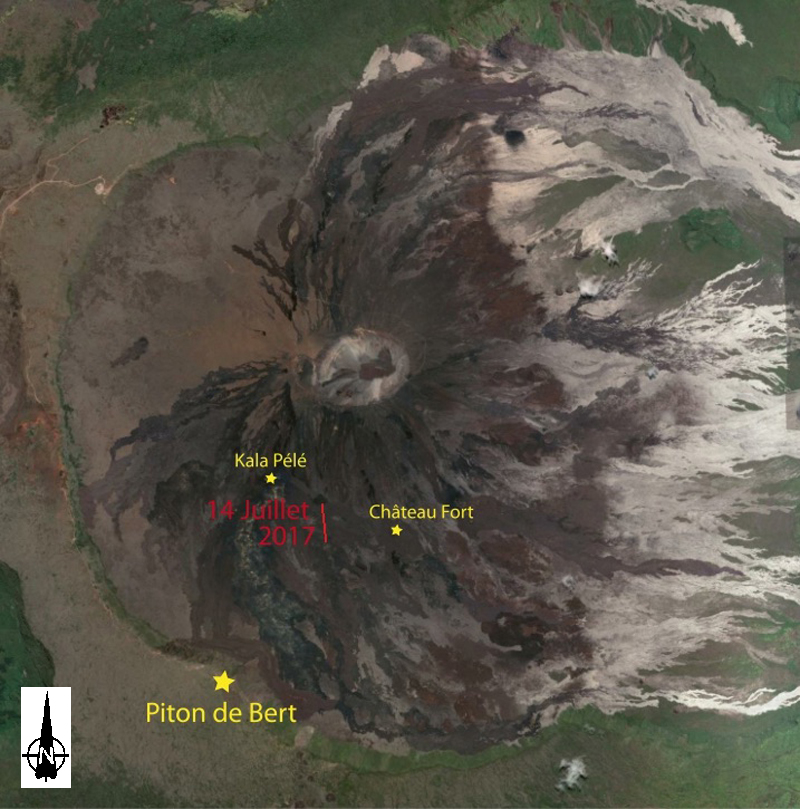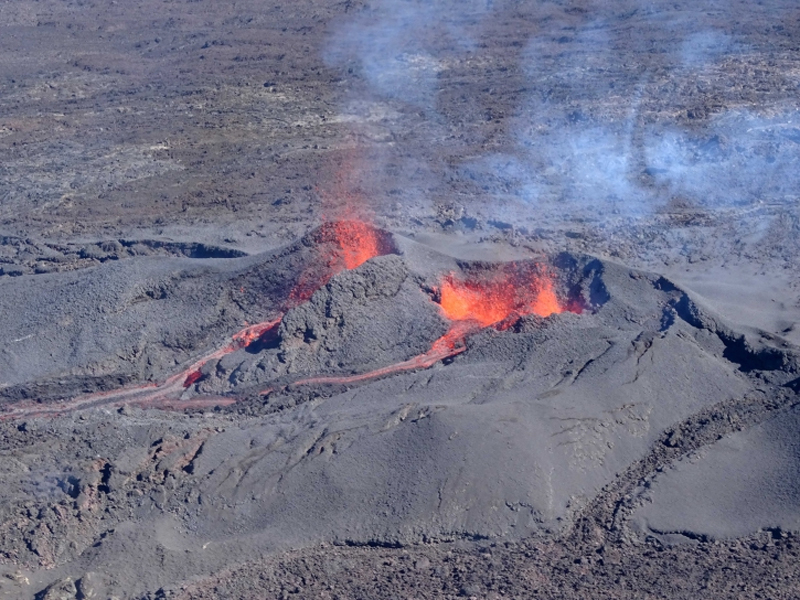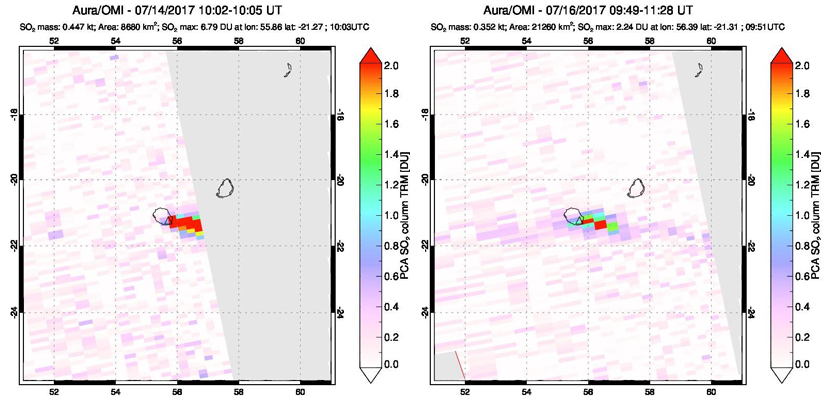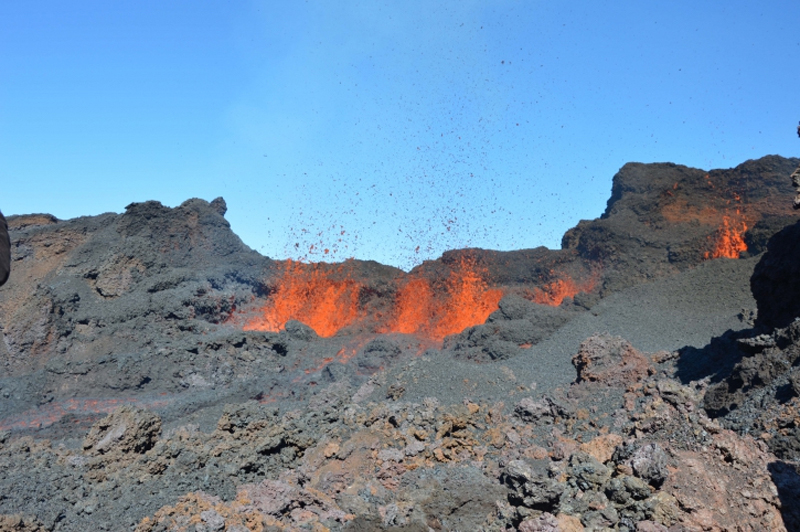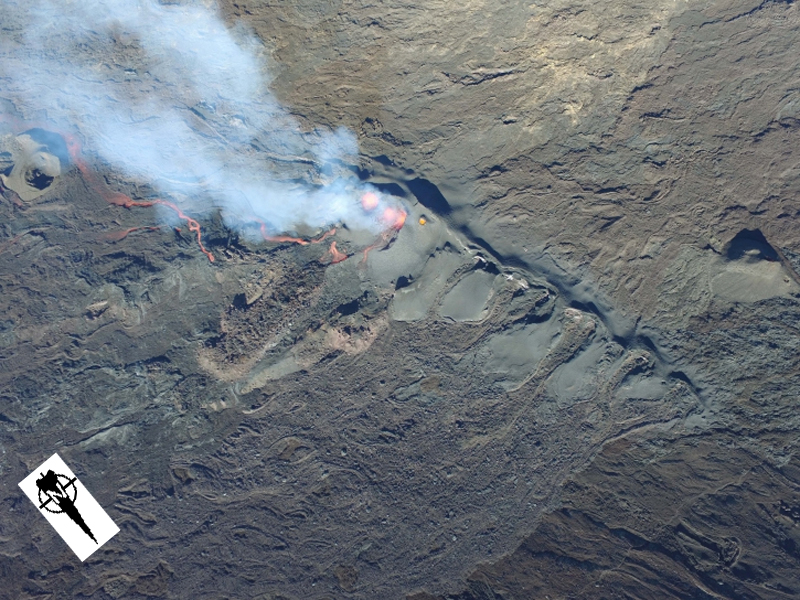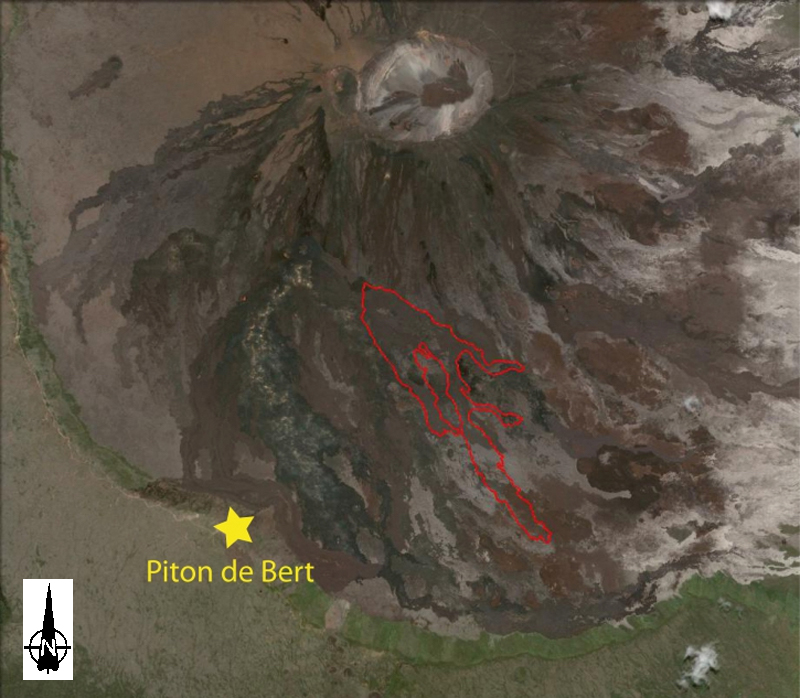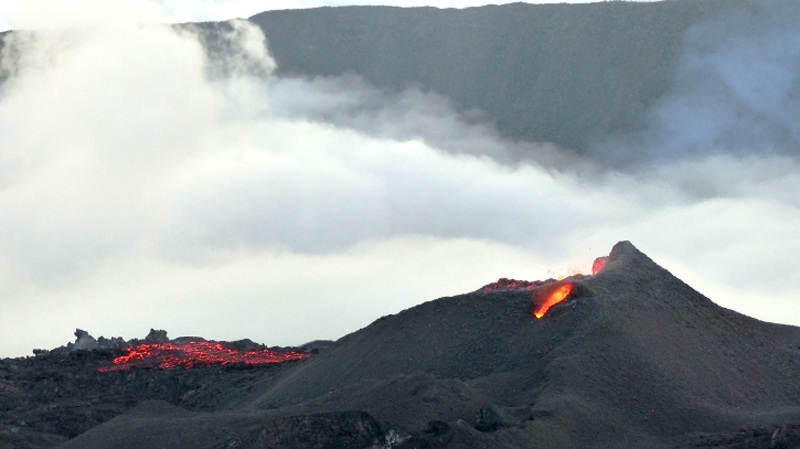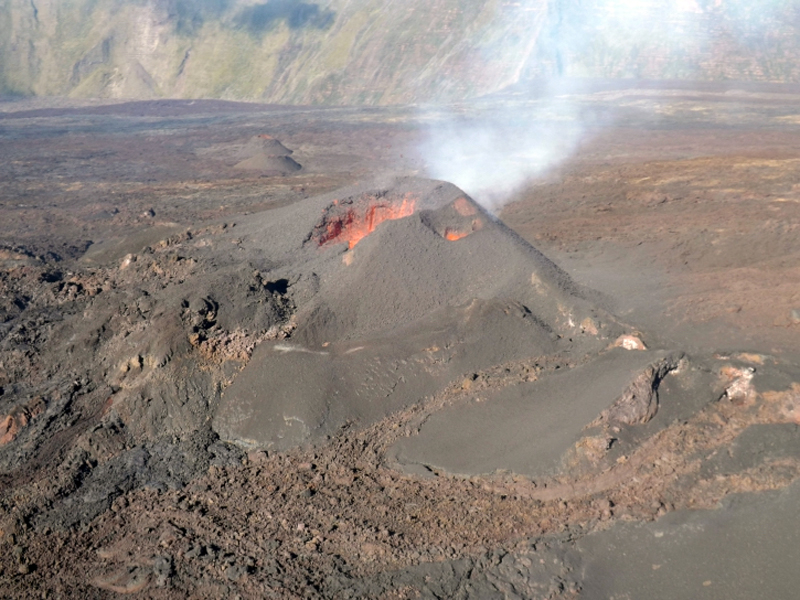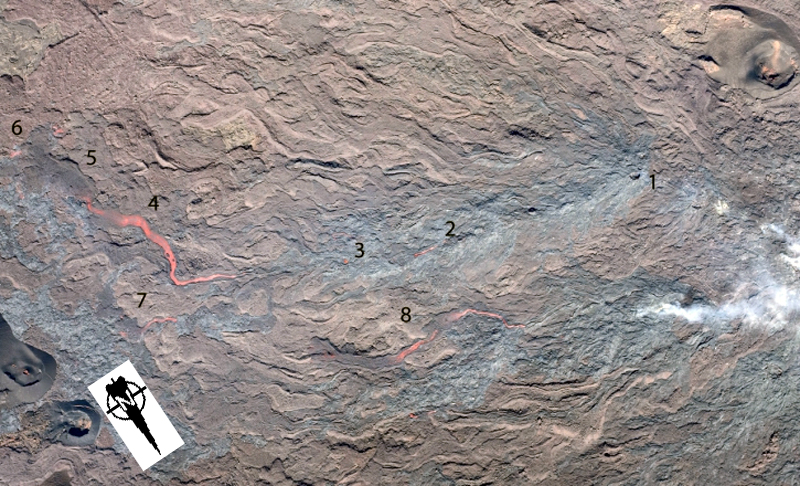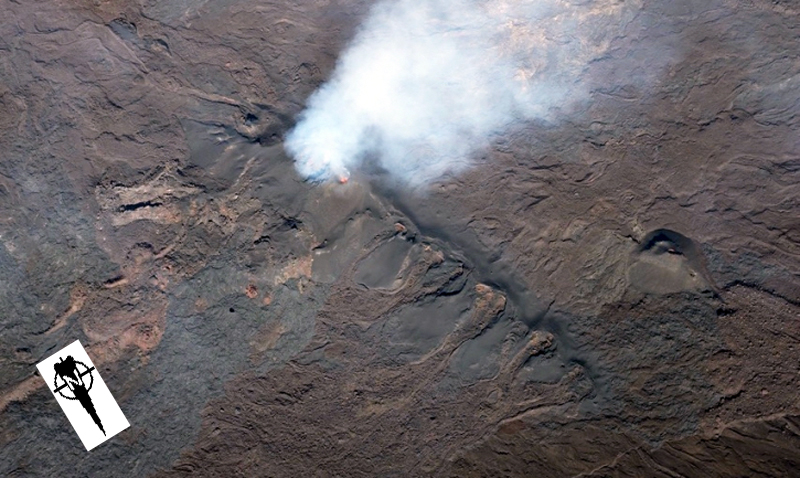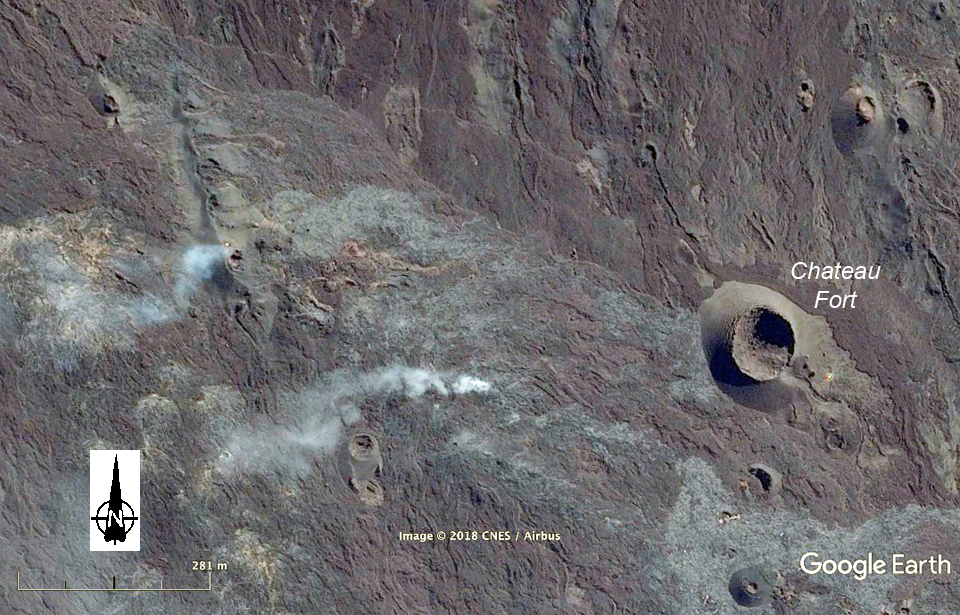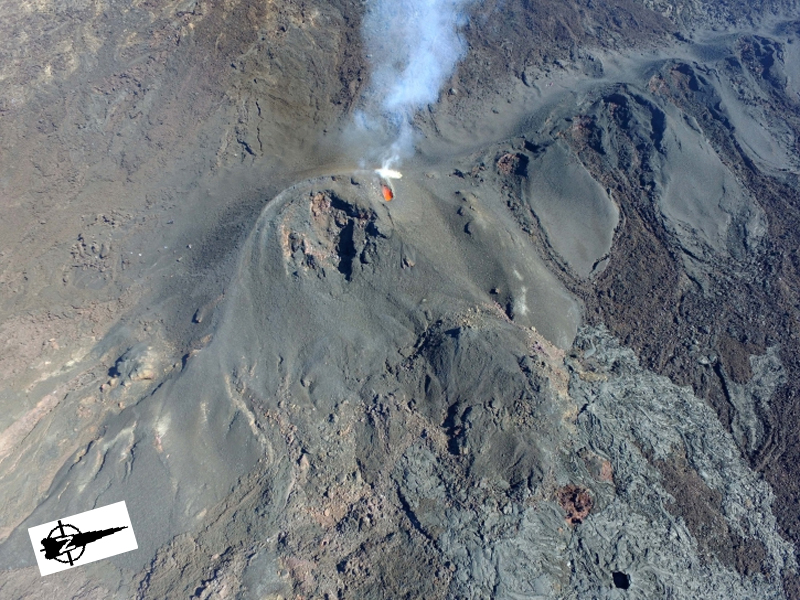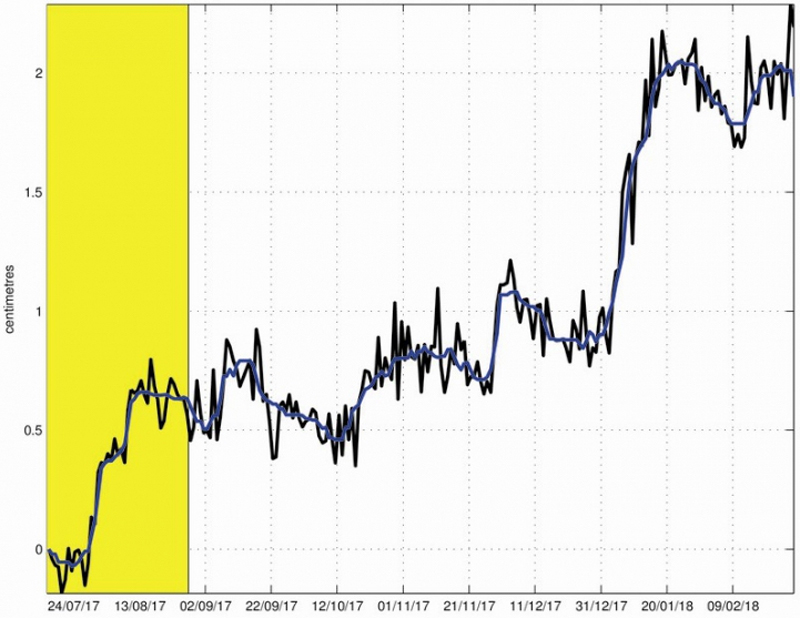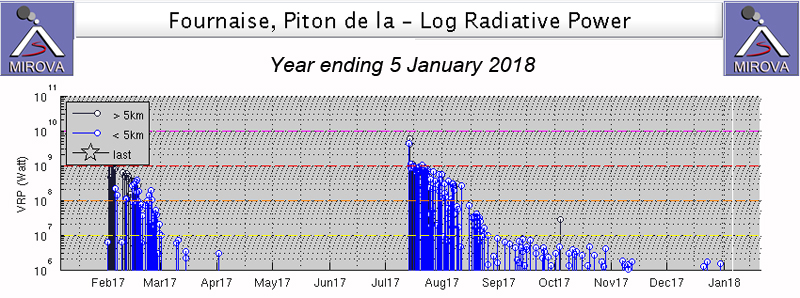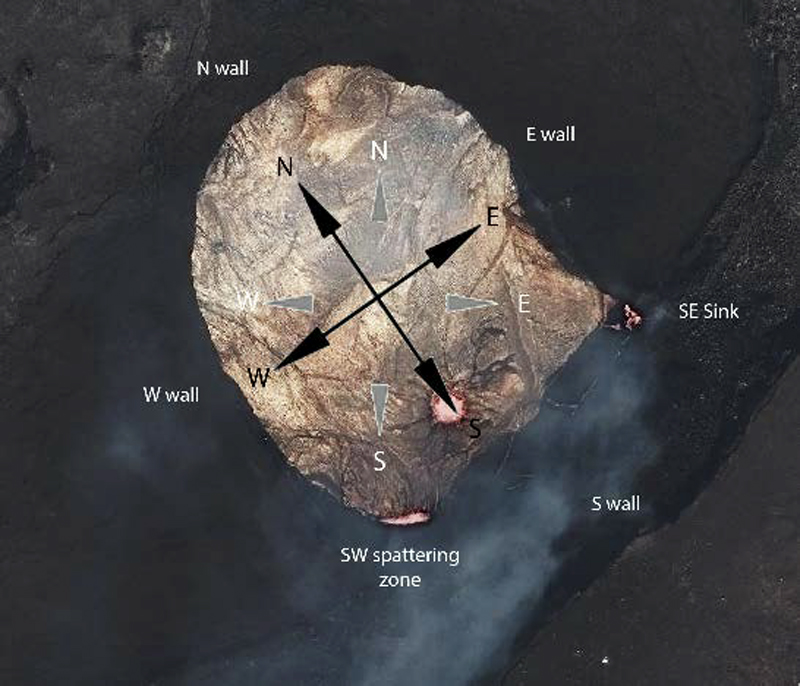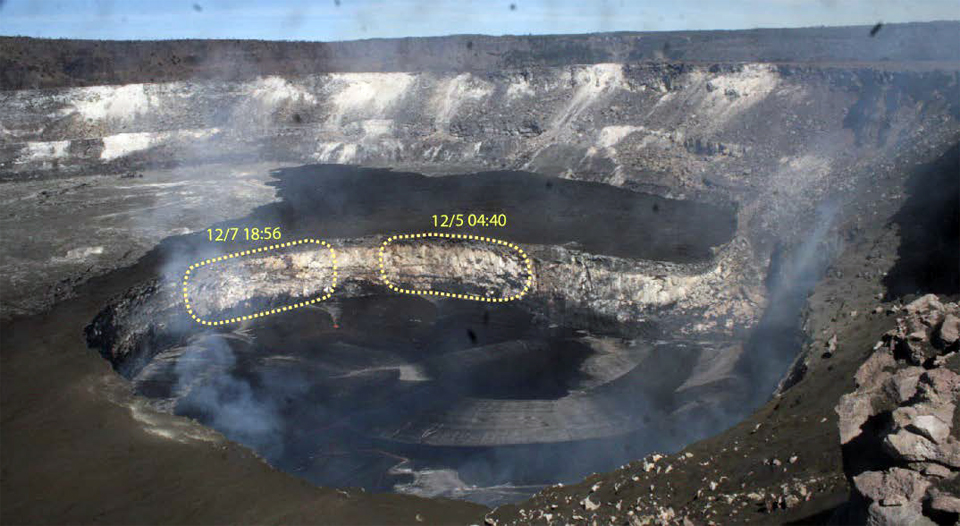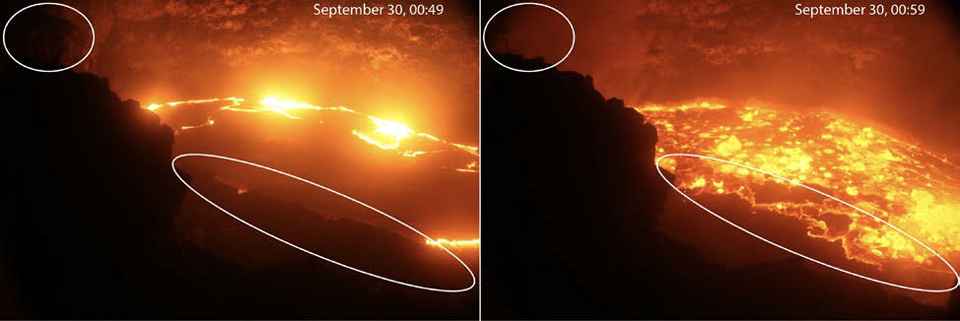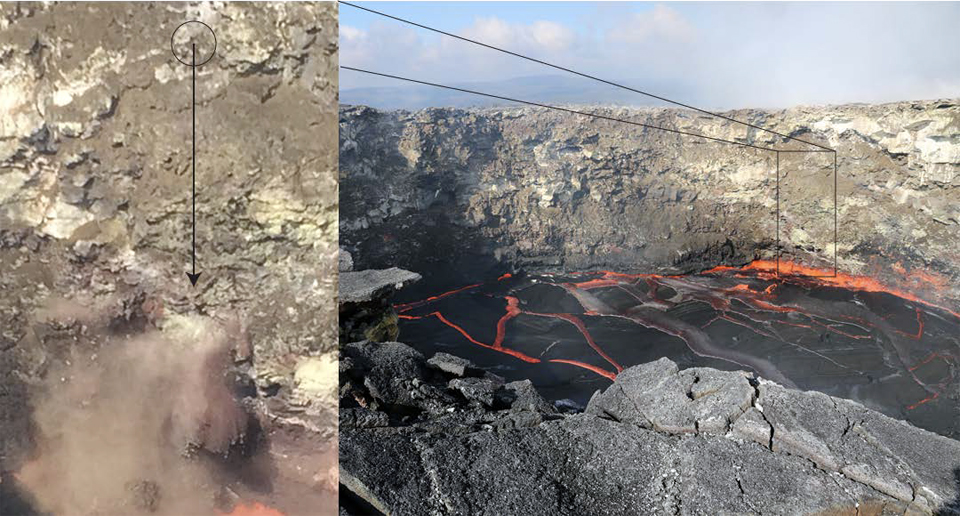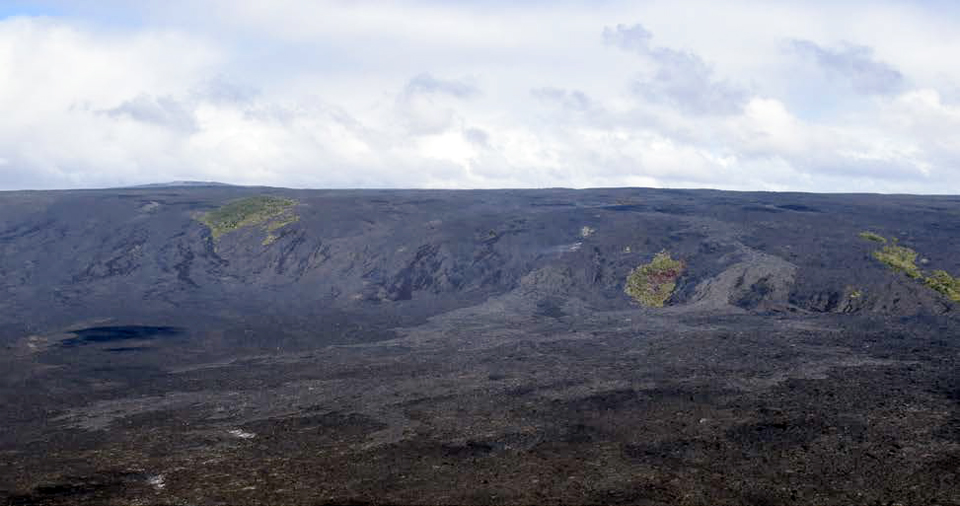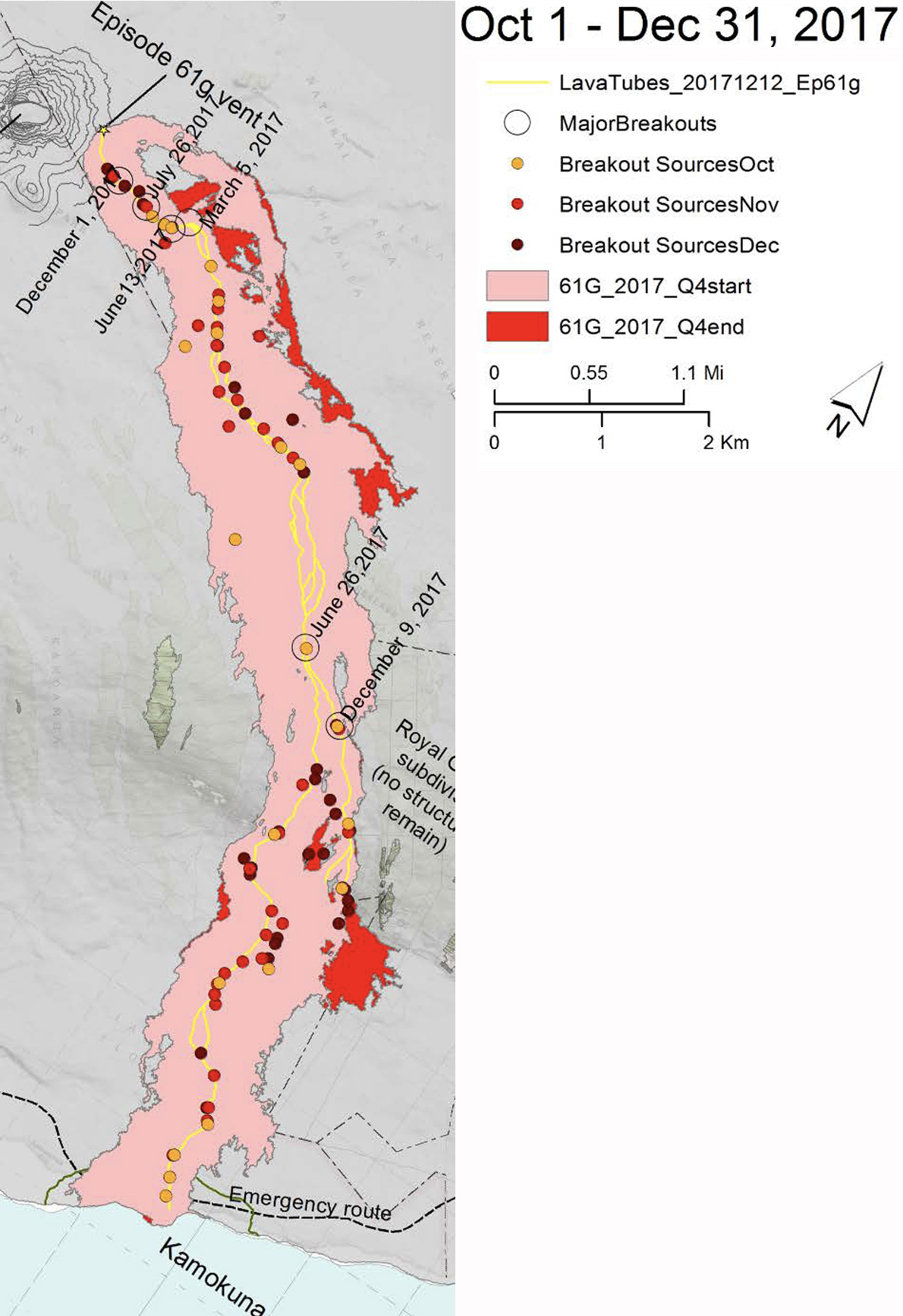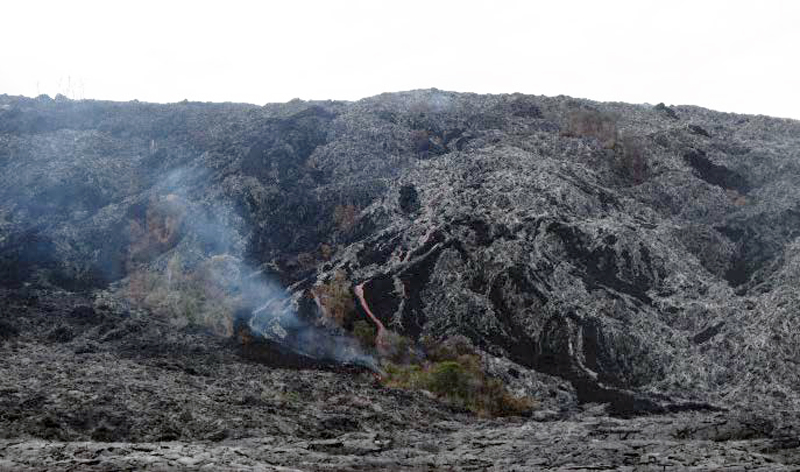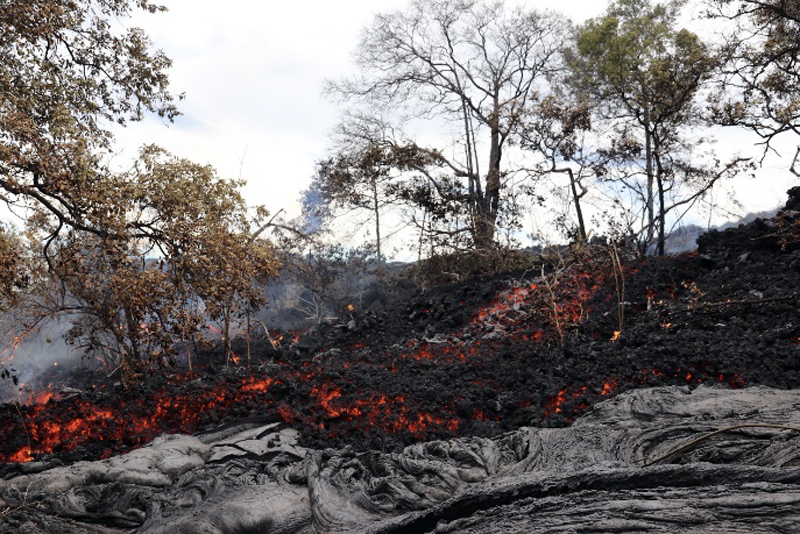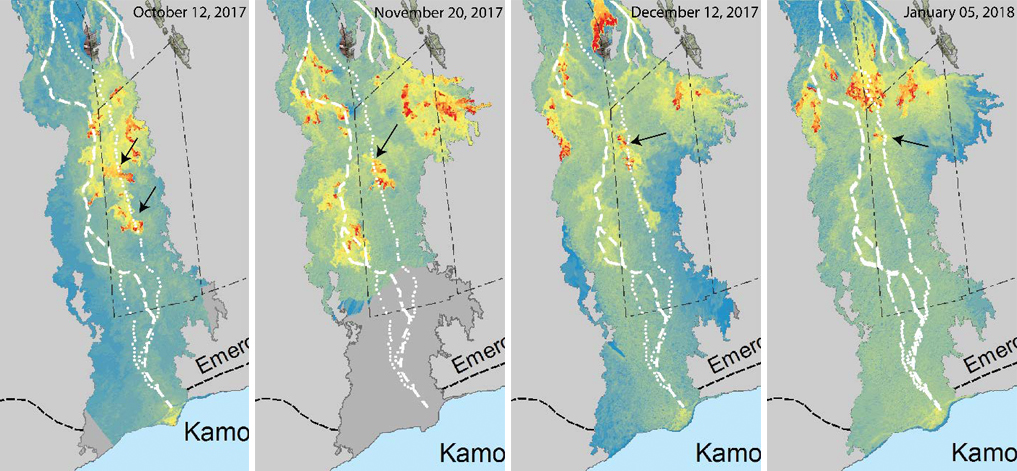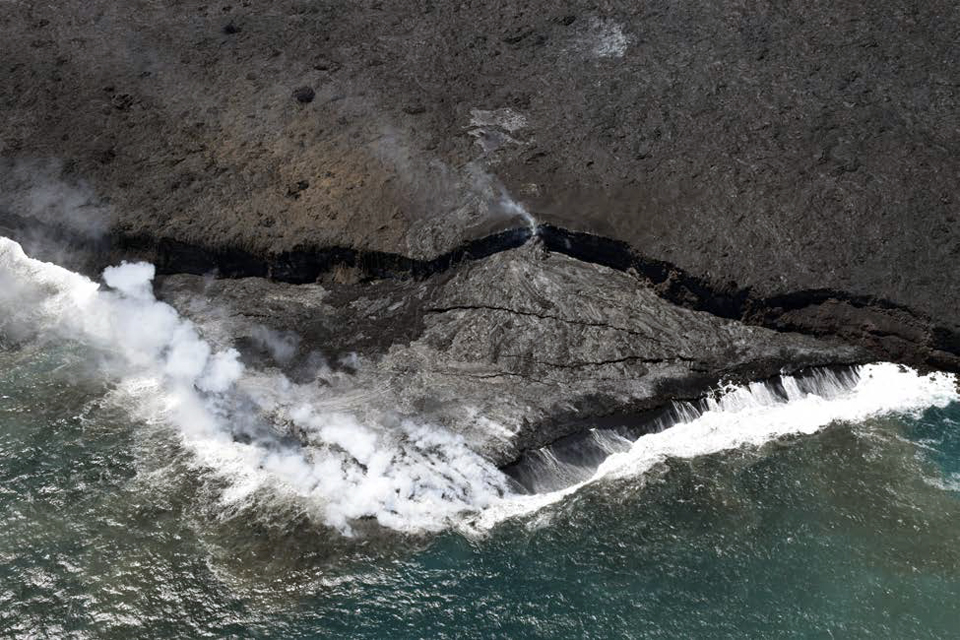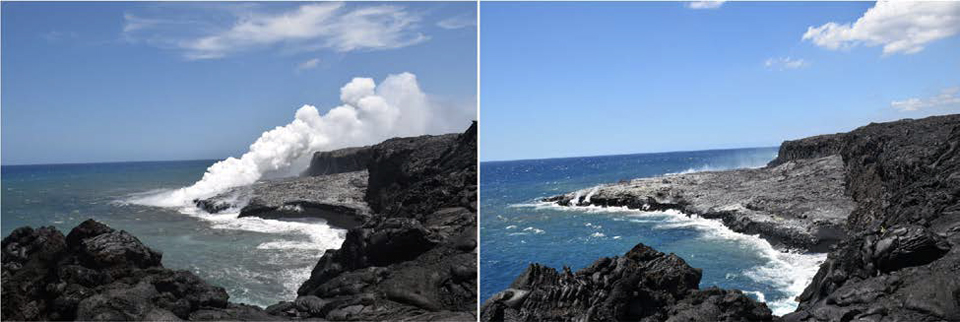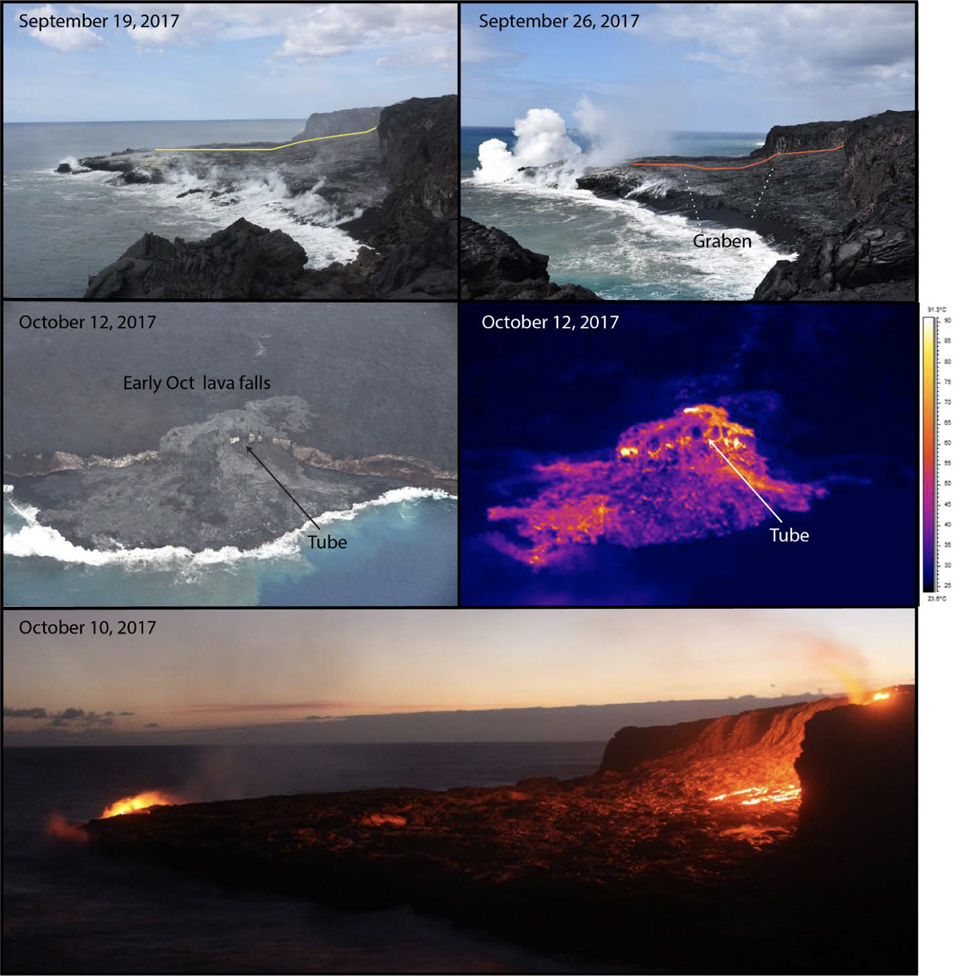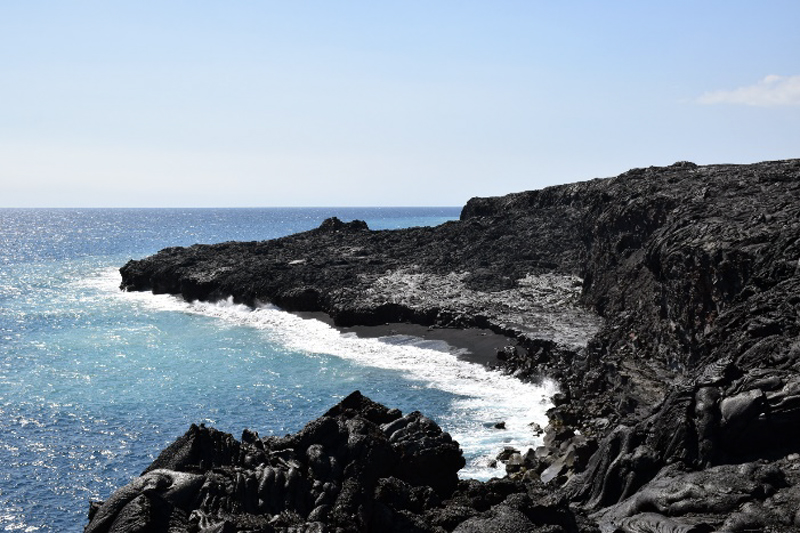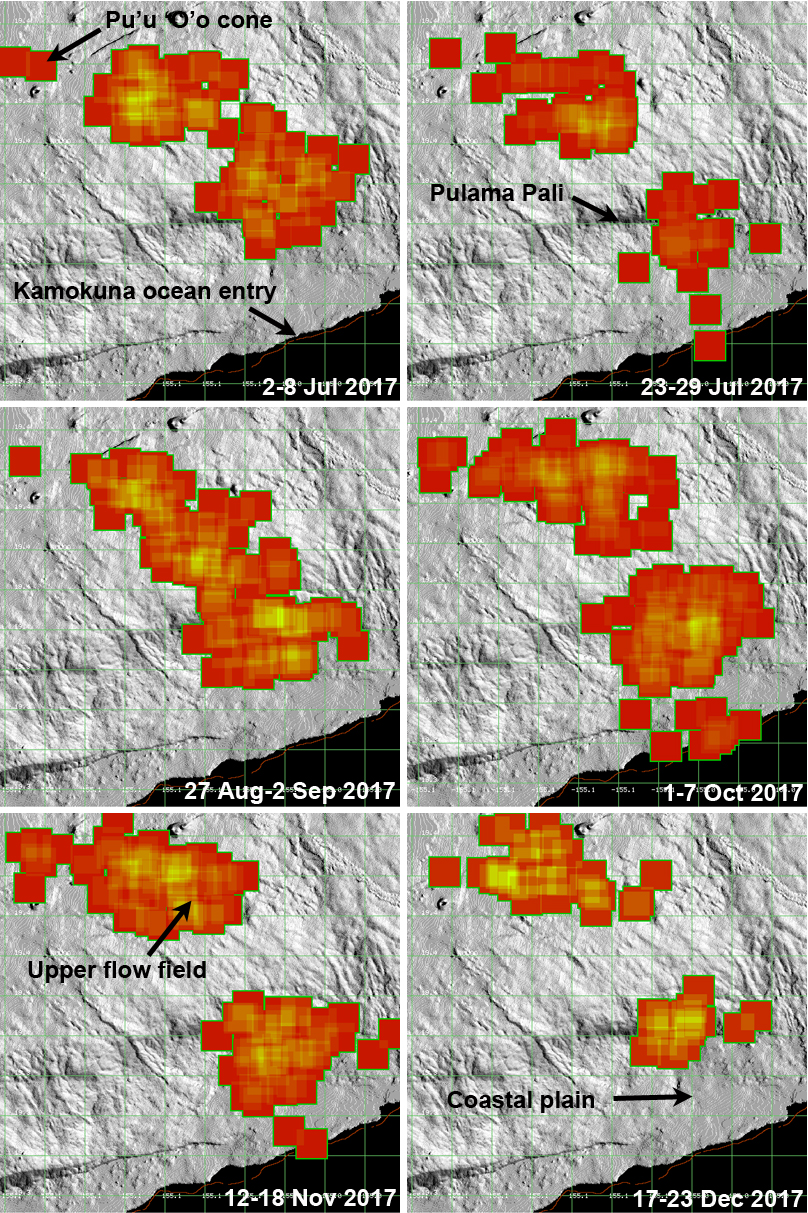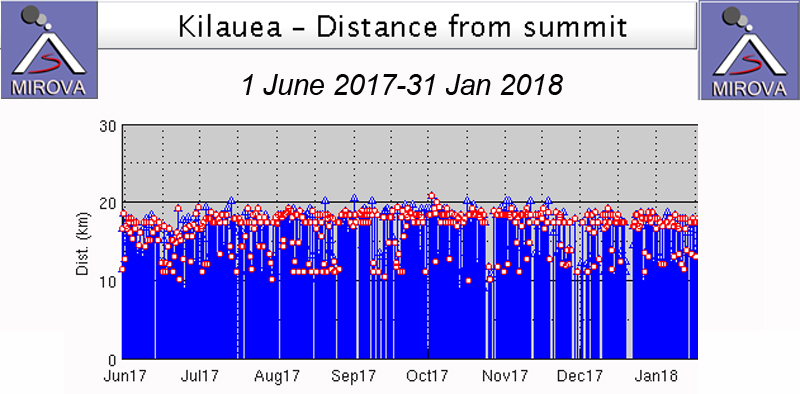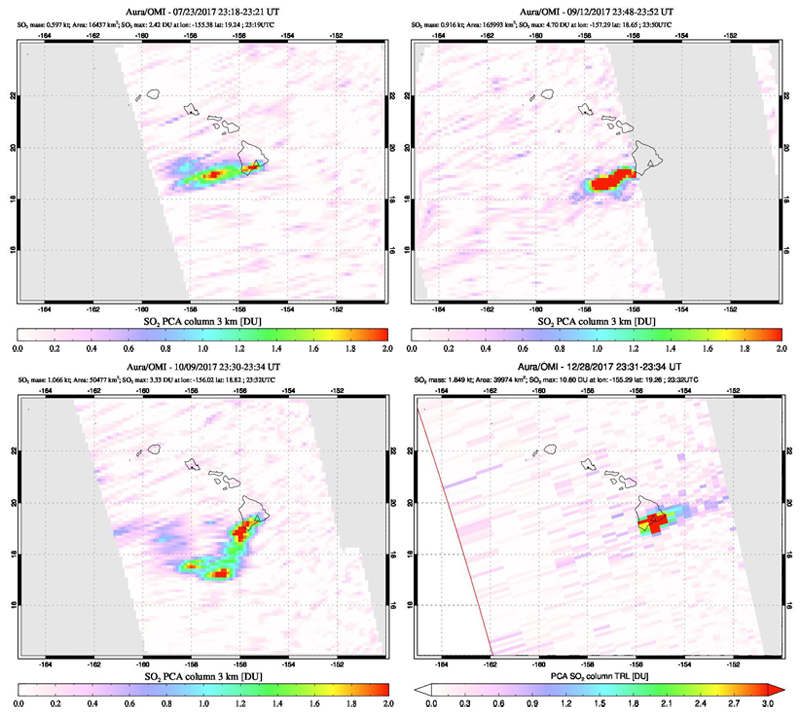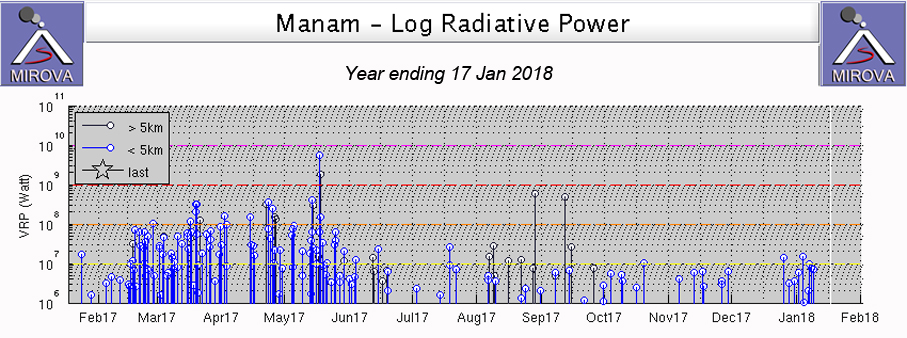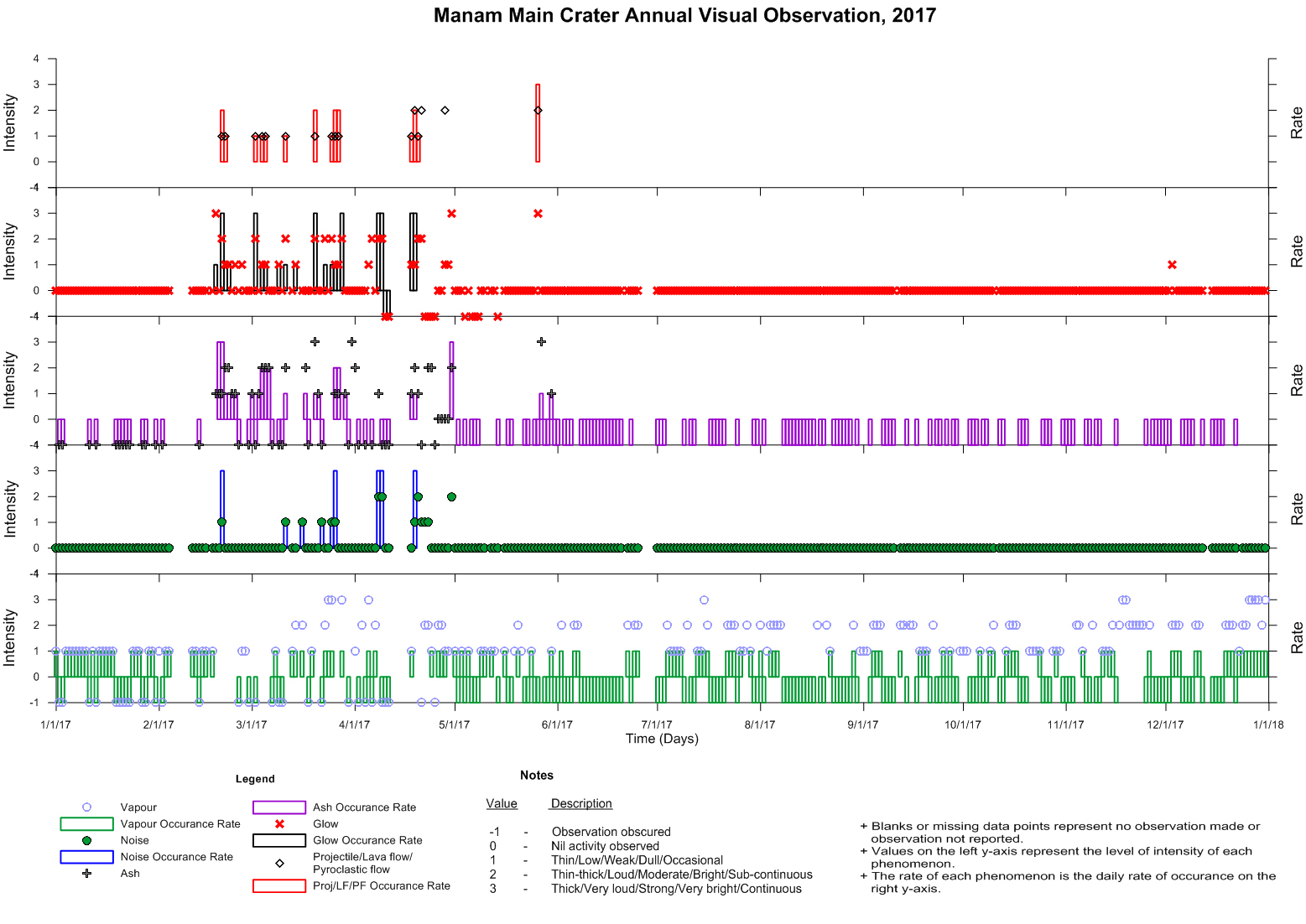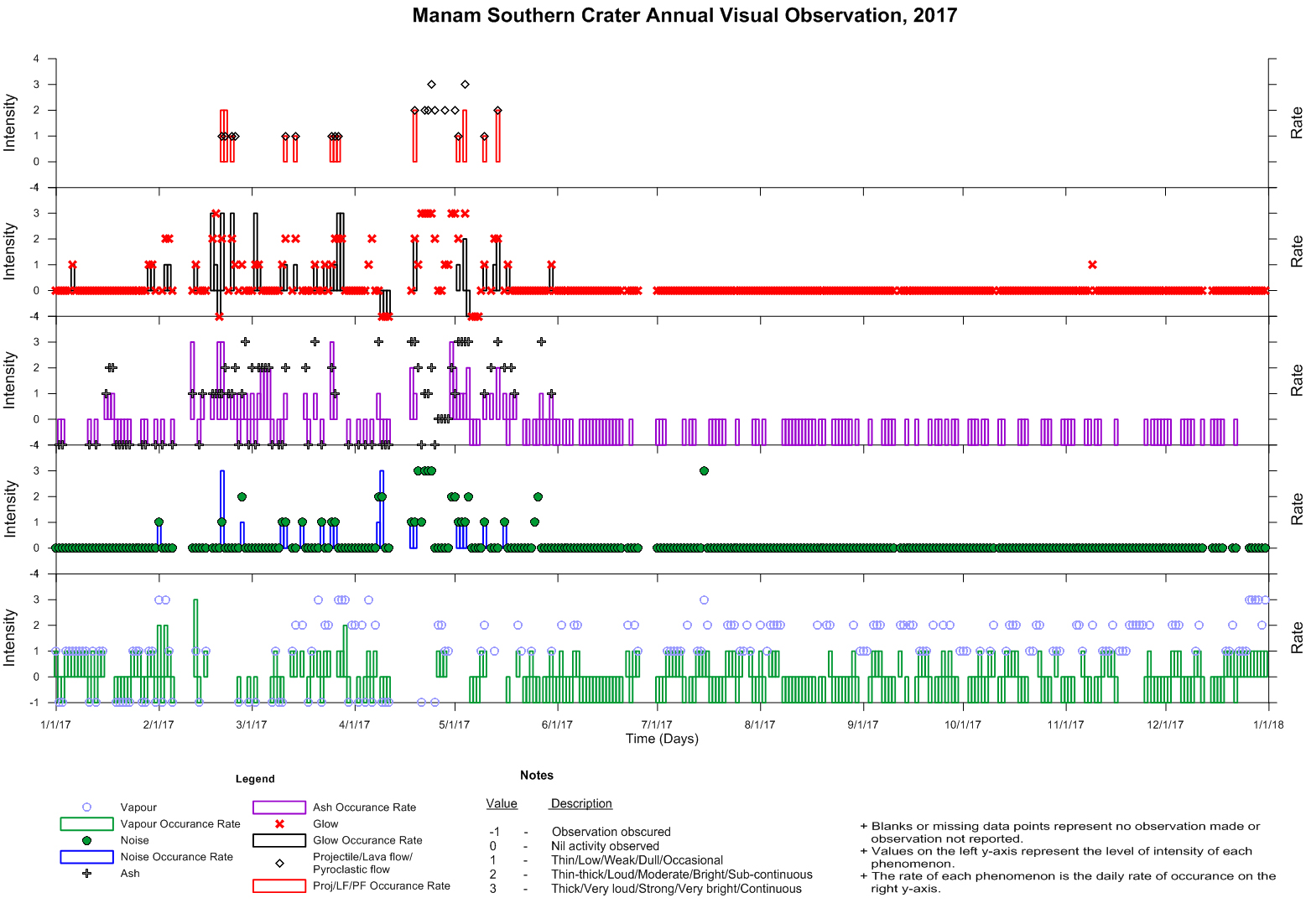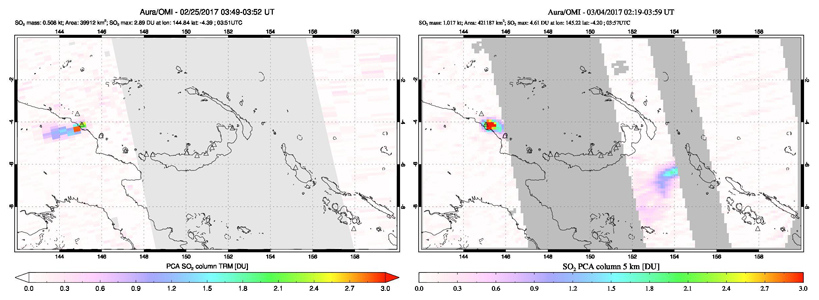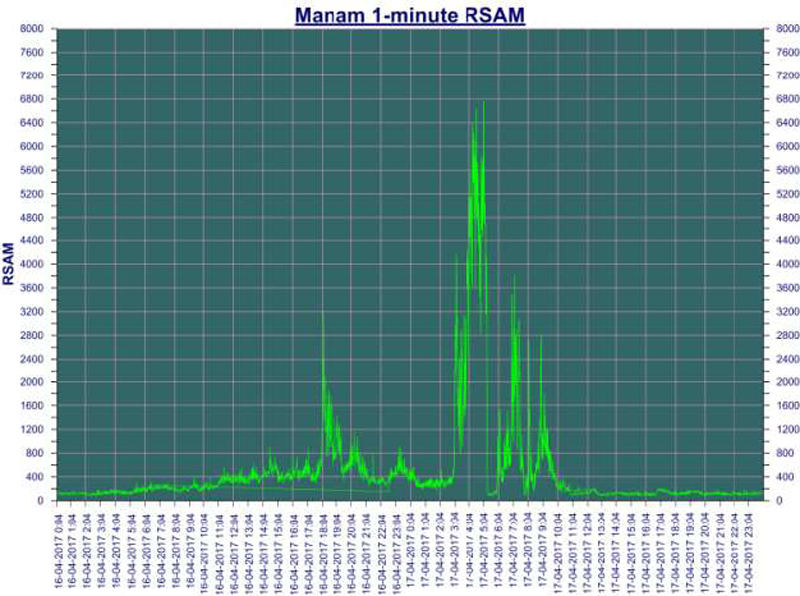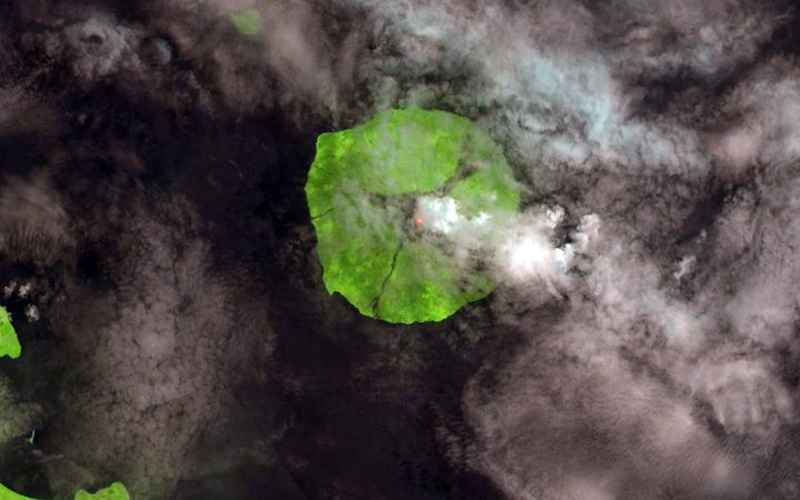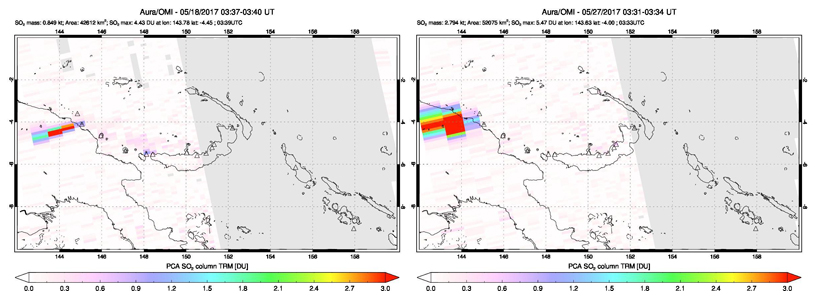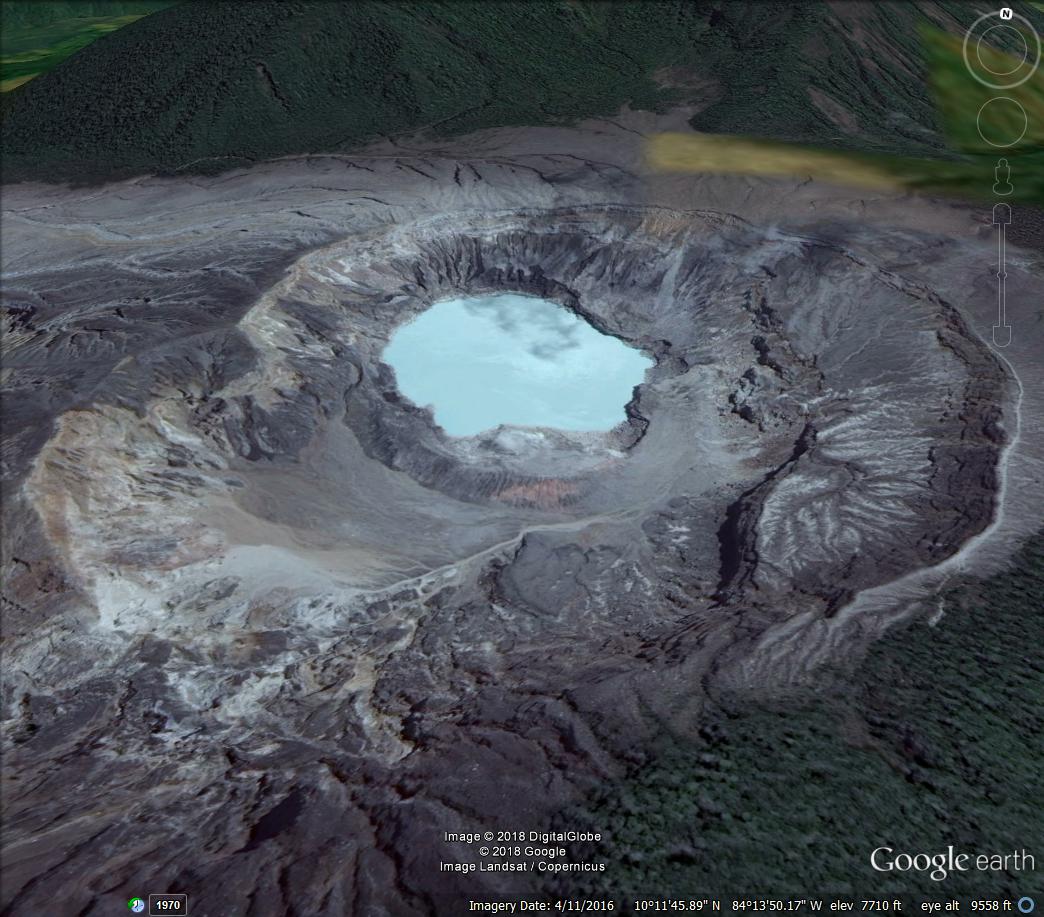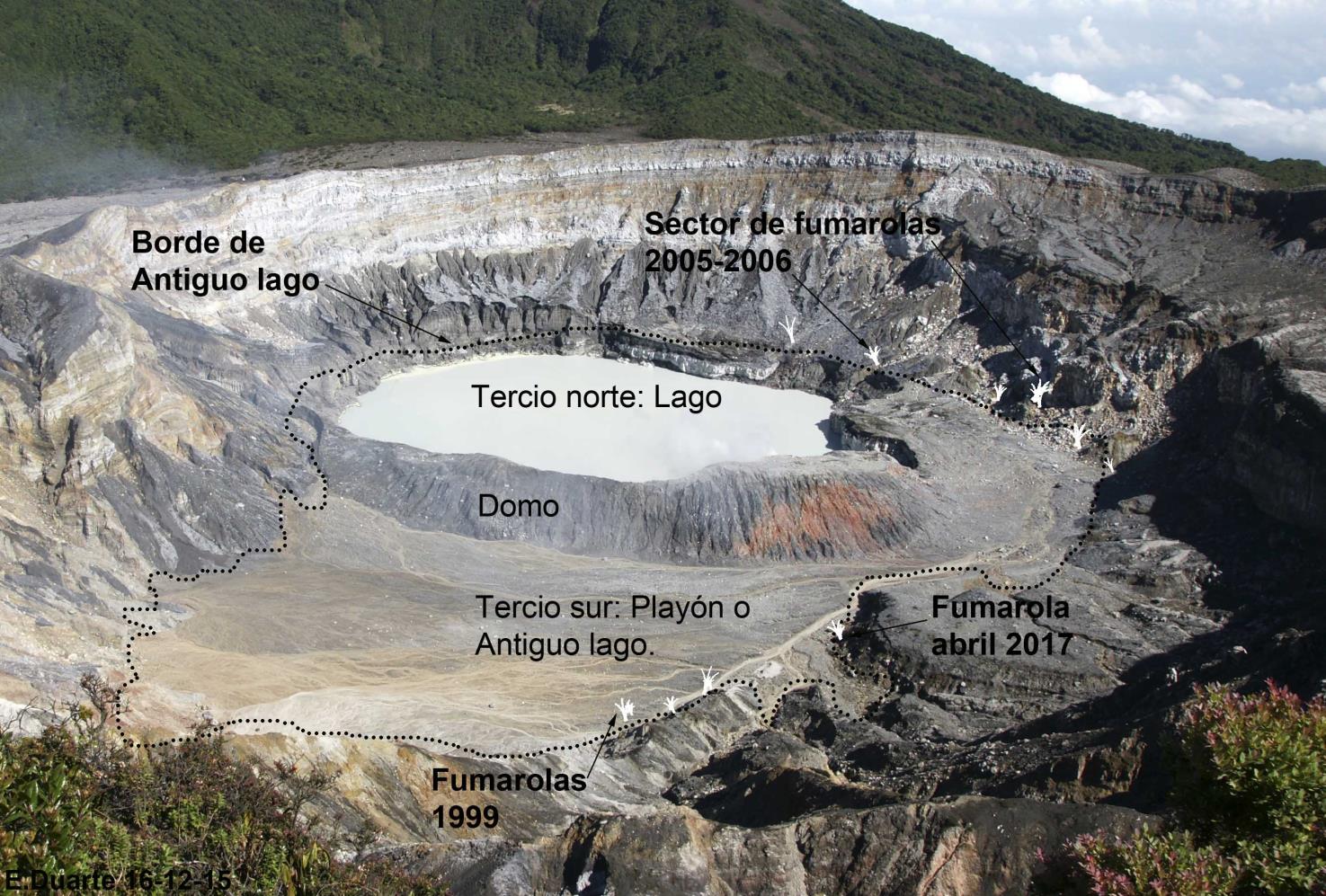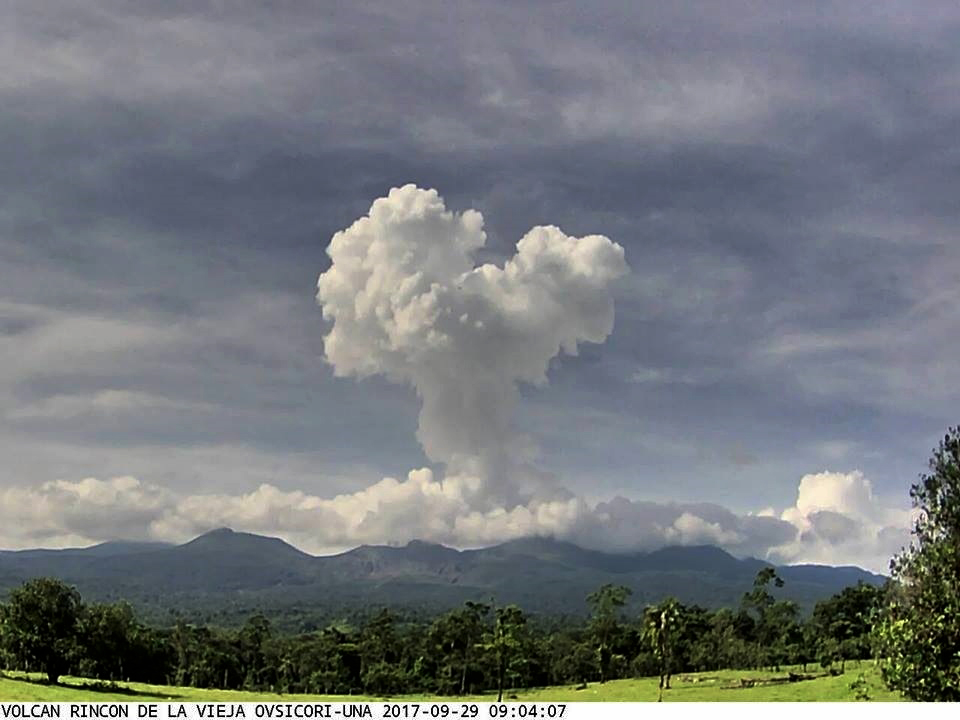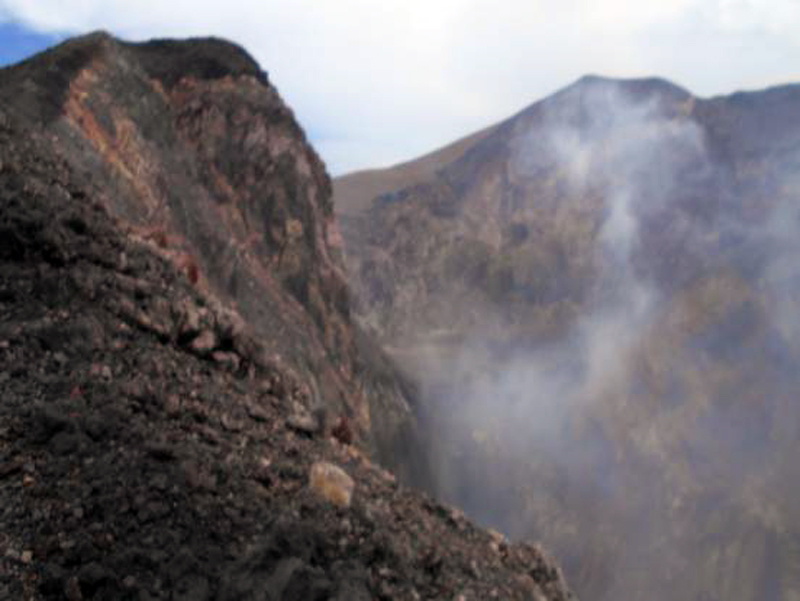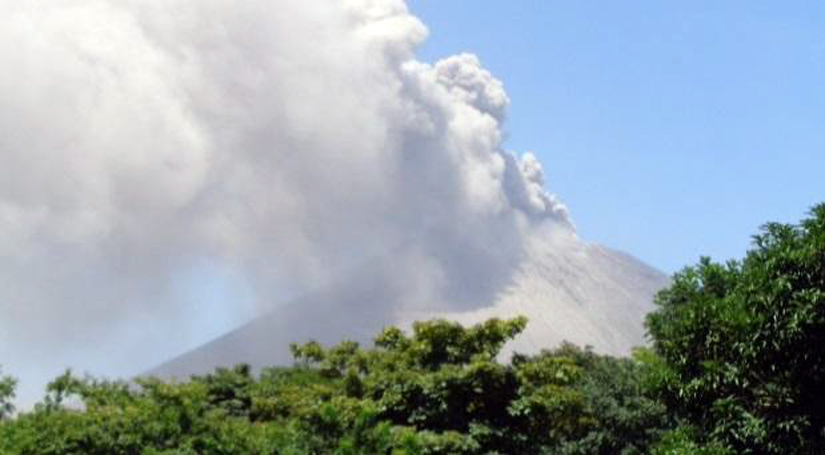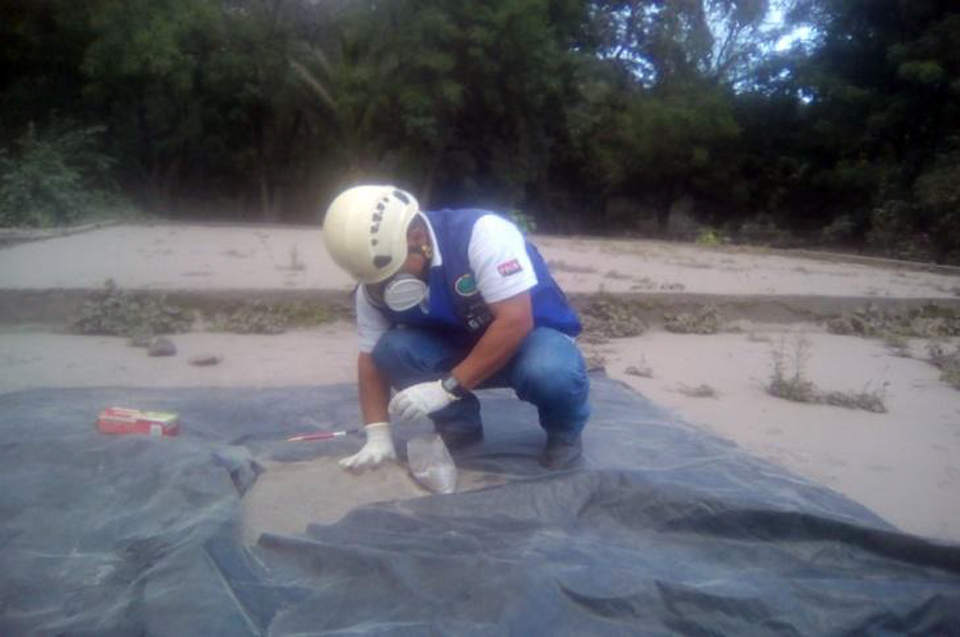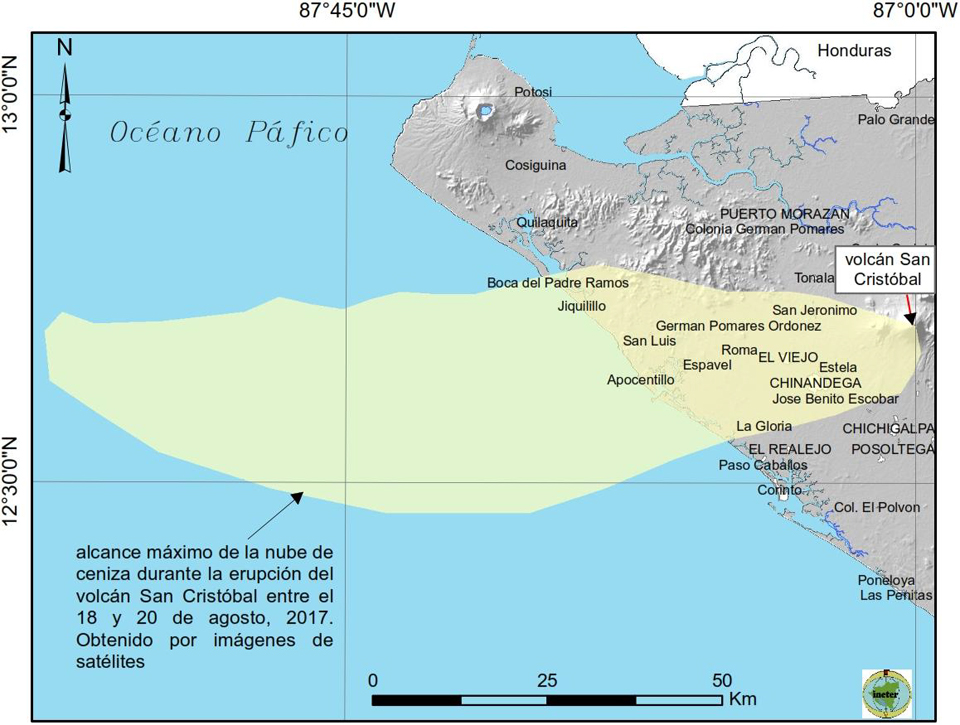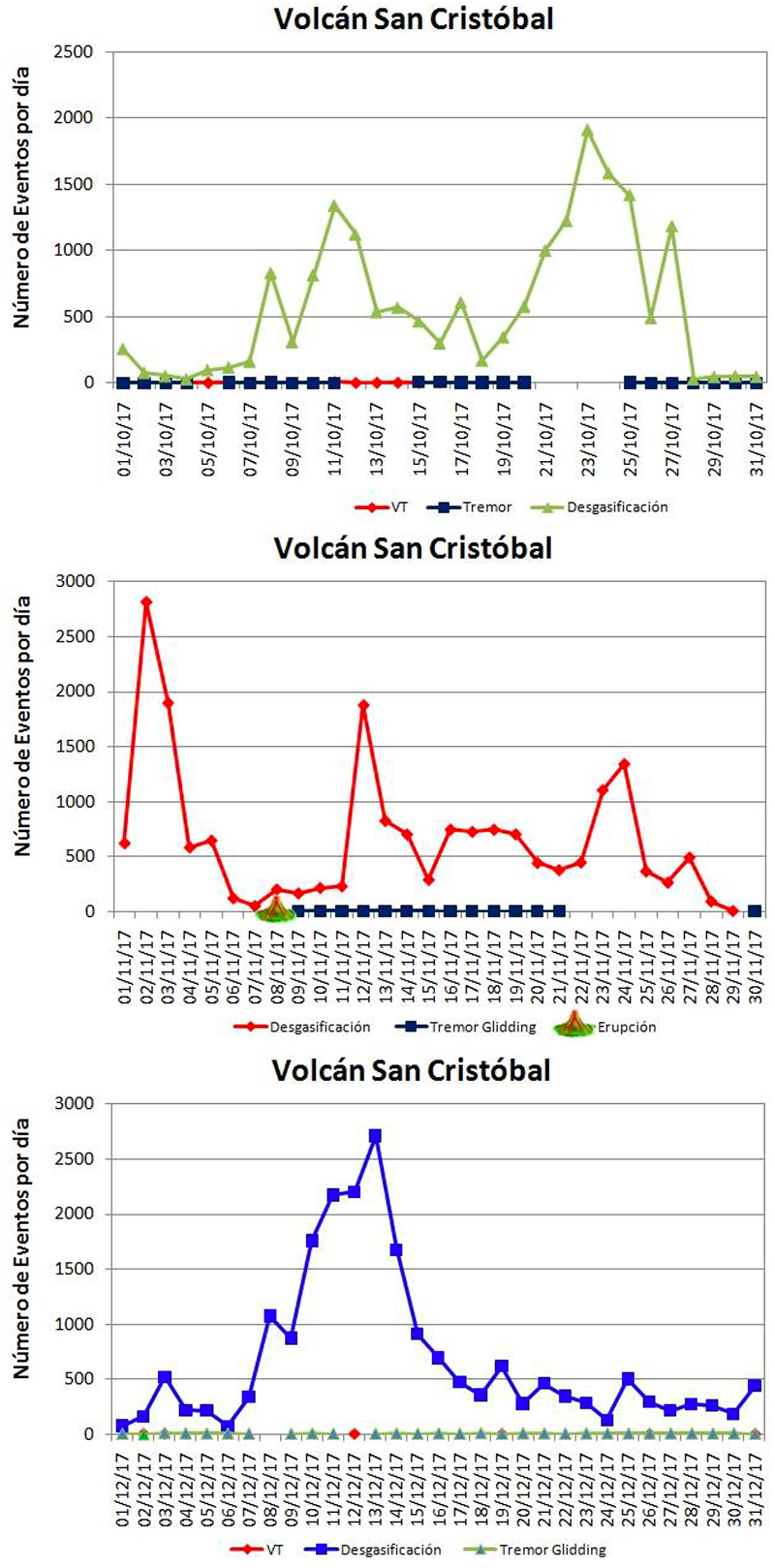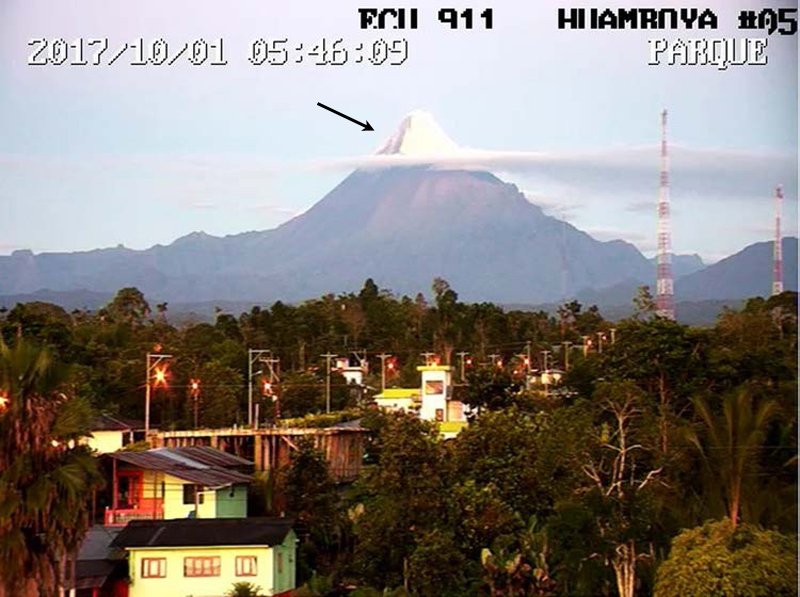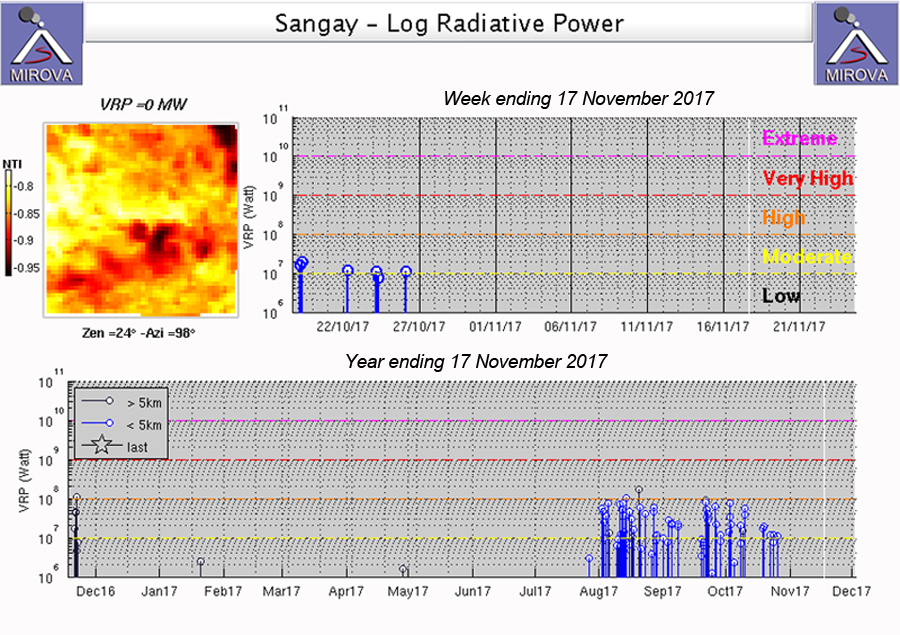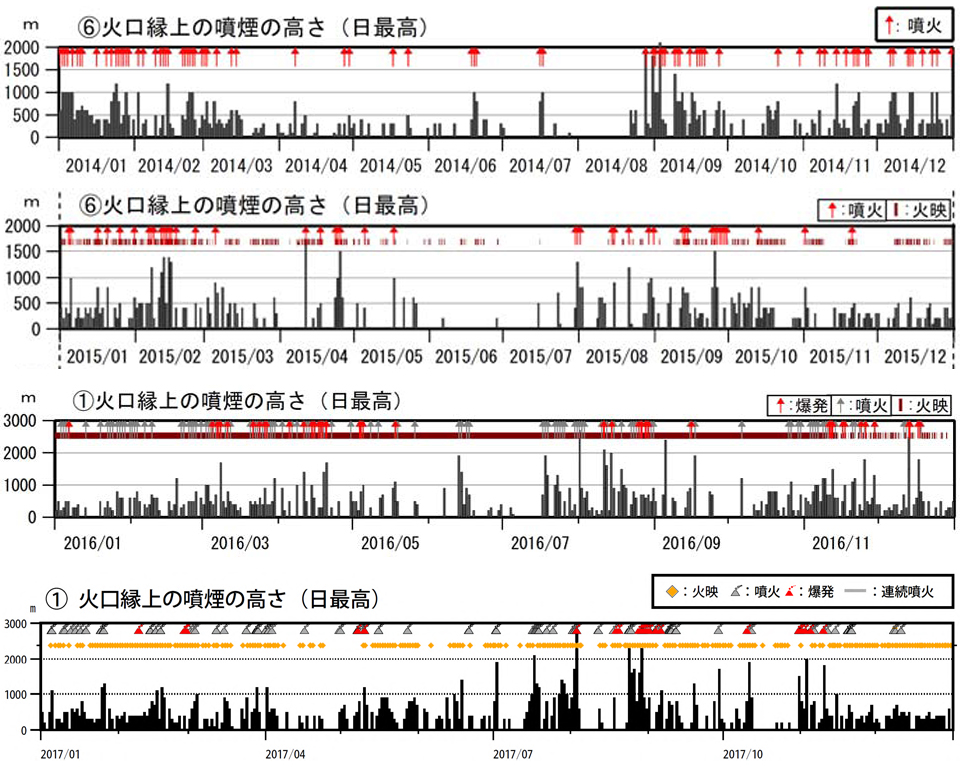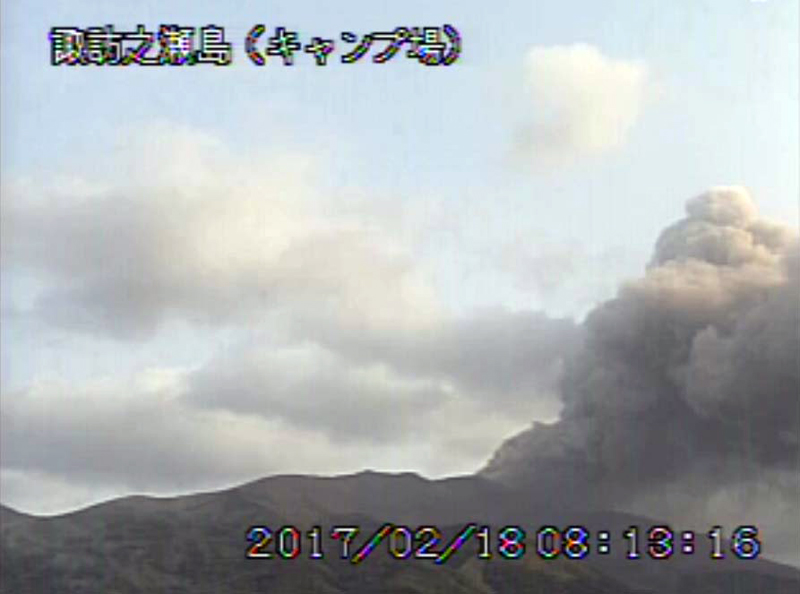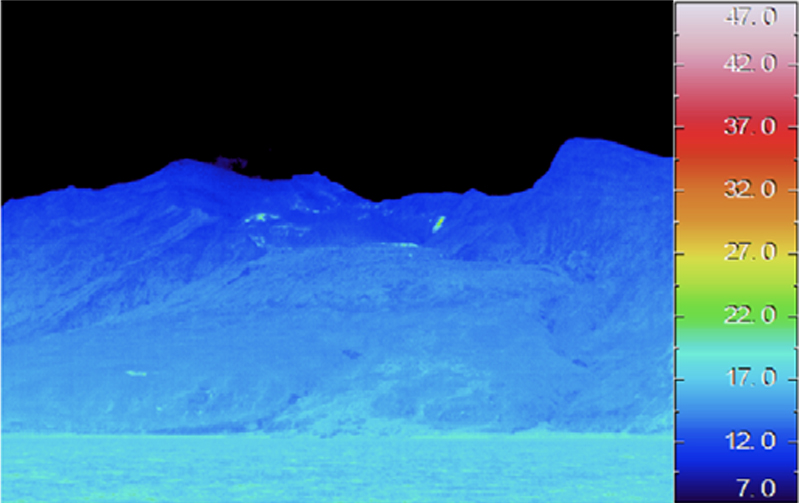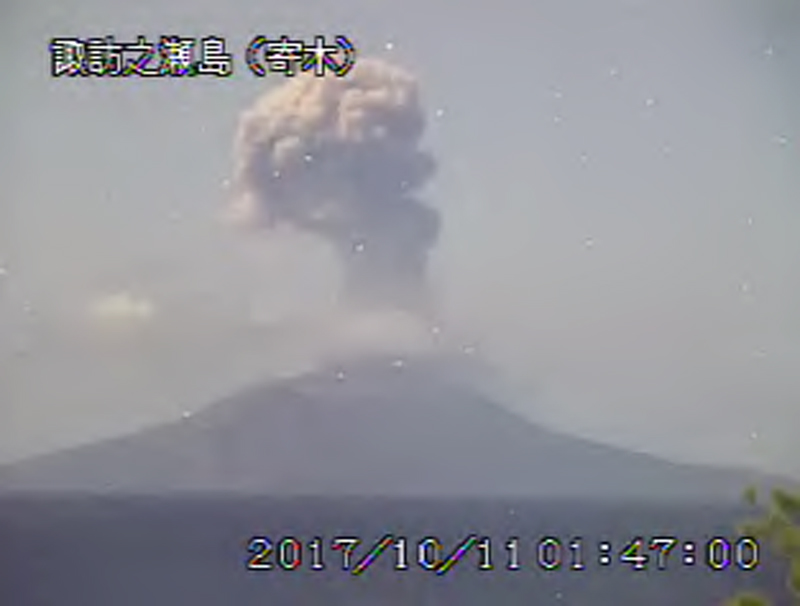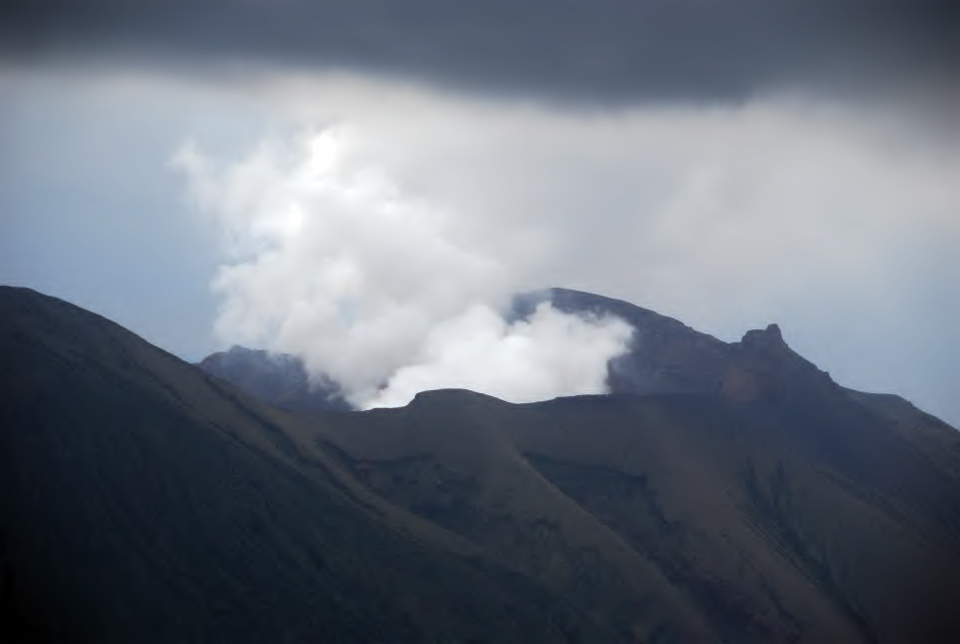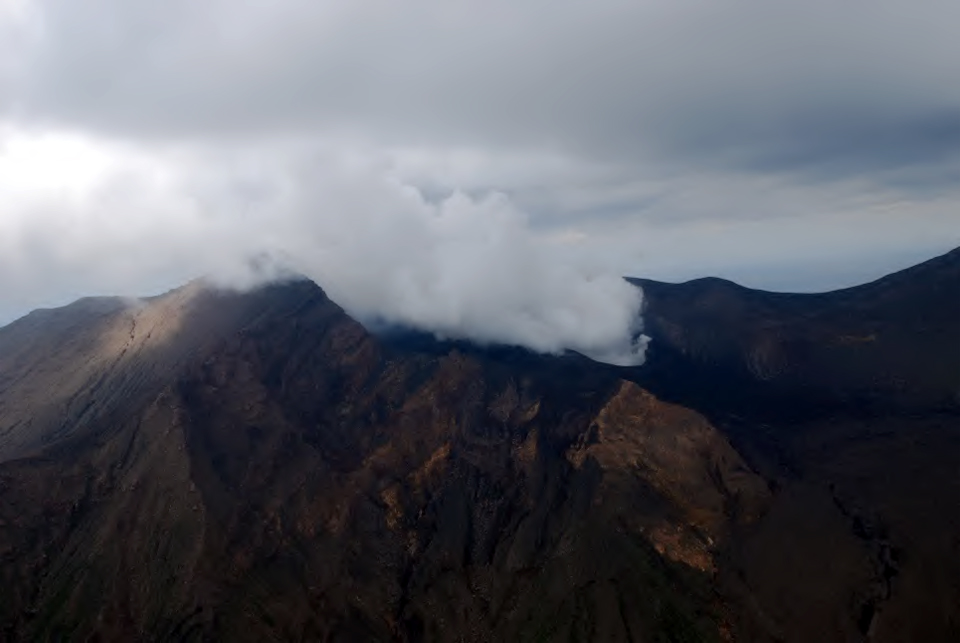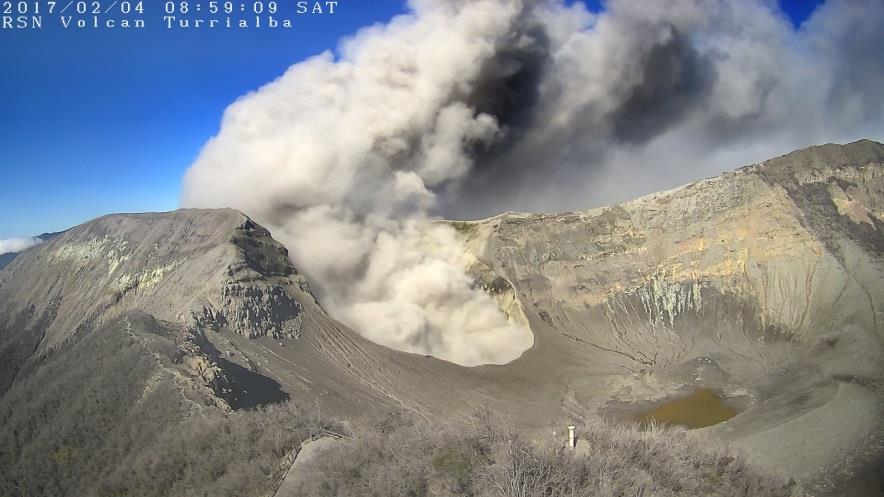Recently Published Bulletin Reports
Erebus (Antarctica) Lava lake remains active; most thermal alerts recorded since 2019
Rincon de la Vieja (Costa Rica) Frequent phreatic explosions during July-December 2023
Bezymianny (Russia) Explosion on 18 October 2023 sends ash plume 8 km high; lava flows and incandescent avalanches
Kilauea (United States) Low-level lava effusions in the lava lake at Halema’uma’u during July-December 2022
Nyamulagira (DR Congo) Lava flows and thermal activity during May-October 2023
Bagana (Papua New Guinea) Explosions, ash plumes, ashfall, and lava flows during April-September 2023
Mayon (Philippines) Lava flows, pyroclastic flows, ash emissions, and seismicity during April-September 2023
Nishinoshima (Japan) Eruption plumes and gas-and-steam plumes during May-August 2023
Krakatau (Indonesia) White gas-and-steam plumes and occasional ash plumes during May-August 2023
Villarrica (Chile) Strombolian activity, gas-and-ash emissions, and crater incandescence during April-September 2023
Merapi (Indonesia) Frequent incandescent avalanches during April-September 2023
Ebeko (Russia) Moderate explosive activity with ash plumes continued during June-November 2023
Erebus (Antarctica) — January 2024  Cite this Report
Cite this Report
Erebus
Antarctica
77.53°S, 167.17°E; summit elev. 3794 m
All times are local (unless otherwise noted)
Lava lake remains active; most thermal alerts recorded since 2019
The lava lake in the summit crater of Erebus has been active since at least 1972. Located in Antarctica overlooking the McMurdo Station on Ross Island, it is the southernmost active volcano on the planet. Because of the remote location, activity is primarily monitored by satellites. This report covers activity during 2023.
The number of thermal alerts recorded by the Hawai'i Institute of Geophysics and Planetology’s MODVOLC Thermal Alerts System increased considerably in 2023 compared to the years 2020-2022 (table 9). In contrast to previous years, the MODIS instruments aboard the Aqua and Terra satellites captured data from Erebus every month during 2023. Consistent with previous years, the lowest number of anomalous pixels were recorded in January, November, and December.
Table 9. Number of monthly MODIS-MODVOLC thermal alert pixels recorded at Erebus during 2017-2023. See BGVN 42:06 for data from 2000 through 2016. The table was compiled using data provided by the HIGP – MODVOLC Thermal Alerts System.
| Year |
Jan |
Feb |
Mar |
Apr |
May |
Jun |
Jul |
Aug |
Sep |
Oct |
Nov |
Dec |
SUM |
| 2017 |
0 |
21 |
9 |
0 |
0 |
1 |
11 |
61 |
76 |
52 |
0 |
3 |
234 |
| 2018 |
0 |
21 |
58 |
182 |
55 |
17 |
137 |
172 |
103 |
29 |
0 |
0 |
774 |
| 2019 |
2 |
21 |
162 |
151 |
55 |
56 |
75 |
53 |
29 |
19 |
1 |
0 |
624 |
| 2020 |
0 |
2 |
16 |
18 |
4 |
4 |
1 |
3 |
18 |
3 |
1 |
6 |
76 |
| 2021 |
0 |
9 |
1 |
0 |
2 |
56 |
46 |
47 |
35 |
52 |
5 |
3 |
256 |
| 2022 |
1 |
13 |
55 |
22 |
15 |
32 |
39 |
19 |
31 |
11 |
0 |
0 |
238 |
| 2023 |
2 |
33 |
49 |
82 |
41 |
32 |
70 |
64 |
42 |
17 |
5 |
11 |
448 |
Sentinel-2 infrared images showed one or two prominent heat sources within the summit crater, accompanied by adjacent smaller sources, similar to recent years (see BGVN 46:01, 47:02, and 48:01). A unique image was obtained on 25 November 2023 by the OLI-2 (Operational Land Imager-2) on Landsat 9, showing the upper part of the volcano surrounded by clouds (figure 32).
Geologic Background. Mount Erebus, the world's southernmost historically active volcano, overlooks the McMurdo research station on Ross Island. It is the largest of three major volcanoes forming the crudely triangular Ross Island. The summit of the dominantly phonolitic volcano has been modified by one or two generations of caldera formation. A summit plateau at about 3,200 m elevation marks the rim of the youngest caldera, which formed during the late-Pleistocene and within which the modern cone was constructed. An elliptical 500 x 600 m wide, 110-m-deep crater truncates the summit and contains an active lava lake within a 250-m-wide, 100-m-deep inner crater; other lava lakes are sometimes present. The glacier-covered volcano was erupting when first sighted by Captain James Ross in 1841. Continuous lava-lake activity with minor explosions, punctuated by occasional larger Strombolian explosions that eject bombs onto the crater rim, has been documented since 1972, but has probably been occurring for much of the volcano's recent history.
Information Contacts: Hawai'i Institute of Geophysics and Planetology (HIGP) - MODVOLC Thermal Alerts System, School of Ocean and Earth Science and Technology (SOEST), Univ. of Hawai'i, 2525 Correa Road, Honolulu, HI 96822, USA (URL: http://modis.higp.hawaii.edu/); Copernicus Browser, Copernicus Data Space Ecosystem, European Space Agency (URL: https://dataspace.copernicus.eu/browser/); NASA Earth Observatory, EOS Project Science Office, NASA Goddard Space Flight Center, Goddard, Maryland, USA (URL: https://earthobservatory.nasa.gov/images/152134/erebus-breaks-through).
Rincon de la Vieja (Costa Rica) — January 2024  Cite this Report
Cite this Report
Rincon de la Vieja
Costa Rica
10.83°N, 85.324°W; summit elev. 1916 m
All times are local (unless otherwise noted)
Frequent phreatic explosions during July-December 2023
Rincón de la Vieja is a volcanic complex in Costa Rica with a hot convecting acid lake that exhibits frequent weak phreatic explosions, gas-and-steam emissions, and occasional elevated sulfur dioxide levels (BGVN 45:10, 46:03, 46:11). The current eruption period began June 2021. This report covers activity during July-December 2023 and is based on weekly bulletins and occasional daily reports from the Observatorio Vulcanologico Sismologica de Costa Rica-Universidad Nacional (OVSICORI-UNA).
Numerous weak phreatic explosions continued during July-December 2023, along with gas-and-steam emissions and plumes that rose as high as 3 km above the crater rim. Many weekly OVSICORI-UNA bulletins included the previous week's number of explosions and emissions (table 9). For many explosions, the time of explosion was given (table 10). Frequent seismic activity (long-period earthquakes, volcano-tectonic earthquakes, and tremor) accompanied the phreatic activity.
Table 9. Number of reported weekly phreatic explosions and gas-and-steam emissions at Rincón de la Vieja, July-December 2023. Counts are reported for the week before the Weekly Bulletin date; not all reports included these data. Courtesy of OVSICORI-UNA.
| OVSICORI Weekly Bulletin |
Number of explosions |
Number of emissions |
| 28 Jul 2023 |
6 |
14 |
| 4 Aug 2023 |
10 |
12 |
| 1 Sep 2023 |
13 |
11 |
| 22 Sep 2023 |
12 |
13 |
| 29 Sep 2023 |
6 |
11 |
| 6 Oct 2023 |
12 |
5 |
| 13 Oct 2023 |
7 |
9 |
| 20 Oct 2023 |
1 |
15 |
| 27 Oct 2023 |
3 |
23 |
| 3 Nov 2023 |
3 |
10 |
| 17 Nov 2023 |
0 |
Some |
| 24 Nov 2023 |
0 |
14 |
| 8 Dec 2023 |
4 |
16 |
| 22 Dec 2023 |
8 |
18 |
Table 10. Summary of activity at Rincón de la Vieja during July-December 2023. Weak phreatic explosions and gas emissions are noted where the time of explosion was indicated in the weekly or daily bulletins. Height of plumes or emissions are distance above the crater rim. Courtesy of OVSICORI-UNA.
| Date |
Time |
Description of Activity |
| 1 Jul 2023 |
0156 |
Explosion. |
| 2 Jul 2023 |
0305 |
Explosion. |
| 4 Jul 2023 |
0229, 0635 |
Event at 0635 produced a gas-and-steam plume that rose 700 m and drifted W; seen by residents in Liberia (21 km SW). |
| 9 Jul 2023 |
1843 |
Explosion. |
| 21 Jul 2023 |
0705 |
Explosion. |
| 26 Jul 2023 |
1807 |
Explosion. |
| 28 Jul 2023 |
0802 |
Explosion generated a gas-and-steam plume that rose 500 m. |
| 30 Jul 2023 |
1250 |
Explosion. |
| 31 Jul 2023 |
2136 |
Explosion. |
| 11 Aug 2023 |
0828 |
Explosion. |
| 18 Aug 2023 |
1304 |
Explosion. |
| 21 Aug 2023 |
1224 |
Explosion generated gas-and-steam plumes rose 500-600 m. |
| 22 Aug 2023 |
0749 |
Explosion generated gas-and-steam plumes rose 500-600 m. |
| 24 Aug 2023 |
1900 |
Explosion. |
| 25 Aug 2023 |
0828 |
Event produced a steam-and-gas plume that rose 3 km and drifted NW. |
| 27-28 Aug 2023 |
0813 |
Four small events; the event at 0813 on 28 August lasted two minutes and generated a steam-and-gas plume that rose 2.5 km. |
| 1 Sep 2023 |
1526 |
Explosion generated plume that rose 2 km and ejected material onto the flanks. |
| 2-3 Sep 2023 |
- |
Small explosions detected in infrasound data. |
| 4 Sep 2023 |
1251 |
Gas-and-steam plume rose 1 km and drifted W. |
| 7 Nov 2023 |
1113 |
Explosion. |
| 8 Nov 2023 |
0722 |
Explosion. |
| 12 Nov 2023 |
0136 |
Small gas emissions. |
| 14 Nov 2023 |
0415 |
Small gas emissions. |
According to OVSICORI-UNA, during July-October the average weekly sulfur dioxide (SO2) flux ranged from 68 to 240 tonnes/day. However, in mid-November the flux increased to as high as 334 tonnes/day, the highest value measured in recent years. The high SO2 flux in mid-November was also detected by the TROPOMI instrument on the Sentinel-5P satellite (figure 43).
Geologic Background. Rincón de la Vieja, the largest volcano in NW Costa Rica, is a remote volcanic complex in the Guanacaste Range. The volcano consists of an elongated, arcuate NW-SE-trending ridge constructed within the 15-km-wide early Pleistocene Guachipelín caldera, whose rim is exposed on the south side. Sometimes known as the "Colossus of Guanacaste," it has an estimated volume of 130 km3 and contains at least nine major eruptive centers. Activity has migrated to the SE, where the youngest-looking craters are located. The twin cone of Santa María volcano, the highest peak of the complex, is located at the eastern end of a smaller, 5-km-wide caldera and has a 500-m-wide crater. A Plinian eruption producing the 0.25 km3 Río Blanca tephra about 3,500 years ago was the last major magmatic eruption. All subsequent eruptions, including numerous historical eruptions possibly dating back to the 16th century, have been from the prominent active crater containing a 500-m-wide acid lake located ENE of Von Seebach crater.
Information Contacts: Observatorio Vulcanológico Sismológica de Costa Rica-Universidad Nacional (OVSICORI-UNA), Apartado 86-3000, Heredia, Costa Rica (URL: http://www.ovsicori.una.ac.cr/); NASA Global Sulfur Dioxide Monitoring Page, Atmospheric Chemistry and Dynamics Laboratory, NASA Goddard Space Flight Center (NASA/GSFC), 8800 Greenbelt Road, Goddard MD 20771, USA (URL: https://so2.gsfc.nasa.gov/).
Bezymianny (Russia) — November 2023  Cite this Report
Cite this Report
Bezymianny
Russia
55.972°N, 160.595°E; summit elev. 2882 m
All times are local (unless otherwise noted)
Explosion on 18 October 2023 sends ash plume 8 km high; lava flows and incandescent avalanches
Bezymianny, located on Russia’s Kamchatka Peninsula, has had eruptions since 1955 characterized by dome growth, explosions, pyroclastic flows, ash plumes, and ashfall. Activity during November 2022-April 2023 included gas-and-steam emissions, lava dome collapses generating avalanches, and persistent thermal activity. Similar eruptive activity continued from May through October 2023, described here based on information from weekly and daily reports of the Kamchatka Volcano Eruptions Response Team (KVERT), notices from Tokyo VAAC (Volcanic Ash Advisory Center), and from satellite data.
Overall activity decreased after the strong period of activity in late March through April 2023, which included ash explosions during 29 March and 7-8 April 2023 that sent plumes as high as 10-12 km altitude, along with dome growth and lava flows (BGVN 48:05). This reduced activity can be seen in the MIROVA thermal detection system graph (figure 56), which was consistent with data from the MODVOLC thermal detection system and with Sentinel-2 satellite images that showed persistent hotspots in the summit crater when conditions allowed observations. A renewed period of strong activity began in mid-October 2023.
Activity increased significantly on 17 October 2023 when large collapses began during 0700-0830 on the E flanks of the lava dome and continued to after 0930 the next day (figure 57). Ash plumes rose to an altitude of 4.5-5 km, extending 220 km NNE by 18 October. A large explosion at 1630 on 18 October produced an ash plume that rose to an altitude of 11 km (8 km above the summit) and drifted NNE and then NW, extending 900 km NW within two days at an altitude of 8 km. Minor ashfall was noted in Kozyrevsk (45 km WNW). At 0820 on 20 October an ash plume was identified in satellite images drifting 100 km ENE at altitudes of 4-4.5 km.
Lava flows and hot avalanches from the dome down the SE flank continued over the next few days, including 23 October when clear conditions allowed good observations (figures 58 and 59). A large thermal anomaly was observed over the volcano through 24 October, and in the summit crater on 30 October (figure 60). Strong fumarolic activity continued, with numerous avalanches and occasional incandescence. By the last week of October, volcanic activity had decreased to a level consistent with that earlier in the reporting period.
Aviation warnings were frequently updated during 17-20 October. KVERT issued a Volcano Observatory Notice for Aviation (VONA) on 17 October at 1419 and 1727 (0219 and 0527 UTC) raising the Aviation Color Code (ACC) from Yellow to Orange (second highest level). The next day, KVERT issued a VONA at 1705 (0505 UTC) raising the ACC to Red (highest level) but lowered it back to Orange at 2117 (0917 UTC). After another decrease to Yellow and back to Orange, the ACC was reduced to Yellow on 20 October at 1204 (0004 UTC). In addition, the Tokyo VAAC issued a series of Volcanic Ash Advisories beginning on 16 October and continuing through 30 October.
Geologic Background. The modern Bezymianny, much smaller than its massive neighbors Kamen and Kliuchevskoi on the Kamchatka Peninsula, was formed about 4,700 years ago over a late-Pleistocene lava-dome complex and an edifice built about 11,000-7,000 years ago. Three periods of intensified activity have occurred during the past 3,000 years. The latest period, which was preceded by a 1,000-year quiescence, began with the dramatic 1955-56 eruption. This eruption, similar to that of St. Helens in 1980, produced a large open crater that was formed by collapse of the summit and an associated lateral blast. Subsequent episodic but ongoing lava-dome growth, accompanied by intermittent explosive activity and pyroclastic flows, has largely filled the 1956 crater.
Information Contacts: Kamchatka Volcanic Eruptions Response Team (KVERT), Far Eastern Branch, Russian Academy of Sciences, 9 Piip Blvd., Petropavlovsk-Kamchatsky, 683006, Russia (URL: http://www.kscnet.ru/ivs/kvert/); Kamchatka Volcanological Station, Kamchatka Branch of Geophysical Survey, (KB GS RAS), Klyuchi, Kamchatka Krai, Russia (URL: http://volkstat.ru/); Tokyo Volcanic Ash Advisory Center (VAAC), 1-3-4 Otemachi, Chiyoda-ku, Tokyo 100-8122, Japan (URL: http://ds.data.jma.go.jp/svd/vaac/data/); Hawai'i Institute of Geophysics and Planetology (HIGP) - MODVOLC Thermal Alerts System, School of Ocean and Earth Science and Technology (SOEST), Univ. of Hawai'i, 2525 Correa Road, Honolulu, HI 96822, USA (URL: http://modis.higp.hawaii.edu/); MIROVA (Middle InfraRed Observation of Volcanic Activity), a collaborative project between the Universities of Turin and Florence (Italy) supported by the Centre for Volcanic Risk of the Italian Civil Protection Department (URL: http://www.mirovaweb.it/); Copernicus Browser, Copernicus Data Space Ecosystem, European Space Agency (URL: https://dataspace.copernicus.eu/browser/).chr
Kilauea (United States) — January 2023  Cite this Report
Cite this Report
Kilauea
United States
19.421°N, 155.287°W; summit elev. 1222 m
All times are local (unless otherwise noted)
Low-level lava effusions in the lava lake at Halema’uma’u during July-December 2022
Kīlauea is the southeastern-most volcano in Hawaii and overlaps the E flank of the Mauna Loa volcano. Its East Rift Zone (ERZ) has been intermittently active for at least 2,000 years. An extended eruption period began in January 1983 and was characterized by open lava lakes and lava flows from the summit caldera and the East Rift Zone. During May 2018 magma migrated into the Lower East Rift Zone (LERZ) and opened 24 fissures along a 6-km-long NE-trending fracture zone that produced lava flows traveling in multiple directions. As lava emerged from the fissures, the lava lake at Halema'uma'u drained and explosions sent ash plumes to several kilometers altitude (BGVN 43:10).
The current eruption period started during September 2021 and has recently been characterized by lava effusions, spatter, and sulfur dioxide emissions in the active Halema’uma’u lava lake (BGVN 47:08). Lava effusions, some spatter, and sulfur dioxide emissions have continued during this reporting period of July through December 2022 using daily reports, volcanic activity notices, and abundant photo, map, and video data from the US Geological Survey's (USGS) Hawaiian Volcano Observatory (HVO).
Summary of activity during July-December 2022. Low-level effusions have continued at the western vent of the Halema’uma’u crater during July through early December 2022. Occasional weak ooze-outs (also called lava break outs) would occur along the margins of the crater floor. The overall level of the active lava lake throughout the reporting period gradually increased due to infilling, however it stagnated in mid-September (table 13). During September through November, activity began to decline, though lava effusions persisted at the western vent. By 9 December, the active part of the lava lake had completely crusted over, and incandescence was no longer visible.
Table 13. Summary of measurements taken during overflights at Kīlauea that show a gradual increase in the active lava lake level and the volume of lava effused since 29 September 2021. Lower activity was reported during September-October. Data collected during July-December 2022. Courtesy of HVO.
| Date: |
Level of the active lava lake (m): |
Cumulative volume of lava effused (million cubic meters): |
| 7 Jul 2022 |
130 |
95 |
| 19 Jul 2022 |
133 |
98 |
| 4 Aug 2022 |
136 |
102 |
| 16 Aug 2022 |
137 |
104 |
| 12 Sep 2022 |
143 |
111 |
| 5 Oct 2022 |
143 |
111 |
| 28 Oct 2022 |
143 |
111 |
Activity during July 2022. Lava effusions were reported from the western vent in the Halema’uma’u crater, along with occasional weak ooze-outs along the margins of the crater floor. The height of the lava lake was variable due to deflation-inflation tilt events; for example, the lake level dropped approximately 3-4 m during a summit deflation-inflation event reported on 1 July. Webcam images taken during the night of 6-12 July showed intermittent low-level spattering at the western vent that rose less than 10 m above the vent (figure 519). Measurements made during an overflight on 7 July indicated that the crater floor was infilled about 130 m and that 95 million cubic meters of lava had been effused since 29 September 2021. A single, relatively small lava ooze-out was active to the S of the lava lake. Around midnight on 8 July there were two brief periods of lava overflow onto the lake margins. On 9 July lava ooze-outs were reported near the SE and NE edges of the crater floor and during 10-11 July they occurred near the E, NE, and NW edges. On 16 July crater incandescence was reported, though the ooze-outs and spattering were not visible. On 18 July overnight webcam images showed incandescence in the western vent complex and two ooze-outs were reported around 0000 and 0200 on 19 July. By 0900 there were active ooze-outs along the SW edge of the crater floor. Measurements made from an overflight on 19 July indicated that the crater floor was infilled about 133 m and 98 million cubic meters of lava had erupted since 29 September 2021 (figure 520). On 20 July around 1600 active ooze-outs were visible along the N edge of the crater, which continued through the next day. Extensive ooze-outs occurred along the W margin during 24 July until 1900; on 26 July minor ooze-outs were noted along the N margin. Minor spattering was visible on 29 July along the E margin of the lake. The sulfur dioxide emission rates ranged 650-2,800 tons per day (t/d), the higher of which was measured on 8 July (figure 519).
Activity during August 2022. The eruption continued in the Halema’uma’u crater at the western vent. According to HVO the lava in the active lake remained at the level of the bounding levees. Occasional minor ooze-outs were observed along the margins of the crater floor. Strong nighttime crater incandescence was visible after midnight on 6 August over the western vent cone. During 6-7 August scattered small lava lobes were active along the crater floor and incandescence persisted above the western vent through 9 August. During 7-9 August HVO reported a single lava effusion source was active along the NW margin of the crater floor. Measurements from an overflight on 4 August indicated that the crater floor was infilled about 136 m total and that 102 million cubic meters of lava had been erupted since the start of the eruption. Lava breakouts were reported along the N, NE, E, S, and W margins of the crater during 10-16 August. Another overflight survey conducted on 16 August indicated that the crater floor infilled about 137 m and 104 million cubic meters of lava had been erupted since September 2021. Measured sulfur dioxide emissions rates ranged 1,150-2,450 t/d, the higher of which occurred on 8 August.
Activity during September 2022. During September, lava effusion continued from the western vent into the active lava lake and onto the crater floor. Intermittent minor ooze-outs were reported through the month. A small ooze-out was visible on the W crater floor margin at 0220 on 2 September, which showed decreasing surface activity throughout the day, but remained active through 3 September. On 3 September around 1900 a lava outbreak occurred along the NW margin of the crater floor but had stopped by the evening of 4 September. Field crews monitoring the summit lava lake on 9 September observed spattering on the NE margin of the lake that rose no higher than 10 m, before falling back onto the lava lake crust (figure 521). Overflight measurements on 12 September indicated that the crater floor was infilled a total of 143 m and 111 million cubic meters of lava had been erupted since September 2021. Extensive breakouts in the W and N part of the crater floor were reported at 1600 on 20 September and continued into 26 September. The active part of the lava lake dropped by 10 m while other parts of the crater floor dropped by several meters. Summit tiltmeters recorded a summit seismic swarm of more than 80 earthquakes during 1500-1800 on 21 September, which occurred about 1.5 km below Halema’uma’u; a majority of these were less than Mw 2. By 22 September the active part of the lava lake was infilled about 2 m. On 23 September the western vent areas exhibited several small spatter cones with incandescent openings, along with weak, sporadic spattering (figure 522). The sulfur dioxide emission rate ranged from 930 t/d to 2,000 t/d, the higher of which was measured on 6 September.
Activity during October 2022. Activity during October declined slightly compared to previous months, though lava effusions persisted from the western vent into the active lava lake and onto the crater floor during October (figure 523). Slight variations in the lava lake were noted throughout the month. HVO reported that around 0600 on 3 October the level of the lava lake has lowered slightly. Overflight measurements taken on 5 October indicated that the crater floor was infilled a total of about 143 m and that 111 million cubic meters of lava had been effused since September 2021. During 6-7 October the lake gradually rose 0.5 m. Sulfur dioxide measurements made on 22 October had an emission rate of 700 t/d. Another overflight taken on 28 October showed that there was little to no change in the elevation of the crater floor: the crater floor was infilled a total of 143 m and 111 million cubic meters of lava had erupted since the start of the eruption.
Activity during November 2022. Activity remained low during November, though HVO reported that lava from the western vent continued to effuse into the active lava lake and onto the crater floor throughout the month. The rate of sulfur dioxide emissions during November ranged from 300-600 t/d, the higher amount of which occurred on 9 November.
Activity during December 2022. Similar low activity was reported during December, with lava effusing from the western vent into the active lava lake and onto the crater floor. During 4-5 December the active part of the lava lake was slightly variable in elevation and fluctuated within 1 m. On 9 December HVO reported that lava was no longer erupting from the western vent in the Halema’uma’u crater and that sulfur dioxide emissions had returned to near pre-eruption background levels; during 10-11 December, the lava lake had completely crusted over, and no incandescence was visible (figure 524). Time lapse camera images covering the 4-10 December showed that the crater floor showed weak deflation and no inflation. Some passive events of crustal overturning were reported during 14-15 December, which brought fresh incandescent lava to the lake surface. The sulfur dioxide emission rate was approximately 200 t/d on 14 December. A smaller overturn event on 17 December and another that occurred around 0000 and into the morning of 20 December were also detected. A small seismic swarm was later detected on 30 December.
Geologic Background. Kilauea overlaps the E flank of the massive Mauna Loa shield volcano in the island of Hawaii. Eruptions are prominent in Polynesian legends; written documentation since 1820 records frequent summit and flank lava flow eruptions interspersed with periods of long-term lava lake activity at Halemaumau crater in the summit caldera until 1924. The 3 x 5 km caldera was formed in several stages about 1,500 years ago and during the 18th century; eruptions have also originated from the lengthy East and Southwest rift zones, which extend to the ocean in both directions. About 90% of the surface of the basaltic shield volcano is formed of lava flows less than about 1,100 years old; 70% of the surface is younger than 600 years. The long-term eruption from the East rift zone between 1983 and 2018 produced lava flows covering more than 100 km2, destroyed hundreds of houses, and added new coastline.
Information Contacts: Hawaiian Volcano Observatory (HVO), U.S. Geological Survey, PO Box 51, Hawai'i National Park, HI 96718, USA (URL: http://hvo.wr.usgs.gov/).
Nyamulagira (DR Congo) — November 2023  Cite this Report
Cite this Report
Nyamulagira
DR Congo
1.408°S, 29.2°E; summit elev. 3058 m
All times are local (unless otherwise noted)
Lava flows and thermal activity during May-October 2023
Nyamulagira (also known as Nyamuragira) is a shield volcano in the Democratic Republic of Congo with the summit truncated by a small 2 x 2.3 km caldera with walls up to about 100 m high. Documented eruptions have occurred within the summit caldera, as well as from numerous flank fissures and cinder cones. The current eruption period began in April 2018 and has more recently been characterized by summit crater lava flows and thermal activity (BGVN 48:05). This report describes lava flows and variable thermal activity during May through October 2023, based on information from the Observatoire Volcanologique de Goma (OVG) and various satellite data.
Lava lake activity continued during May. The MIROVA (Middle InfraRed Observation of Volcanic Activity) system recorded moderate-to-strong thermal activity throughout the reporting period; activity was more intense during May and October and relatively weaker from June through September (figure 95). The MODVOLC thermal algorithm, detected a total of 209 thermal alerts. There were 143 hotspots detected during May, eight during June, nine during September, and 49 during October. This activity was also reflected in infrared satellite images, where a lava flow was visible in the NW part of the crater on 7 May and strong activity was seen in the center of the crater on 4 October (figure 96). Another infrared satellite image taken on 12 May showed still active lava flows along the NW margin of the crater. According to OVG lava effusions were active during 7-29 May and moved to the N and NW parts of the crater beginning on 9 May. Strong summit crater incandescence was visible from Goma (27 km S) during the nights of 17, 19, and 20 May (figure 97). On 17 May there was an increase in eruptive activity, which peaked at 0100 on 20 May. Notable sulfur dioxide plumes drifted NW and W during 19-20 May (figure 98). Drone footage acquired in partnership with the USGS (United States Geological Survey) on 20 May captured images of narrow lava flows that traveled about 100 m down the W flank (figure 99). Data from the Rumangabo seismic station indicated a decreasing trend in activity during 17-21 May. Although weather clouds prevented clear views of the summit, a strong thermal signature on the NW flank was visible in an infrared satellite image on 22 May, based on an infrared satellite image. On 28 May the lava flows on the upper W flank began to cool and solidify. By 29 May seismicity returned to levels similar to those recorded before the 17 May increase. Lava effusion continued but was confined to the summit crater; periodic crater incandescence was observed.
Low-level activity was noted during June through October. On 1 June OVG reported that seismicity remained at lower levels and that crater incandescence had been absent for three days, though infrared satellite imagery showed continued lava effusion in the summit crater. The lava flows on the flanks covered an estimated 0.6 km2. Satellite imagery continued to show thermal activity confined to the lava lake through October (figure 96), although no lava flows or significant sulfur dioxide emissions were reported.
Geologic Background. Africa's most active volcano, Nyamulagira (also known as Nyamuragira), is a massive high-potassium basaltic shield about 25 km N of Lake Kivu and 13 km NNW of the steep-sided Nyiragongo volcano. The summit is truncated by a small 2 x 2.3 km caldera that has walls up to about 100 m high. Documented eruptions have occurred within the summit caldera, as well as from the numerous flank fissures and cinder cones. A lava lake in the summit crater, active since at least 1921, drained in 1938, at the time of a major flank eruption. Recent lava flows extend down the flanks more than 30 km from the summit as far as Lake Kivu; extensive lava flows from this volcano have covered 1,500 km2 of the western branch of the East African Rift.
Information Contacts: Observatoire Volcanologique de Goma (OVG), Departement de Geophysique, Centre de Recherche en Sciences Naturelles, Lwiro, D.S. Bukavu, DR Congo; Hawai'i Institute of Geophysics and Planetology (HIGP) - MODVOLC Thermal Alerts System, School of Ocean and Earth Science and Technology (SOEST), Univ. of Hawai'i, 2525 Correa Road, Honolulu, HI 96822, USA (URL: http://modis.higp.hawaii.edu/); MIROVA (Middle InfraRed Observation of Volcanic Activity), a collaborative project between the Universities of Turin and Florence (Italy) supported by the Centre for Volcanic Risk of the Italian Civil Protection Department (URL: http://www.mirovaweb.it/); NASA Global Sulfur Dioxide Monitoring Page, Atmospheric Chemistry and Dynamics Laboratory, NASA Goddard Space Flight Center (NASA/GSFC), 8800 Greenbelt Road, Goddard, Maryland, USA (URL: https://so2.gsfc.nasa.gov/); Copernicus Browser, Copernicus Data Space Ecosystem, European Space Agency (URL: https://dataspace.copernicus.eu/browser/); Charles Balagizi, Goma Volcano Observatory, Departement de Geophysique, Centre de Recherche en Sciences Naturelles, Lwiro, D.S. Bukavu, DR Congo.
Bagana (Papua New Guinea) — October 2023  Cite this Report
Cite this Report
Bagana
Papua New Guinea
6.137°S, 155.196°E; summit elev. 1855 m
All times are local (unless otherwise noted)
Explosions, ash plumes, ashfall, and lava flows during April-September 2023
The remote volcano of Bagana is located in central Bougainville Island, Papua New Guinea. Recorded eruptions date back to 1842 and activity has consisted of effusive activity that has built a small lava dome in the summit crater and occasional explosions that produced pyroclastic flows. The most recent eruption has been ongoing since February 2000 and has produced occasional explosions, ash plumes, and lava flows. More recently, activity has been characterized by ongoing effusive activity and ash emissions (BGVN 48:04). This report updates activity from April through September 2023 that has consisted of explosions, ash plumes, ashfall, and lava flows, using information from the Darwin Volcanic Ash Advisory Center (VAAC) and satellite data.
An explosive eruption was reported on 7 July that generated a large gas-and-ash plume to high altitudes and caused significant ashfall in local communities; the eruption plume had reached upper tropospheric (16-18 km altitude) altitudes by 2200, according to satellite images. Sulfur dioxide plumes were detected in satellite images on 8 July and indicated that the plume was likely a mixture of gas, ice, and ash. A report issued by the Autonomous Bougainville Government (ABG) (Torokina District, Education Section) on 10 July noted that significant ash began falling during 2000-2100 on 7 July and covered most areas in the Vuakovi, Gotana (9 km SW), Koromaketo, Laruma (25 km W) and Atsilima (27 km NW) villages. Pyroclastic flows also occurred, according to ground-based reports; small deposits confined to one drainage were inspected by RVO during an overflight on 17 July and were confirmed to be from the 7 July event. Ashfall continued until 10 July and covered vegetation, which destroyed bushes and gardens and contaminated rivers and streams.
RVO reported another eruption on 14 July. The Darwin VAAC stated that an explosive event started around 0830 on 15 July and produced an ash plume that rose to 16.5 km altitude by 1000 and drifted N, according to satellite images. The plume continued to drift N and remained visible through 1900, and by 2150 it had dissipated.
Ashfall likely from both the 7 and 15 July events impacted about 8,111 people in Torokina (20 km SW), including Tsito/Vuakovi, Gotana, Koromaketo, Kenaia, Longkogari, Kenbaki, Piva (13 km SW), and Atsinima, and in the Tsitovi district, according to ABG. Significant ashfall was also reported in Ruruvu (22 km N) in the Wakunai District of Central Bougainville, though the thickness of these deposits could not be confirmed. An evacuation was called for the villages in Wakunai, where heavy ashfall had contaminated water sources; the communities of Ruruvu, Togarau, Kakarapaia, Karauturi, Atao, and Kuritaturi were asked to evacuate to a disaster center at the Wakunai District Station, and communities in Torokina were asked to evacuate to the Piva District station. According to a news article, more than 7,000 people needed temporary accommodations, with about 1,000 people in evacuation shelters. Ashfall had deposited over a broad area, contaminating water supplies, affecting crops, and collapsing some roofs and houses in rural areas. Schools were temporarily shut down. Intermittent ash emissions continued through the end of July and drifted NNW, NW, and SW. Fine ashfall was reported on the coast of Torokina, and ash plumes also drifted toward Laruma and Atsilima.
A small explosive eruption occurred at 2130 on 28 July that ejected material from the crater vents, according to reports from Torokina, in addition to a lava flow that contained two lobes. A second explosion was detected at 2157. Incandescence from the lava flow was visible from Piva as it descended the W flank around 2000 on 29 July (figure 47). The Darwin VAAC reported that a strong thermal anomaly was visible in satellite images during 30-31 July and that ash emissions rose to 2.4 km altitude and drifted WSW on 30 July. A ground report from RVO described localized emissions at 0900 on 31 July.
The Darwin VAAC reported that ash plumes were identified in satellite imagery at 0800 and 1220 on 12 August and rose to 2.1 km and 3 km altitude and drifted NW and W, respectively. A news report stated that aid was sent to more than 6,300 people that were adversely affected by the eruption. Photos taken during 17-19 August showed ash emissions rising no higher than 1 km above the summit and drifting SE. A small explosion generated an ash plume during the morning of 19 August. Deposits from small pyroclastic flows were also captured in the photos. Satellite images captured lava flows and pyroclastic flow deposits. Two temporary seismic stations were installed near Bagana on 17 August at distances of 7 km WSW (Vakovi station) and 11 km SW (Kepox station). The Kepox station immediately started to record continuous, low-frequency background seismicity.
Satellite data. Little to no thermal activity was detected during April through mid-July 2023; only one anomaly was recorded during early April and one during early June, according to MIROVA (Middle InfraRed Observation of Volcanic Activity) data (figure 48). Thermal activity increased in both power and frequency during mid-July through September, although there were still some short gaps in detected activity. MODVOLC also detected increased thermal activity during August; thermal hotspots were detected a total of five times on 19, 20, and 27 August. Weak thermal anomalies were also captured in infrared satellite images on clear weather days throughout the reporting period on 7, 12, and 17 April, 27 May, 1, 6, 16, and 31 July, and 19 September (figure 48); a strong thermal anomaly was visible on 31 July. Distinct sulfur dioxide plumes that drifted generally NW were intermittently captured by the TROPOMI instrument on the Sentinel-5P satellite and sometimes exceeded two Dobson Units (DUs) (figure 49).
Geologic Background. Bagana volcano, in a remote portion of central Bougainville Island, is frequently active. This massive symmetrical cone was largely constructed by an accumulation of viscous andesitic lava flows. The entire edifice could have been constructed in about 300 years at its present rate of lava production. Eruptive activity is characterized by non-explosive effusion of viscous lava that maintains a small lava dome in the summit crater, although occasional explosive activity produces pyroclastic flows. Lava flows with tongue-shaped lobes up to 50 m thick and prominent levees descend the flanks on all sides.
Information Contacts: Rabaul Volcano Observatory (RVO), Geohazards Management Division, Department of Mineral Policy and Geohazards Management (DMPGM), PO Box 3386, Kokopo, East New Britain Province, Papua New Guinea; Darwin Volcanic Ash Advisory Centre (VAAC), Bureau of Meteorology, Northern Territory Regional Office, PO Box 40050, Casuarina, NT 0811, Australia (URL: http://www.bom.gov.au/info/vaac/); MIROVA (Middle InfraRed Observation of Volcanic Activity), a collaborative project between the Universities of Turin and Florence (Italy) supported by the Centre for Volcanic Risk of the Italian Civil Protection Department (URL: http://www.mirovaweb.it/); Hawai'i Institute of Geophysics and Planetology (HIGP) - MODVOLC Thermal Alerts System, School of Ocean and Earth Science and Technology (SOEST), Univ. of Hawai'i, 2525 Correa Road, Honolulu, HI 96822, USA (URL: http://modis.higp.hawaii.edu/); NASA Global Sulfur Dioxide Monitoring Page, Atmospheric Chemistry and Dynamics Laboratory, NASA Goddard Space Flight Center (NASA/GSFC), 8800 Greenbelt Road, Goddard, Maryland, USA (URL: https://so2.gsfc.nasa.gov/); Copernicus Browser, Copernicus Data Space Ecosystem, European Space Agency (URL: https://dataspace.copernicus.eu/browser/); Autonomous Bougainville Government, P.O Box 322, Buka, AROB, PNG (URL: https://abg.gov.pg/); Andrew Tupper (Twitter: @andrewcraigtupp); Simon Carn, Geological and Mining Engineering and Sciences, Michigan Technological University, 1400 Townsend Drive, Houghton, MI 49931, USA (URL: http://www.volcarno.com/, Twitter: @simoncarn); Radio NZ (URL: https://www.rnz.co.nz/news/pacific/494464/more-than-7-000-people-in-bougainville-need-temporary-accommodation-after-eruption); USAID, 1300 Pennsylvania Ave, NW, Washington DC 20004, USA (URL: https://www.usaid.gov/pacific-islands/press-releases/aug-08-2023-united-states-provides-immediate-emergency-assistance-support-communities-affected-mount-bagana-volcanic-eruptions).
Mayon (Philippines) — October 2023  Cite this Report
Cite this Report
Mayon
Philippines
13.257°N, 123.685°E; summit elev. 2462 m
All times are local (unless otherwise noted)
Lava flows, pyroclastic flows, ash emissions, and seismicity during April-September 2023
Mayon is located in the Philippines and has steep upper slopes capped by a small summit crater. Historical eruptions date back to 1616 CE that have been characterized by Strombolian eruptions, lava flows, pyroclastic flows, and mudflows. Eruptions mostly originated from a central conduit. Pyroclastic flows and mudflows have commonly descended many of the approximately 40 drainages that surround the volcano. The most recent eruption occurred during June through October 2022 and consisted of lava dome growth and gas-and-steam emissions (BGVN 47:12). A new eruption was reported during late April 2023 and has included lava flows, pyroclastic density currents, ash emissions, and seismicity. This report covers activity during April through September 2023 based on daily bulletins from the Philippine Institute of Volcanology and Seismology (PHIVOLCS).
During April through September 2023, PHIVOLCS reported near-daily rockfall events, frequent volcanic earthquakes, and sulfur dioxide measurements. Gas-and-steam emissions rose 100-900 m above the crater and drifted in different directions. Nighttime crater incandescence was often visible during clear weather and was accompanied by incandescent avalanches of material. Activity notably increased during June when lava flows were reported on the S, SE, and E flanks (figure 52). The MIROVA graph (Middle InfraRed Observation of Volcanic Activity) showed strong thermal activity coincident with these lava flows, which remained active through September (figure 53). According to the MODVOLC thermal algorithm, a total of 110 thermal alerts were detected during the reporting period: 17 during June, 40 during July, 27 during August, and 26 during September. During early June, pyroclastic density currents (PDCs) started to occur more frequently.
Low activity was reported during much of April and May; gas-and-steam emissions rose 100-900 m above the crater and generally drifted in different directions. A total of 52 rockfall events and 18 volcanic earthquakes were detected during April and 147 rockfall events and 13 volcanic events during May. Sulfur dioxide flux measurements ranged between 400-576 tons per day (t/d) during April, the latter of which was measured on 29 April and between 162-343 t/d during May, the latter of which was measured on 13 May.
Activity during June increased, characterized by lava flows, pyroclastic density currents (PDCs), crater incandescence and incandescent rockfall events, gas-and-steam emissions, and continued seismicity. Weather clouds often prevented clear views of the summit, but during clear days, moderate gas-and-steam emissions rose 100-2,500 m above the crater and drifted in multiple directions. A total of 6,237 rockfall events and 288 volcanic earthquakes were detected. The rockfall events often deposited material on the S and SE flanks within 700-1,500 m of the summit crater and ash from the events drifted SW, S, SE, NE, and E. Sulfur dioxide emissions ranged between 149-1,205 t/d, the latter of which was measured on 10 June. Short-term observations from EDM and electronic tiltmeter monitoring indicated that the upper slopes were inflating since February 2023. Longer-term ground deformation parameters based on EDM, precise leveling, continuous GPS, and electronic tilt monitoring indicated that the volcano remained inflated, especially on the NW and SE flanks. At 1000 on 5 June the Volcano Alert Level (VAL) was raised to 2 (on a 0-5 scale). PHIVOLCS noted that although low-level volcanic earthquakes, ground deformation, and volcanic gas emissions indicated unrest, the steep increase in rockfall frequency may indicate increased dome activity.
A total of 151 dome-collapse PDCs occurred during 8-9 and 11-30 June, traveled 500-2,000 m, and deposited material on the S flank within 2 km of the summit crater. During 8-9 June the VAL was raised to 3. At approximately 1947 on 11 June lava flow activity was reported; two lobes traveled within 500 m from the crater and deposited material on the S (Mi-isi), SE (Bonga), and E (Basud) flanks. Weak seismicity accompanied the lava flow and slight inflation on the upper flanks. This lava flow remained active through 30 June, moving down the S and SE flank as far as 2.5 km and 1.8 km, respectively and depositing material up to 3.3 km from the crater. During 15-16 June traces of ashfall from the PDCs were reported in Sitio Buga, Nabonton, City of Ligao and Purok, and San Francisco, Municipality of Guinobatan. During 28-29 June there were two PDCs generated by the collapse of the lava flow front, which generated a light-brown ash plume 1 km high. Satellite monitors detected significant concentrations of sulfur dioxide beginning on 29 June. On 30 June PDCs primarily affected the Basud Gully on the E flank, the largest of which occurred at 1301 and lasted eight minutes, based on the seismic record. Four PDCs generated between 1800 and 2000 that lasted approximately four minutes each traveled 3-4 km on the E flank and generated an ash plume that rose 1 km above the crater and drifted N and NW. Ashfall was recorded in Tabaco City.
Similar strong activity continued during July; slow lava effusion remained active on the S and SE flanks and traveled as far as 2.8 km and 2.8 km, respectively and material was deposited as far as 4 km from the crater. There was a total of 6,983 rockfall events and 189 PDCs that affected the S, SE, and E flanks. The volcano network detected a total of 2,124 volcanic earthquakes. Continuous gas-and-steam emissions rose 200-2,000 m above the crater and drifted in multiple directions. Sulfur dioxide emissions averaged 792-4,113 t/d, the latter of which was measured on 28 July. During 2-4 July three PDCs were generated from the collapse of the lava flow and resulting light brown plumes rose 200-300 m above the crater. Continuous tremor pulses were reported beginning at 1547 on 3 July through 7 July at 1200, at 2300 on 8 July and going through 0300 on 10 July, and at 2300 on 16 July, as recorded by the seismic network. During 6-9 July there were 10 lava flow-collapse-related PDCs that generated light brown plumes 300-500 m above the crater. During 10-11 July light ashfall was reported in some areas of Mabinit, Legazpi City, Budiao and Salvacion, Daraga, and Camalig, Albay. By 18 July the lava flow advanced 600 m on the E flank as well.
During 1733 on 18 July and 0434 on 19 July PHIVOLCS reported 30 “ashing” events, which are degassing events accompanied by audible thunder-like sounds and entrained ash at the crater, which produced short, dark plumes that drifted SW. These events each lasted 20-40 seconds, and plume heights ranged from 150-300 m above the crater, as recorded by seismic, infrasound, visual, and thermal monitors. Three more ashing events occurred during 19-20 July. Short-term observations from electronic tilt and GPS monitoring indicate deflation on the E lower flanks in early July and inflation on the NW middle flanks during the third week of July. Longer-term ground deformation parameters from EDM, precise leveling, continuous GPS, and electronic tilt monitoring indicated that the volcano was still generally inflated relative to baseline levels. A short-lived lava pulse lasted 28 seconds at 1956 on 21 July, which was accompanied by seismic and infrasound signals. By 22 July, the only lava flow that remained active was on the SE flank, and continued to extend 3.4 km, while those on the S and E flanks weakened markedly. One ashing event was detected during 30-31 July, whereas there were 57 detected during 31 July-1 August; according to PHIVOLCS beginning at approximately 1800 on 31 July eruptive activity was dominated by phases of intermittent ashing, as well as increased in the apparent rates of lava effusion from the summit crater. The ashing phases consisted of discrete events recorded as low-frequency volcanic earthquakes (LFVQ) typically 30 seconds in duration, based on seismic and infrasound signals. Gray ash plume rose 100 m above the crater and generally drifted NE. Shortly after these ashing events began, new lava began to effuse rapidly from the crater, feeding the established flowed on the SE, E, and E flanks and generating frequent rockfall events.
Intensified unrest persisted during August. There was a total of 4,141 rockfall events, 2,881 volcanic earthquakes, which included volcanic tremor events, 32 ashing events, and 101 PDCs detected throughout the month. On clear weather days, gas-and-steam emissions rose 300-1,500 m above the crater and drifted in different directions (figure 54). Sulfur dioxide emissions averaged 735-4,756 t/d, the higher value of which was measured on 16 August. During 1-2 August the rate of lava effusion decreased, but continued to feed the flows on the SE, S, and E flanks, maintaining their advances to 3.4 km, 2.8 km, and 1.1 km from the crater, respectively (figure 55). Rockfall and PDCs generated by collapses at the lava flow margins and from the summit dome deposited material within 4 km of the crater. During 3-4 August there were 10 tremor events detected that lasted 1-4 minutes. Short-lived lava pulse lasted 35 seconds and was accompanied by seismic and infrasound signals at 0442 on 6 August. Seven collapses were recorded at the front of the lava flow during 12-14 August.
During September, similar activity of slow lava effusion, PDCs, gas-and-steam emissions, and seismicity continued. There was a total of 4,452 rockfall events, 329 volcanic earthquakes, which included volcanic tremor events, two ashing events, and 85 PDCs recorded throughout the month. On clear weather days, gas-and-steam emissions rose 100-1,500 m above the crater and drifted in multiple directions. Sulfur dioxide emissions averaged 609-2,252 t/d, the higher average of which was measured on 6 September. Slow lava effusion continued advancing on the SE, S, and E flanks, maintaining lengths of 3.4 km, 2.8 km, and 1.1 km, respectively. Rockfall and PDC events generated by collapses along the lava flow margins and at the summit dome deposited material within 4 km of the crater.
Geologic Background. Symmetrical Mayon, which rises above the Albay Gulf NW of Legazpi City, is the most active volcano of the Philippines. The steep upper slopes are capped by a small summit crater. Recorded eruptions since 1616 CE range from Strombolian to basaltic Plinian, with cyclical activity beginning with basaltic eruptions, followed by longer periods of andesitic lava flows. Eruptions occur predominately from the central conduit and have also produced lava flows that travel far down the flanks. Pyroclastic density currents and mudflows have commonly swept down many of the approximately 40 ravines that radiate from the summit and have often damaged populated lowland areas. A violent eruption in 1814 killed more than 1,200 people and devastated several towns.
Information Contacts: Philippine Institute of Volcanology and Seismology (PHIVOLCS), Department of Science and Technology, University of the Philippines Campus, Diliman, Quezon City, Philippines (URL: http://www.phivolcs.dost.gov.ph/); MIROVA (Middle InfraRed Observation of Volcanic Activity), a collaborative project between the Universities of Turin and Florence (Italy) supported by the Centre for Volcanic Risk of the Italian Civil Protection Department (URL: http://www.mirovaweb.it/); Hawai'i Institute of Geophysics and Planetology (HIGP) - MODVOLC Thermal Alerts System, School of Ocean and Earth Science and Technology (SOEST), Univ. of Hawai'i, 2525 Correa Road, Honolulu, HI 96822, USA (URL: http://modis.higp.hawaii.edu/); Copernicus Browser, Copernicus Data Space Ecosystem, European Space Agency (URL: https://dataspace.copernicus.eu/browser/); William Rogers, Legazpi City, Albay Province, Philippines.
Nishinoshima (Japan) — October 2023  Cite this Report
Cite this Report
Nishinoshima
Japan
27.247°N, 140.874°E; summit elev. 100 m
All times are local (unless otherwise noted)
Eruption plumes and gas-and-steam plumes during May-August 2023
Nishinoshima, located about 1,000 km S of Tokyo, is a small island in the Ogasawara Arc in Japan. The island is the summit of a massive submarine volcano that has prominent submarine peaks to the S, W, and NE. Eruptions date back to 1973 and the current eruption period began in October 2022. Recent activity has consisted of small ash plumes and fumarolic activity (BGVN 48:07). This report covers activity during May through August 2023, using information from monthly reports of the Japan Meteorological Agency (JMA) monthly reports and satellite data.
Activity during May through June was relatively low. The Japan Coast Guard (JCG) did overflights on 14 and 22 June and reported white gas-and-steam emissions rising 600 m and 1,200 m from the central crater of the pyroclastic cone, respectively (figure 125). In addition, multiple white gas-and-steam emissions rose from the inner rim of the W side of the crater and from the SE flank of the pyroclastic cone. Discolored brown-to-green water was observed around almost the entire perimeter of the island; on 22 June light green discolored water was observed off the S coast of the island.
Observations from the Himawari meteorological satellite confirmed an eruption on 9 and 10 July. An eruption plume rose 1.6 km above the crater and drifted N around 1300 on 9 July. Satellite images acquired at 1420 and 2020 on 9 July and at 0220 on 10 July showed continuing emissions that rose 1.3-1.6 km above the crater and drifted NE and N. The Tokyo VAAC reported that an ash plume seen by a pilot and identified in a satellite image at 0630 on 21 July rose to 3 km altitude and drifted S.
Aerial observations conducted by JCG on 8 August showed a white-and-gray plume rising from the central crater of the pyroclastic cone, and multiple white gas-and-steam emissions were rising from the inner edge of the western crater and along the NW-SE flanks of the island (figure 126). Brown-to-green discolored water was also noted around the perimeter of the island.
Intermittent low-to-moderate power thermal anomalies were recorded in the MIROVA graph (Middle InfraRed Observation of Volcanic Activity), showing an increase in both frequency and power beginning in July (figure 127). This increase in activity coincides with eruptive activity on 9 and 10 July, characterized by eruption plumes. According to the MODVOLC thermal alert algorithm, one thermal hotspot was recorded on 20 July. Weak thermal anomalies were also detected in infrared satellite imagery, accompanied by strong gas-and-steam plumes (figure 128).
Geologic Background. The small island of Nishinoshima was enlarged when several new islands coalesced during an eruption in 1973-74. Multiple eruptions that began in 2013 completely covered the previous exposed surface and continued to enlarge the island. The island is the summit of a massive submarine volcano that has prominent peaks to the S, W, and NE. The summit of the southern cone rises to within 214 m of the ocean surface 9 km SSE.
Information Contacts: Japan Meteorological Agency (JMA), 1-3-4 Otemachi, Chiyoda-ku, Tokyo 100-8122, Japan (URL: http://www.jma.go.jp/jma/indexe.html); Tokyo Volcanic Ash Advisory Center (VAAC), 1-3-4 Otemachi, Chiyoda-ku, Tokyo 100-8122, Japan (URL: http://ds.data.jma.go.jp/svd/vaac/data/); MIROVA (Middle InfraRed Observation of Volcanic Activity), a collaborative project between the Universities of Turin and Florence (Italy) supported by the Centre for Volcanic Risk of the Italian Civil Protection Department (URL: http://www.mirovaweb.it/); Copernicus Browser, Copernicus Data Space Ecosystem, European Space Agency (URL: https://dataspace.copernicus.eu/browser/).
Krakatau (Indonesia) — October 2023  Cite this Report
Cite this Report
Krakatau
Indonesia
6.1009°S, 105.4233°E; summit elev. 285 m
All times are local (unless otherwise noted)
White gas-and-steam plumes and occasional ash plumes during May-August 2023
Krakatau is located in the Sunda Strait between Java and Sumatra, Indonesia. Caldera collapse during the catastrophic 1883 eruption destroyed Danan and Perbuwatan cones and left only a remnant of Rakata. The post-collapse cone of Anak Krakatau (Child of Krakatau) was constructed within the 1883 caldera at a point between the former Danan and Perbuwatan cones; it has been the site of frequent eruptions since 1927. The current eruption period began in May 2021 and has recently consisted of Strombolian eruptions and ash plumes (BGVN 48:07). This report describes lower levels of activity consisting of ash and white gas-and-steam plumes during May through August 2023, based on information provided by the Indonesian Center for Volcanology and Geological Hazard Mitigation, referred to as Pusat Vulkanologi dan Mitigasi Bencana Geologi (PVMBG), MAGMA Indonesia, and satellite data.
Activity was relatively low during May and June. Daily white gas-and-steam emissions rose 25-200 m above the crater and drifted in different directions. Five ash plumes were detected at 0519 on 10 May, 1241 on 11 May, 0920 on 12 May, 2320 on 12 May, and at 0710 on 13 May, and rose 1-2.5 km above the crater and drifted SW. A webcam image taken on 12 May showed ejection of incandescent material above the vent. A total of nine ash plumes were detected during 6-11 June: at 1434 and 00220 on 6 and 7 June the ash plumes rose 500 m above the crater and drifted NW, at 1537 on 8 June the ash plume rose 1 km above the crater and drifted SW, at 0746 and at 0846 on 9 June the ash plumes rose 800 m and 3 km above the crater and drifted SW, respectively, at 0423, 1431, and 1750 on 10 June the ash plumes rose 2 km, 1.5 km, and 3.5 km above the crater and drifted NW, respectively, and at 0030 on 11 June an ash plume rose 2 km above the crater and drifted NW. Webcam images taken on 10 and 11 June at 0455 and 0102, respectively, showed incandescent material ejected above the vent. On 19 June an ash plume at 0822 rose 1.5 km above the crater and drifted SE.
Similar low activity of white gas-and-steam emissions and few ash plumes were reported during July and August. Daily white gas-and-steam emissions rose 25-300 m above the crater and drifted in multiple directions. Three ash plumes were reported at 0843, 0851, and 0852 on 20 July that rose 500-2,000 m above the crater and drifted NW.
The MIROVA (Middle InfraRed Observation of Volcanic Activity) graph of MODIS thermal anomaly data showed intermittent low-to-moderate power thermal anomalies during May through August 2023 (figure 140). Although activity was often obscured by weather clouds, a thermal anomaly was visible in an infrared satellite image of the crater on 12 May, accompanied by an eruption plume that drifted SW (figure 141).
Geologic Background. The renowned Krakatau (frequently mis-named as Krakatoa) volcano lies in the Sunda Strait between Java and Sumatra. Collapse of an older edifice, perhaps in 416 or 535 CE, formed a 7-km-wide caldera. Remnants of that volcano are preserved in Verlaten and Lang Islands; subsequently the Rakata, Danan, and Perbuwatan cones were formed, coalescing to create the pre-1883 Krakatau Island. Caldera collapse during the catastrophic 1883 eruption destroyed Danan and Perbuwatan, and left only a remnant of Rakata. This eruption caused more than 36,000 fatalities, most as a result of tsunamis that swept the adjacent coastlines of Sumatra and Java. Pyroclastic surges traveled 40 km across the Sunda Strait and reached the Sumatra coast. After a quiescence of less than a half century, the post-collapse cone of Anak Krakatau (Child of Krakatau) was constructed within the 1883 caldera at a point between the former Danan and Perbuwatan cones. Anak Krakatau has been the site of frequent eruptions since 1927.
Information Contacts: Pusat Vulkanologi dan Mitigasi Bencana Geologi (PVMBG, also known as Indonesian Center for Volcanology and Geological Hazard Mitigation, CVGHM), Jalan Diponegoro 57, Bandung 40122, Indonesia (URL: http://www.vsi.esdm.go.id/); MAGMA Indonesia, Kementerian Energi dan Sumber Daya Mineral (URL: https://magma.esdm.go.id/v1); MIROVA (Middle InfraRed Observation of Volcanic Activity), a collaborative project between the Universities of Turin and Florence (Italy) supported by the Centre for Volcanic Risk of the Italian Civil Protection Department (URL: http://www.mirovaweb.it/); Copernicus Browser, Copernicus Data Space Ecosystem, European Space Agency (URL: https://dataspace.copernicus.eu/browser/).
Villarrica (Chile) — October 2023  Cite this Report
Cite this Report
Villarrica
Chile
39.42°S, 71.93°W; summit elev. 2847 m
All times are local (unless otherwise noted)
Strombolian activity, gas-and-ash emissions, and crater incandescence during April-September 2023
Villarrica, in central Chile, consists of a 2-km-wide caldera that formed about 3,500 years ago and is located at the base of the presently active cone at the NW margin of a 6-km-wide caldera. Historical eruptions eruptions date back to 1558 and have been characterized by mild-to-moderate explosive activity with occasional lava effusions. The current eruption period began in December 2014 and has recently consisted of nighttime crater incandescence, ash emissions, and seismicity (BGVN 48:04). This report covers activity during April through September 2023 and describes occasional Strombolian activity, gas-and-ash emissions, and nighttime crater incandescence. Information for this report primarily comes from the Southern Andes Volcano Observatory (Observatorio Volcanológico de Los Andes del Sur, OVDAS), part of Chile's National Service of Geology and Mining (Servicio Nacional de Geología y Minería, SERNAGEOMIN) and satellite data.
Seismicity during April consisted of long period (LP) events and tremor (TRE); a total of 9,413 LP-type events and 759 TR-type events were detected throughout the month. Nighttime crater incandescence persisted and was visible in the degassing column. Sulfur dioxide data was obtained using Differential Absorption Optical Spectroscopy Equipment (DOAS) that showed an average value of 1,450 ± 198 tons per day (t/d) during 1-15 April and 1,129 ± 201 t/d during 16-30 April, with a maximum daily value of 2,784 t/d on 9 April. Gas-and-steam emissions of variable intensities rose above the active crater as high as 1.3 km above the crater on 13 April. Strombolian explosions were not observed and there was a slight decrease in the lava lake level.
There were 14,123 LP-type events and 727 TR-type events detected during May. According to sulfur dioxide measurements taken with DOAS equipment, the active crater emitted an average value of 1,826 ± 482 t/d during 1-15 May and 912 ± 41 t/d during 16-30 May, with a daily maximum value of 5,155 t/d on 13 May. Surveillance cameras showed continuous white gas-and-steam emissions that rose as high as 430 m above the crater on 27 May. Nighttime incandescence illuminated the gas column less than 300 m above the crater rim was and no pyroclastic emissions were reported. A landslide was identified on 13 May on the E flank of the volcano 50 m from the crater rim and extending 300 m away; SERNAGEOMIN noted that this event may have occurred on 12 May. During the morning of 27 and 28 May minor Strombolian explosions characterized by incandescent ejecta were recorded at the crater rim; the last reported Strombolian explosions had occurred at the end of March.
Seismic activity during June consisted of five volcano-tectonic (VT)-type events, 21,606 LP-type events, and 2,085 TR-type events. The average value of sulfur dioxide flux obtained by DOAS equipment was 1,420 ± 217 t/d during 1-15 June and 2,562 ± 804 t/d, with a maximum daily value of 4,810 t/d on 17 June. White gas-and-steam emissions rose less than 480 m above the crater; frequent nighttime crater incandescence was reflected in the degassing plume. On 12 June an emission rose 100 m above the crater and drifted NNW. On 15 June one or several emissions resulted in ashfall to the NE as far as 5.5 km from the crater, based on a Skysat satellite image. Several Strombolian explosions occurred within the crater; activity on 15 June was higher energy and ejected blocks 200-300 m on the NE slope. Surveillance cameras showed white gas-and-steam emissions rising 480 m above the crater on 16 June. On 19 and 24 June low-intensity Strombolian activity was observed, ejecting material as far as 200 m from the center of the crater to the E.
During July, seismicity included 29,319 LP-type events, 3,736 TR-type events, and two VT-type events. DOAS equipment recorded two days of sulfur dioxide emissions of 4,220 t/d and 1,009 t/d on 1 and 13 July, respectively. Constant nighttime incandescence was also recorded and was particularly noticeable when accompanied by eruptive columns on 12 and 16 July. Minor explosive events were detected in the crater. According to Skysat satellite images taken on 12, 13, and 16 July, ashfall deposits were identified 155 m S of the crater. According to POVI, incandescence was visible from two vents on the crater floor around 0336 on 12 July. Gas-and-ash emissions rose as high as 1.2 km above the crater on 13 July and drifted E and NW. A series of gas-and-steam pulses containing some ash deposited material on the upper E flank around 1551 on 13 July. During 16-31 July, average sulfur dioxide emissions of 1,679 ± 406 t/d were recorded, with a maximum daily value of 2,343 t/d on 28 July. Fine ash emissions were also reported on 16, 17, and 23 July.
Seismicity persisted during August, characterized by 27,011 LP-type events, 3,323 TR-type events, and three VT-type events. The average value of sulfur dioxide measurements taken during 1-15 August was 1,642 ± 270 t/d and 2,207 ± 4,549 t/d during 16-31 August, with a maximum daily value of 3,294 t/d on 27 August. Nighttime crater incandescence remained visible in degassing columns. White gas-and-steam emissions rose 480 m above the crater on 6 August. According to a Skysat satellite image from 6 August, ash accumulation was observed proximal to the crater and was mainly distributed toward the E slope. White gas-and-steam emissions rose 320 m above the crater on 26 August. Nighttime incandescence and Strombolian activity that generated ash emissions were reported on 27 August.
Seismicity during September was characterized by five VT-type events, 12,057 LP-type events, and 2,058 TR-type events. Nighttime incandescence persisted. On 2 September an ash emission rose 180 m above the crater and drifted SE at 1643 (figure 125) and a white gas-and-steam plume rose 320 m above the crater. According to the Buenos Aires VAAC, periods of continuous gas-and-ash emissions were visible in webcam images from 1830 on 2 September to 0110 on 3 September. Strombolian activity was observed on 2 September and during the early morning of 3 September, the latter event of which generated an ash emission that rose 60 m above the crater and drifted 100 m from the center of the crater to the NE and SW. Ashfall was reported to the SE and S as far as 750 m from the crater. The lava lake was active during 3-4 September and lava fountaining was visible for the first time since 26 March 2023, according to POVI. Fountains captured in webcam images at 2133 on 3 September and at 0054 on 4 September rose as high as 60 m above the crater rim and ejected material onto the upper W flank. Sulfur dioxide flux of 1,730 t/d and 1,281 t/d was measured on 3 and 4 September, respectively, according to data obtained by DOAS equipment.
Strong Strombolian activity and larger gas-and-ash plumes were reported during 18-20 September. On 18 September activity was also associated with energetic LP-type events and notable sulfur dioxide fluxes (as high as 4,277 t/d). On 19 September Strombolian activity and incandescence were observed. On 20 September at 0914 ash emissions rose 50 m above the crater and drifted SSE, accompanied by Strombolian activity that ejected material less than 100 m SSE, causing fall deposits on that respective flank. SERNAGEOMIN reported that a Planet Scope satellite image taken on 20 September showed the lava lake in the crater, measuring 32 m x 35 m and an area of 0.001 km2. Several ash emissions were recorded at 0841, 0910, 1251, 1306, 1312, 1315, and 1324 on 23 September and rose less than 150 m above the crater. The sulfur dioxide flux value was 698 t/d on 23 September and 1,097 t/d on 24 September. On 24 September the Volcanic Alert Level (VAL) was raised to Orange (the third level on a four-color scale). SENAPRED maintained the Alert Level at Yellow (the middle level on a three-color scale) for the communities of Villarrica, Pucón (16 km N), Curarrehue, and Panguipulli.
During 24-25 September there was an increase in seismic energy (observed at TR-events) and acoustic signals, characterized by 1 VT-type event, 213 LP-type events, and 124 TR-type events. Mainly white gas-and-steam emissions, in addition to occasional fine ash emissions were recorded. During the early morning of 25 September Strombolian explosions were reported and ejected material 250 m in all directions, though dominantly toward the NW. On 25 September the average value of sulfur dioxide flux was 760 t/d. Seismicity during 25-30 September consisted of five VT-type events, 1,937 LP-type events, and 456 TR-type events.
During 25-29 September moderate Strombolian activity was observed and ejected material as far as the crater rim. In addition, ash pulses lasting roughly 50 minutes were observed around 0700 and dispersed ENE. During 26-27 September a TR episode lasted 6.5 hours and was accompanied by discrete acoustic signals. Satellite images from 26 September showed a spatter cone on the crater floor with one vent that measured 10 x 14 m and a smaller vent about 35 m NE of the cone. SERNAGEOMIN reported an abundant number of bomb-sized blocks up to 150 m from the crater, as well as impact marks on the snow, which indicated explosive activity. A low-altitude ash emission was observed drifting NW around 1140 on 28 September, based on webcam images. Between 0620 and 0850 on 29 September an ash emission rose 60 m above the crater and drifted NW. During an overflight taken around 1000 on 29 September scientists observed molten material in the vent, a large accumulation of pyroclasts inside the crater, and energetic degassing, some of which contained a small amount of ash. Block-sized pyroclasts were deposited on the internal walls and near the crater, and a distal ash deposit was also visible. The average sulfur dioxide flux measured on 28 September was 344 t/d. Satellite images taken on 29 September ashfall was deposited roughly 3 km WNW from the crater and nighttime crater incandescence remained visible. The average sulfur dioxide flux value from 29 September was 199 t/d. On 30 September at 0740 a pulsating ash emission rose 1.1 km above the crater and drifted NNW (figure 126). Deposits on the S flank extended as far as 4.5 km from the crater rim, based on satellite images from 30 September.
Infrared MODIS satellite data processed by MIROVA (Middle InfraRed Observation of Volcanic Activity) showed intermittent thermal activity during April through September, with slightly stronger activity detected during late September (figure 127). Small clusters of thermal activity were detected during mid-June, early July, early August, and late September. According to the MODVOLC thermal alert system, a total of four thermal hotspots were detected on 7 July and 3 and 23 September. This activity was also intermittently captured in infrared satellite imagery on clear weather days (figure 128).
Geologic Background. The glacier-covered Villarrica stratovolcano, in the northern Lakes District of central Chile, is ~15 km south of the city of Pucon. A 2-km-wide caldera that formed about 3,500 years ago is located at the base of the presently active, dominantly basaltic to basaltic andesite cone at the NW margin of a 6-km-wide Pleistocene caldera. More than 30 scoria cones and fissure vents are present on the flanks. Plinian eruptions and pyroclastic flows that have extended up to 20 km from the volcano were produced during the Holocene. Lava flows up to 18 km long have issued from summit and flank vents. Eruptions documented since 1558 CE have consisted largely of mild-to-moderate explosive activity with occasional lava effusion. Glaciers cover 40 km2 of the volcano, and lahars have damaged towns on its flanks.
Information Contacts: Servicio Nacional de Geología y Minería (SERNAGEOMIN), Observatorio Volcanológico de Los Andes del Sur (OVDAS), Avda Sta María No. 0104, Santiago, Chile (URL: http://www.sernageomin.cl/); Proyecto Observación Villarrica Internet (POVI) (URL: http://www.povi.cl/); Sistema y Servicio Nacional de Prevención y Repuesta Ante Desastres (SENAPRED), Av. Beauchef 1671, Santiago, Chile (URL: https://web.senapred.cl/); Buenos Aires Volcanic Ash Advisory Center (VAAC), Servicio Meteorológico Nacional-Fuerza Aérea Argentina, 25 de mayo 658, Buenos Aires, Argentina (URL: http://www.smn.gov.ar/vaac/buenosaires/inicio.php); MIROVA (Middle InfraRed Observation of Volcanic Activity), a collaborative project between the Universities of Turin and Florence (Italy) supported by the Centre for Volcanic Risk of the Italian Civil Protection Department (URL: http://www.mirovaweb.it/); Hawai'i Institute of Geophysics and Planetology (HIGP) - MODVOLC Thermal Alerts System, School of Ocean and Earth Science and Technology (SOEST), Univ. of Hawai'i, 2525 Correa Road, Honolulu, HI 96822, USA (URL: http://modis.higp.hawaii.edu/); Copernicus Browser, Copernicus Data Space Ecosystem, European Space Agency (URL: https://dataspace.copernicus.eu/browser/).
Merapi (Indonesia) — October 2023  Cite this Report
Cite this Report
Merapi
Indonesia
7.54°S, 110.446°E; summit elev. 2910 m
All times are local (unless otherwise noted)
Frequent incandescent avalanches during April-September 2023
Merapi, located just north of the major city of Yogyakarta in central Java, Indonesia, has had activity within the last 20 years characterized by pyroclastic flows and lahars accompanying growth and collapse of the steep-sided active summit lava dome. The current eruption period began in late December 2020 and has more recently consisted of ash plumes, intermittent incandescent avalanches of material, and pyroclastic flows (BGVN 48:04). This report covers activity during April through September 2023, based on information from Balai Penyelidikan dan Pengembangan Teknologi Kebencanaan Geologi (BPPTKG), the Center for Research and Development of Geological Disaster Technology, a branch of PVMBG which specifically monitors Merapi. Additional information comes from the Pusat Vulkanologi dan Mitigasi Bencana Geologi (PVMBG, also known as Indonesian Center for Volcanology and Geological Hazard Mitigation, CVGHM), MAGMA Indonesia, the Darwin Volcanic Ash Advisory Centre (VAAC), and various satellite data.
Activity during April through September 2023 primarily consisted of incandescent avalanches of material that mainly affected the SW and W flanks and traveled as far as 2.3 km from the summit (table 25) and white gas-and-steam emissions that rose 10-1,000 m above the crater.
Table 25. Monthly summary of avalanches and avalanche distances recorded at Merapi during April through September 2023. The number of reported avalanches does not include instances where possible avalanches were heard but could not be visually confirmed as a result of inclement weather. Data courtesy of BPPTKG (April-September 2023 daily reports).
| Month |
Average number of avalanches per day |
Distance avalanches traveled (m) |
| Apr 2023 |
19 |
1,200-2,000 |
| May 2023 |
22 |
500-2,000 |
| Jun 2023 |
18 |
1,200-2,000 |
| Jul 2023 |
30 |
300-2,000 |
| Aug 2023 |
25 |
400-2,300 |
| Sep 2023 |
23 |
600-2,000 |
BPPTKG reported that during April and May white gas-and-steam emissions rose 10-750 m above the crater, incandescent avalanches descended 500-2,000 m on the SW and W flanks (figure 135). Cloudy weather often prevented clear views of the summit, and sometimes avalanches could not be confirmed. According to a webcam image, a pyroclastic flow was visible on 17 April at 0531. During the week of 28 April and 4 May a pyroclastic flow was reported on the SW flank, traveling up to 2.5 km. According to a drone overflight taken on 17 May the SW lava dome volume was an estimated 2,372,800 cubic meters and the dome in the main crater was an estimated 2,337,300 cubic meters.
During June and July similar activity persisted with white gas-and-steam emissions rising 10-350 m above the crater and frequent incandescent avalanches that traveled 300-2,000 m down the SW, W, and S flanks (figure 136). Based on an analysis of aerial photos taken on 24 June the volume of the SW lava dome was approximately 2.5 million cubic meters. A pyroclastic flow was observed on 5 July that traveled 2.7 km on the SW flank. According to the Darwin VAAC multiple minor ash plumes were identified in satellite images on 19 July that rose to 3.7 km altitude and drifted S and SW. During 22, 25, and 26 July a total of 17 avalanches descended as far as 1.8 km on the S flank.
Frequent white gas-and-steam emissions continued during August and September, rising 10-450 m above the crater. Incandescent avalanches mainly affected the SW and W flanks and traveled 400-2,300 m from the vent (figure 137). An aerial survey conducted on 10 August was analyzed and reported that estimates of the SW dome volume was 2,764,300 cubic meters and the dome in the main crater was 2,369,800 cubic meters.
Frequent and moderate-power thermal activity continued throughout the reporting period, according to a MIROVA (Middle InfraRed Observation of Volcanic Activity) analysis of MODIS satellite data (figure 138). There was an increase in the number of detected anomalies during mid-May. The MODVOLC thermal algorithm recorded a total of 47 thermal hotspots: six during April, nine during May, eight during June, 15 during July, four during August, and five during September. Some of this activity was captured in infrared satellite imagery on clear weather days, sometimes accompanied by incandescent material on the SW flank (figure 139).
Geologic Background. Merapi, one of Indonesia's most active volcanoes, lies in one of the world's most densely populated areas and dominates the landscape immediately north of the major city of Yogyakarta. It is the youngest and southernmost of a volcanic chain extending NNW to Ungaran volcano. Growth of Old Merapi during the Pleistocene ended with major edifice collapse perhaps about 2,000 years ago, leaving a large arcuate scarp cutting the eroded older Batulawang volcano. Subsequent growth of the steep-sided Young Merapi edifice, its upper part unvegetated due to frequent activity, began SW of the earlier collapse scarp. Pyroclastic flows and lahars accompanying growth and collapse of the steep-sided active summit lava dome have devastated cultivated lands on the western-to-southern flanks and caused many fatalities.
Information Contacts: Balai Penyelidikan dan Pengembangan Teknologi Kebencanaan Geologi (BPPTKG), Center for Research and Development of Geological Disaster Technology (URL: http://merapi.bgl.esdm.go.id/, Twitter: @BPPTKG); MAGMA Indonesia, Kementerian Energi dan Sumber Daya Mineral (URL: https://magma.esdm.go.id/v1); Pusat Vulkanologi dan Mitigasi Bencana Geologi (PVMBG, also known as Indonesian Center for Volcanology and Geological Hazard Mitigation, CVGHM), Jalan Diponegoro 57, Bandung 40122, Indonesia (URL: http://www.vsi.esdm.go.id/); Darwin Volcanic Ash Advisory Centre (VAAC), Bureau of Meteorology, Northern Territory Regional Office, PO Box 40050, Casuarina, NT 0811, Australia (URL: http://www.bom.gov.au/info/vaac/); MIROVA (Middle InfraRed Observation of Volcanic Activity), a collaborative project between the Universities of Turin and Florence (Italy) supported by the Centre for Volcanic Risk of the Italian Civil Protection Department (URL: http://www.mirovaweb.it/); Hawai'i Institute of Geophysics and Planetology (HIGP) - MODVOLC Thermal Alerts System, School of Ocean and Earth Science and Technology (SOEST), Univ. of Hawai'i, 2525 Correa Road, Honolulu, HI 96822, USA (URL: http://modis.higp.hawaii.edu/); Copernicus Browser, Copernicus Data Space Ecosystem, European Space Agency (URL: https://dataspace.copernicus.eu/browser/); Øystein Lund Andersen (URL: https://www.oysteinlundandersen.com/, https://twitter.com/oysteinvolcano).
Ebeko
Russia
50.686°N, 156.014°E; summit elev. 1103 m
All times are local (unless otherwise noted)
Moderate explosive activity with ash plumes continued during June-November 2023
Ebeko, located on the N end of Paramushir Island in Russia’s Kuril Islands just S of the Kamchatka Peninsula, consists of three summit craters along a SSW-NNE line at the northern end of a complex of five volcanic cones. Observed eruptions date back to the late 18th century and have been characterized as small-to-moderate explosions from the summit crater, accompanied by intense fumarolic activity. The current eruptive period began in June 2022, consisting of frequent explosions, ash plumes, and thermal activity (BGVN 47:10, 48:06). This report covers similar activity during June-November 2023, based on information from the Kamchatka Volcanic Eruptions Response Team (KVERT) and satellite data.
Moderate explosive activity continued during June-November 2023 (figures 50 and 51). According to visual data from Severo-Kurilsk, explosions sent ash 2-3.5 km above the summit (3-4.5 km altitude) during most days during June through mid-September. Activity after mid-September was slightly weaker, with ash usually reaching less than 2 km above the summit. According to KVERT the volcano in October and November was, with a few exceptions, either quiet or obscured by clouds that prevented satellite observations. KVERT issued Volcano Observatory Notices for Aviation (VONA) on 8 and 12 June, 13 and 22 July, 3 and 21 August, and 31 October warning of potential aviation hazards from ash plumes drifting 3-15 km from the volcano. Based on satellite data, KVERT reported a persistent thermal anomaly whenever weather clouds permitted viewing.
Geologic Background. The flat-topped summit of the central cone of Ebeko volcano, one of the most active in the Kuril Islands, occupies the northern end of Paramushir Island. Three summit craters located along a SSW-NNE line form Ebeko volcano proper, at the northern end of a complex of five volcanic cones. Blocky lava flows extend west from Ebeko and SE from the neighboring Nezametnyi cone. The eastern part of the southern crater contains strong solfataras and a large boiling spring. The central crater is filled by a lake about 20 m deep whose shores are lined with steaming solfataras; the northern crater lies across a narrow, low barrier from the central crater and contains a small, cold crescentic lake. Historical activity, recorded since the late-18th century, has been restricted to small-to-moderate explosive eruptions from the summit craters. Intense fumarolic activity occurs in the summit craters, on the outer flanks of the cone, and in lateral explosion craters.
Information Contacts: Kamchatka Volcanic Eruptions Response Team (KVERT), Far Eastern Branch, Russian Academy of Sciences, 9 Piip Blvd., Petropavlovsk-Kamchatsky, 683006, Russia (URL: http://www.kscnet.ru/ivs/kvert/).
Search Bulletin Archive by Publication Date
Select a month and year from the drop-downs and click "Show Issue" to have that issue displayed in this tab.
The default month and year is the latest issue available.
Bulletin of the Global Volcanism Network - Volume 43, Number 03 (March 2018)
Managing Editor: Edward Venzke
Ebeko (Russia)
Continuing frequent ash explosions through November 2017, typically to about 2 km altitude
Fournaise, Piton de la (France)
Second eruption of 2017; July-August, fissure with flows on the SE flank
Kilauea (United States)
Activity continues at Halema'uma'u lava lake, and at the East Rift Zone 61g flow, July-December 2017
Manam (Papua New Guinea)
Ash plumes and Strombolian explosions increase, March-May 2017
Poas (Costa Rica)
Increase in phreatic and phreato-magmatic explosions during April through August 2017
Rincon de la Vieja (Costa Rica)
Phreatic explosions during 29 September-22 October 2017
San Cristobal (Nicaragua)
Intermittent ash-bearing explosions during 2017; ash plume drifts 250 km in August
Sangay (Ecuador)
Eruptive episode of ash-bearing explosions and lava on SE flank, 20 July-26 October 2017
Suwanosejima (Japan)
Large explosions with ash plumes and Strombolian activity continue during 2017
Turrialba (Costa Rica)
Persistent explosions and ash emissions continue through 2017; small lava lake
Ebeko
Russia
50.686°N, 156.014°E; summit elev. 1103 m
All times are local (unless otherwise noted)
Continuing frequent ash explosions through November 2017, typically to about 2 km altitude
Ebeko volcano is located on the remote N end of Paramushir Island in the Kuril Islands and contains many craters, lakes, and thermal features. Eruptions and ash plumes were observed at Ebeko in early July 2010 (BGVN 36:07). No additional activity was reported from Ebeko until October 2016, marking the start of the more recent eruptive cycle. New explosive eruptions accompanied by ash fall began on 20 October 2016 through April 2017 (BGVN: 42:08). Explosive eruptions, ash plumes, ash falls were observed and reported at a regular frequency during this reporting period from May through November 2017 (table 5). Eruptions were reported by observations from residents in the town of Severo-Kurilsk, located about 7 km E of Ebeko, by volcanologists and by satellite imagery. The Kamchatkan Volcanic Eruption Response Team (KVERT) is responsible for monitoring Ebeko, and is the primary source of information. The Aviation Color Code (ACC) remained at Orange throughout this reporting period. This color is the second highest level of the four color scale.
Table 5. Summary of activity at Ebeko volcano from May 2017 to November 2017. Aviation Color Code (ACC) is a 4-color scale. Data courtesy of KVERT.
| Date |
Plume Altitude |
Plume Distance |
Plume Direction |
Other Observations |
| 23 Apr-26 Apr 2017 |
2.1 km |
50 km |
NE |
ACC at Orange. Minor ashfall in Severo-Kurilsk reported on 25 April |
| 07 May 2017 |
-- |
-- |
-- |
Satellite observation |
| 08 May-09 May 2017 |
2.4-2.7 km |
-- |
S, NE |
Satellite observation |
| 15 May 2017 |
2 km |
-- |
-- |
Explosions |
| 23-24 May 2017 |
2 km |
-- |
-- |
Explosions |
| 25 May-02 Jun 2017 |
-- |
-- |
-- |
Explosions |
| 02 Jun-09 Jun 2017 |
-- |
-- |
-- |
Explosions |
| 09 Jun-16 Jun 2017 |
-- |
-- |
-- |
Explosions |
| 17, 21 Jun 2017 |
2 km |
-- |
-- |
Explosions |
| 23 Jun-30 Jun 2017 |
2 km |
-- |
-- |
Explosions, ashfall in Severo-Kurilsk reported on 24 and 26 Jun |
| 01, 04 Jul 2017 |
2.6 km |
-- |
-- |
Explosions |
| 07 Jul-08 Jul 2017 |
1.5 km |
-- |
-- |
Explosions |
| 31 Jul 2017 |
-- |
-- |
-- |
Weak thermal anomaly |
| 01 Aug 2017 |
1.6 km |
-- |
-- |
Explosions |
| 10 Aug 2017 |
-- |
-- |
-- |
Explosions |
| 22 Aug 2017 |
2 km |
-- |
SW |
Explosions |
| 28 Aug-29 Aug 2017 |
2.2 km |
-- |
-- |
Explosions, minor ashfall in Severo-Kurilsk |
| 02 Sep 2017 |
4 km |
-- |
-- |
Explosions |
| 03, 06-07 Sep 2017 |
2.1 km |
-- |
-- |
Explosions, minor ashfall in Severo-Kurilsk |
| 13 Sep-14 Sep 2017 |
2.2 km |
-- |
-- |
Explosions |
| 15 Sep-17 Sep 2017 |
3 km |
-- |
-- |
Explosions, minor ashfall in Severo-Kurilsk |
| 24 Sep 2017 |
2 km |
-- |
-- |
Explosions |
| 29-30 Sep, 01, 05 Oct 2017 |
1.5 km |
-- |
-- |
Explosions |
| 06-07, 09, 12 Oct 2017 |
3 km |
-- |
-- |
Explosions, ashfall in Severo-Kurilsk reported on 7, 9, and 12 Oct |
| 13-20 Oct 2017 |
2.5 km |
-- |
-- |
Explosions |
| 20-27 Oct 2017 |
2 km |
-- |
-- |
Explosions |
| 27 Oct-03 Nov 2017 |
2 km |
-- |
-- |
Explosions |
| 05, 07-08 Nov 2017 |
2 km |
-- |
-- |
Explosions |
| 16 Nov 2017 |
2 km |
-- |
-- |
Explosions |
| 17-18, 20-21 Nov 2017 |
2 km |
-- |
-- |
Explosions, ashfall in Severo-Kurlisk reported on 22 Nov |
| 25-26, 28-30 Nov 2017 |
2 km |
-- |
-- |
Explosions, ashfall in Severo-Kurlisk reported on 28 Nov |
Explosives events, bursts of ash, ashfall, and ash plumes were reported throughout this period, and were quite variable in appearance (figures 12-16). Minor amounts of ash fell in Severo-Kurilsk on 25 April, 2-3, 6-7, 16, and 18 September, and 22 November. Ash plume altitudes during this reporting period ranged from 1.5 to 4 km; with the highest altitude of 4 km recorded on 2 September (table 5).
MIROVA only identified two low-power thermal anomalies in the past year, one in late February 2017 and the other in late March 2017. A weak thermal anomaly was reported by KVERT on 31 July 2017.
Geologic Background. The flat-topped summit of the central cone of Ebeko volcano, one of the most active in the Kuril Islands, occupies the northern end of Paramushir Island. Three summit craters located along a SSW-NNE line form Ebeko volcano proper, at the northern end of a complex of five volcanic cones. Blocky lava flows extend west from Ebeko and SE from the neighboring Nezametnyi cone. The eastern part of the southern crater contains strong solfataras and a large boiling spring. The central crater is filled by a lake about 20 m deep whose shores are lined with steaming solfataras; the northern crater lies across a narrow, low barrier from the central crater and contains a small, cold crescentic lake. Historical activity, recorded since the late-18th century, has been restricted to small-to-moderate explosive eruptions from the summit craters. Intense fumarolic activity occurs in the summit craters, on the outer flanks of the cone, and in lateral explosion craters.
Information Contacts: Kamchatka Volcanic Eruptions Response Team (KVERT), Far Eastern Branch, Russian Academy of Sciences, 9 Piip Blvd., Petropavlovsk-Kamchatsky, 683006, Russia (URL: http://www.kscnet.ru/ivs/kvert/); Institute of Volcanology and Seismology, Far Eastern Branch, Russian Academy of Sciences (IVS FEB RAS), 9 Piip Blvd., Petropavlovsk-Kamchatsky 683006, Russia (URL: http://www.kscnet.ru/ivs/eng/); MIROVA (Middle InfraRed Observation of Volcanic Activity), a collaborative project between the Universities of Turin and Florence (Italy) supported by the Centre for Volcanic Risk of the Italian Civil Protection Department (URL: http://www.mirovaweb.it/).
Piton de la Fournaise (France) — March 2018  Cite this Report
Cite this Report
Piton de la Fournaise
France
21.244°S, 55.708°E; summit elev. 2632 m
All times are local (unless otherwise noted)
Second eruption of 2017; July-August, fissure with flows on the SE flank
Short pulses of intermittent eruptive activity have characterized Piton de la Fournaise, the large basaltic shield volcano on Reunion Island in the western Indian Ocean, for several thousand years. The most recent episode occurred during 31 January-27 February 2017 with an active vent located inside the Enclos caldera on the S flank, about 1 km SE of Château Fort and about 2.5 km ENE of Piton de Bert (BGVN 42:07). The next episode, discussed here, began on 14 July 2017 and lasted for about six weeks. Activity through February 2018 is covered in this report. Information is provided by the Observatoire Volcanologique du Piton de la Fournaise (OVPF) and satellite instruments.
A new fissure eruption began on 14 July 2017 on the S flank inside the caldera about 850 m W of Château Fort and lasted through 28 August. The fissure was initially 450 m long with seven active lava fountains. Within 48 hours the flow had reached its farthest extent, about 2.8 km from the fissure. Activity continued from the southernmost cone of the fissure with three active vents for a few weeks. Surface lava flows diminished, and activity was concentrated in lava tubes flowing SE from the cone with occasional breakouts and ephemeral vents along the flow field. The tremor signal briefly spiked with lava fountains on 16-17 August, and then ceased altogether on 28 August. A brief seismic swarm during 24 August-1 September led OVPF to conclude that magma had moved but did not open a new fissure. Inflation was intermittent through December, and then increased significantly during January before leveling off during February 2018.
Activity during June-July 2017. The brief seismic swarm of 17-18 May 2017 was followed by another brief increase in seismicity during the first few days of June 2017, but no surface eruption was reported. The inflation that occurred during the May event tapered off by early June. The volcano remained quiet until seismicity began increasing on 10 July 2017; this was accompanied by inflation recorded at the GPS stations as well. The observatory (OVPF) noted the beginning of seismic tremors, indicative of a new eruption, around 0050 on 14 July 2017. Webcams revealed that eruptive fissures opened on the S flank of the cone inside the Enclos caldera. A reconnaissance flight conducted later in the morning on 14 July indicated that the eruptive site was located 750 m SE of the Kala-Pele peak and 850 m W of Château Fort, about 2.2 km NE of Piton Bert (Figure 110).
By 0930 that morning, the fissure extended over a total length of approximately 450 m. Seven lava fountains with a maximum height of 30 m were active (figure 111). The fountain farthest downstream began to build a cone with two arms of flowing lava. Satellite measurements indicated an initial flow rate of about 22-30 m3/s at the beginning of the eruption.
The tremor intensity decreased significantly the following day; this was reflected in the decrease in the flow rates and the distribution of activity on the fissure. Only three lava fountains were active on 15 July 2017 near the downstream end of the fissure; they began to form two small cones with lava flows that merged into a single channel (figure 112). The fountains did not exceed 30 m in height. By 1400 on 15 July the flow front was 2.2 km SE from the fissure. Satellite instrument measurements suggested the flow rate had dropped to two m3/s. Sulfur dioxide anomalies were measured by the OMI satellite instrument during 14-16 July (figure 113).
Tremors fluctuated over the next few days with changes related to the growth and collapse of various the cones along the fissure. On 18 July, there were six active fountains (figure 114). The flow rate remained approximately 1-3 m3/s. Fountains reached 20 m high on 19 July and a third vent was visible forming on the N side of the main cone. During an overflight on 21 July, OVPF noted that all three vents were active, but lava was only flowing SE from the central one (figure 115). Lava tubes had begun to form downstream of the cone, with numerous breakouts creating small lateral expansion arms.
OVPF measured the flow dimensions on 22 July as 2.8 km long and 0.6 km wide (figure 116); the flow front had not advanced in the previous seven days. A fourth vent on the N side of the cone was periodically emitting ejecta, and two flows were active; one moving SE towards Château Fort and the other moving towards the SW inside a lava tube. On 24 July OVPF measured the flow rate as 1-4 m3/s, and the total volume of lava to date as 5.3 ± 1.9 million m3. On 25 July 2017, local observers reported that the main vent on the SE flank of the cone was visible, as well as a second vent on the N flank of the growing cone. The main lava channel was clearly visible downstream of the cone with frequent overflows (figure 117), and active flow continued inside the lava tubes.
By 30 July the flow intensity had decreased to about half of its original flow rate. The cone continued to grow, but no surface lava flows were observed (figure 118). The main vent rarely produced ejecta. Active lava was flowing in tunnels with a few minor breakouts near the cone. The flow front remained 2.8 km from the eruptive vent.
Activity during August 2017-February 2018. The intensity of the tremors associated with the eruption continued to taper off into early August to levels below 20% of what they were at the beginning of the eruption, and this corresponded to a decrease in observed activity in the field. During an OVPF overflight on 2 August 2017 no flows or ejecta from the eruptive cone were seen, but a number of surface breakouts from lava tubes were still visible; the nearest to the cone was 520 m to the SE (figure 119). The main vent was completely blocked, but the smaller vent still had visible incandescence and strong degassing (figure 120).
Estimates of the flow rates during the first week of August were less than 1-2 m3/s, and the total lava volume emitted on the surface was measured at 7.2 ± 2.3 million m3. A larger breakout from a tunnel on 5 August was visible in the OVPF webcams and fed a surface flow over several hundred meters for several hours. By 6 August 2017 the activity was focused mainly in lava tunnels with a few surface breakouts, although incandescence was visible from the small vent seen in imagery available in Google Earth (figure 121). Small ejecta was observed during 7-9 August from the remaining active small vent on the N flank of the cone (figure 122).
Observations made on 14 August 2017 indicated lava was still active in tunnels as pahoehoe flows were observed about 2 km from the active vent. A brief increase in seismic and surface activity occurred on 16 August. The Piton de Bert webcam captured short-lived lava fountains at the E edge of the eruptive cone. Seismic tremor intensity increased rapidly and then oscillated during 16-17 August. The minor inflation of the cone that had been observed since 1 August ceased by 18 August. Field measurements on 21 August demonstrated a significant decrease in flow activity since 12 August. The volcanic tremor signal was stable at a low level on 25 August; it decreased significantly on 27 August and disappeared altogether about 0300 local time on 28 August 2017, leading OVPF to conclude the eruptive phase had ended.
A number of indications led OVPF to conclude that two migrations of magma that did not reach the surface occurred between 16 August and 1 September. Increased seismicity began on 16 August and was accompanied by a measured increase in SO2; satellite measurements showed two areas of inflation SE of the active fissure between 7 and 25 August. A seismic swarm in the same area was recorded during 24 and 25 August (figure 123). Overflights by OVPF on 25 August did not identify any new fissures associated with the seismic events and inflation.
After the seismic swarm, the number of daily seismic events decreased to less than one per day by the end of September 2017. OVPF reported minor inflation during the second half of October along with a slight increase in seismicity. Inflation stabilized in November but increased again during January 2018 (figure 124). A gradual increase in shallow seismicity beneath the summit craters was recorded during the second half of February. It was accompanied by an increase in CO2 concentrations in the soil as well, which rose to some of the highest levels since measurements began in 2015.
Thermal anomaly data. The MIROVA project thermal anomaly record shows both the episodic nature of the activity and the cooling signature of the flows that continued beyond 28 August 2017 when OVPF noted the cessation of tremors associated with eruptive activity (figure 125). The MODVOLC thermal alerts first appeared on 13 July 2017 and continued persistently with multiple daily alerts until 23 August 2017.
Geologic Background. Piton de la Fournaise is a massive basaltic shield volcano on the French island of Réunion in the western Indian Ocean. Much of its more than 530,000-year history overlapped with eruptions of the deeply dissected Piton des Neiges shield volcano to the NW. Three scarps formed at about 250,000, 65,000, and less than 5,000 years ago by progressive eastward slumping, leaving caldera-sized embayments open to the E and SE. Numerous pyroclastic cones are present on the floor of the scarps and their outer flanks. Most recorded eruptions have originated from the summit and flanks of Dolomieu, a 400-m-high lava shield that has grown within the youngest scarp, which is about 9 km wide and about 13 km from the western wall to the ocean on the E side. More than 150 eruptions, most of which have produced fluid basaltic lava flows, have occurred since the 17th century. Only six eruptions, in 1708, 1774, 1776, 1800, 1977, and 1986, have originated from fissures outside the scarps.
Information Contacts: Observatoire Volcanologique du Piton de la Fournaise (OVPF), Institut de Physique du Globe de Paris, 14 route nationale 3, 27 ème km, 97418 La Plaine des Cafres, La Réunion, France (URL: http://www.ipgp.fr/fr); NASA Goddard Space Flight Center (NASA/GSFC), Global Sulfur Dioxide Monitoring Page, Atmospheric Chemistry and Dynamics Laboratory, 8800 Greenbelt Road, Goddard, Maryland, USA (URL: https://so2.gsfc.nasa.gov/); MIROVA (Middle InfraRed Observation of Volcanic Activity), a collaborative project between the Universities of Turin and Florence (Italy) supported by the Centre for Volcanic Risk of the Italian Civil Protection Department (URL: http://www.mirovaweb.it/); Hawai'i Institute of Geophysics and Planetology (HIGP) - MODVOLC Thermal Alerts System, School of Ocean and Earth Science and Technology (SOEST), Univ. of Hawai'i, 2525 Correa Road, Honolulu, HI 96822, USA (URL: http://modis.higp.hawaii.edu/).
Kilauea (United States) — March 2018  Cite this Report
Cite this Report
Kilauea
United States
19.421°N, 155.287°W; summit elev. 1222 m
All times are local (unless otherwise noted)
Activity continues at Halema'uma'u lava lake, and at the East Rift Zone 61g flow, July-December 2017
Hawaii's Kīlauea volcano continued its eruptive activity, intermittent for thousands of years and continuous since 1983, throughout 2017. The summit caldera formed about 500 years ago, and the East Rift Zone (ERZ) has been active for much longer. Lava lakes were intermittent in and around Halema'uma'u crater at the summit until 1982. Lava has been continuously flowing from points along the ERZ since 1983, and the episode 61g flow was still vigorous through the end of 2017. A large explosion within Halema'uma'u Crater in March 2008 resulted in a new vent with a lava lake that has been continuously active through 2017.
The US Geological Survey's (USGS) Hawaiian Volcano Observatory (HVO) has been monitoring and researching the volcano for over a century, since 1912. Quarterly Kīlauea reports for July-December 2017, written by HVO scientists Carolyn Parcheta and Lil DeSmither, form the basis of this report. MODVOLC, MIROVA, and NASA Goddard Space Flight Center (GSFC) provided additional satellite information about thermal anomalies and SO2 plumes.
The lava lake inside the Overlook vent at Halema'uma'u Crater continued to rise and fall during the second half of 2017 with no significant lake level changes and a few periods of spattering. The lake level overall was lower at the end of the year than during much of the year, reflecting long-term deflation of the summit. There were no major explosive events from rockfalls, but smaller sloughs of veneer (thin layers of recently cooled lava that adhere to the vent walls) without accompanying explosions were common. Ongoing subsidence at Pu'u 'O'o, especially around the West Pit prompted moves of monitoring equipment, but little else changed at the cone.
The episode 61g lava flow continued with numerous surface breakouts from areas near the vent all the way down over the pali and into the ocean at the Kamokuna delta during July-December 2017. Changes in the subsurface flow in lava tubes contributed to changing locations of surface breakouts, which were still active at the end of the year. The lava flowing into the ocean at Kamokuna slowed and finally ended in November with changes occurring on the delta in the final weeks of its activity.
Activity at Halema'uma'u. For the second half of 2017, activity at the lava lake inside the Overlook crater continued with little change from January-June. The lake's surface circulation pattern was typical, with upwelling in the N and subsidence of the crust along the southern lake margin, but also around the entire edge of the lake depending on the upwelling location (figure 292). There were often "sinks" a few tens of meters from the SW edge of the lake where the crust folds in on itself and sinks, pulling material away from the wall. A noticeable lava veneer buildup often occurred on the southern margin, where the surface crust was most consistently subducting. Short-term spattering events lasted minutes to hours and occasionally altered the surface crust motion by creating localized subsidence. Throughout the period, spattering was often confined to a grotto at the SE sink. On most days, two or more spattering sites were active simultaneously.
The lava lake level generally rose and fell over periods of hours to days in response to gas-piston action and to inferred changes in summit lava pressure indicated by deflation-inflation (DI) events. There were a few periods with exceptions when the lake level remained constant for many days at a time, heating up the surrounding walls enough to produce thermal cracking and popping sounds. The total range of the lake level varied between 35 and 40 m during July-December 2017, with the highest level about 17 m below the rim in early September (elevation 1,020 m), and the lowest levels, about 57 m below the rim in late July and September (elevation 977 m) (figure 293).
There were no significant explosive events triggered by rockfalls, but smaller collapses of veneer and the wall were common, particularly during deflationary phases when the lake level was low and exposed larger areas of the walls. A few larger collapses in September 2017 were big enough to change the geometry of the lake slightly (figure 294). The first, on 8 September at 1806 HST, was a collapse of the large ledge attached to the wall in the southern corner of the lake. This event produced a plume containing ash, a composite seismic event, and lake surface agitation. The following day, 9 September, there was another collapse at 0509. This involved an area of the E Overlook rim composed of mainly lithic deposits, directly above the Southeast sink, which produced a dusty plume, a composite seismic event, and lake surface agitation. On 12 September a thin slice of the southwest lake rim collapsed at 1420, producing a dusty plume, an agitated lake surface for about 10 minutes, and a composite seismic event.
An interesting effect observed on two veneer collapses occurred on 24 October 2017 at 1617 and 1623. Both were silent events but were noticed because they visually depressed the lake as they fell in and sent a small "wave" propagating outward before spattering began a few seconds later. The wave did not make it more than half way across the lake in either case, and both spattering events lasted only a few minutes. Several veneer ledges built up and subsequently collapsed around the lakes perimeter but were most notable on the SW corner of the lake. Three collapses, on 5 December at 0400 and 7 December at 1856 and 2024, enlarged the NNE edge of the lake towards true N, but did not produce a spatter deposit or explosion (figure 295). Another rockfall occurred on the N margin of the lake on 23 December 2017 at 1552 and triggered a large spattering event.
Activity at Pu'u 'O'o. During July-December 2017, there were only minor changes in the main crater of Pu'u 'O'o as recorded by the PO webcam, PT webcam, and the West Pit time-lapse camera. Due to slight subsidence, altered ground, and widening cracks first noted in August, the West Pit time-lapse camera was relocated 20 m to the SE on 12 October, and roughly 25 m further back from the rim on 1 November after new crack expansion was observed.
During the month of August 2017 there was slight subsidence of the W portion of the crater floor, and around 20 August a crack opened up in the S embayment with three heat locations. There appeared to be slight subsidence of the E side of West Pit from the time-lapse imagery spanning 22 November to 12 December. This subsidence accelerated during 15-17 December, but then was slower through the end of the year. The deformation data confirmed subsidence at Pu'u 'O'o, but it seemed to be confined to the land bridge separating the main crater and the West Pit lava pond. The lava pond inside of the west pit rose slightly during the period from around an elevation of 847 m in early August to 849.5 m on 12 December when measured during site visits about every three weeks. A thick surface crust and sluggish plate motion was typical at the lava pond.
The time-lapse camera located on the E rim of the lava pond (through October) captured three rockfalls in July and two in August that disturbed the pond's surface. On 30 September 2017 a collapse of the west pit's SE rim also broke off a portion of the ledge below, as it was impacted by the falling rocks (figure 296). The collapse was large enough to agitate the pond surface for several tens of minutes, and produced a small step in the tilt at the POC tiltmeter.
The pond surface was also disturbed from rockfalls on 22, 28, and 31 October 2017. The first two events were on the N side of the West Pit rim, and the events on 31 October were on the S side of the rim. A small rockfall that triggered minor spattering was witnessed during an overflight on 1 November (figure 297). After 1 November, when the camera was moved away from the rim, it no longer had direct views of the pond. One of the E spillway spatter cones collapsed into the lava tube that was feeding the 61g flow on 20 November and provided a skylight into the tube for a day before it crusted over. On 12 December, a large talus pile on the NNE side of West Pit was evidence of rock falls near the original time-lapse camera site. The talus, likely resulting from several rock falls, piled up onto the lava coated bench.
Activity at the East Rift Zone, episode 61g flow field. The 13 June 2017 breakout that had started on the upper flow field, approximately 1.1 km from the vent, was the largest area of active surface flows on the 61g flow during July-September. Ranging between 2.6–5.8 km from the vent, the breakout significantly expanded the upper flow fields western flow margin. This breakout remained active through the end of September (figure 298). On 26 June 2017 a breakout started near the top of Royal Gardens and quickly advanced down the pali, east of the main flow field. By 6 July the front of the breakout had extended 500 m beyond the pali base with fluid pahoehoe at the front, and a small a'a channel on the steep part of the pali. Slow advancement of the flow placed it approximately 1.5 km from the emergency road near the coast by 9 August before the flow front stalled. When mapped again on 15 August, the closest active flows were about 2.1 km uphill from the road. Intermittently during 1-20 September the breakout produced channelized flows on the steep part of the pali, sometimes as often as every 24 hours. By the end of September active surface flows had advanced to approximately 1.6 km from the emergency road (figure 298).
Two other breakouts that started near the episode 61g vent were also active during July-September 2017. The 5 March breakout, which had advanced downslope during its 4 months of activity, was weakly active on 10 July, with two small lava pads observed approximately 4.8 km from the vent. By the time of the overflight on 9 August, the breakout was inactive. On 26 July around 1025 HST, a new breakout started about 1.1 km from the vent and remained active through the end of September with flow activity located 1.1-2.5 km from the vent. On 27 August at roughly 0945 a breakout began on the steep part of the pali originating from the main 61g tube. By 1 September the breakout was at the base of the pali and spreading onto the coastal plain. A few other channels were reported on this area of the pali, and activity continued through the end of September with very little advancement across the coastal plain (figure 299).
The 26 June 2017 breakout remained active and stable through the end of 2017, forming a tube from its breakout point to midway down the pali on the E side of the 61g flow. The area where breakouts from 5 March, 13 June, and 26 July occurred (1.1 km from vent) also remained intermittently active through the end of 2017 (figure 300).
Numerous overflows originating on the sea cliff began in early October 2017. These breakouts occurred within 310 m of the sea cliff and persisted for nearly a month. There were also approximately 20 short-lived breakouts in October above the sea cliff, each lasting 1-3 days. They were located mostly in clusters on the upper flow field at 1, 2, and 3.5 km from the vent, along the top and base of the pali, and from the coastal tube.
An estimated 35 tube breakouts occurred during November 2017; they typically lasted 2- 10 days, and were located inland of the October breakouts. Locations of activity were in the upper flow field almost entirely between 2 and 3.5 km from vent, with three closer breakouts at 0.5, 0.8, and 1 km from vent. The two active tubes on the pali continued to have breakouts at the top and base of the cliff, but also started breakouts midway downslope (figure 301). At 0805 on 7 November, a viscous breakout occurred approximately 500 m above the sea cliff. The small breakout came directly from the 61g tube and lasted for roughly four and a half days. Another viscous breakout from the tube occurred approximately 950 m upslope of the sea cliff from 18-23 November. A week after that, a third viscous breakout occurred about 2 km from the sea cliff. By the end of November, there was no further breakout activity on the delta or the distal half of the coastal plain.
During December 2017, an estimated 30 breakouts were recorded from the 61g flow tube, however these were often longer, lasting up to a week on the upper flow field, and with near perpetual breakouts on the pali throughout the month, which made quantifying the exact number difficult. A new breakout occurred 500 m from the 61g vent on 1 December and lasted through 20 December. This breakout, and the whole area between 500-1,200 m from the vent, poured lava onto the eastern upper flow field (figure 300). Most of the upper flow field activity was focused very close to the vent, between 350-800 m; additional activity also occurred at the 1 km location and a few continued breakouts were noted from the 2-3.5 km region. The coastal flow field activity was sluggish and mostly a result of the near-constant pali tube breakouts reaching the base. On 9 December a new voluminous breakout began near the top of the pali that burned through the kipuka near the center of the flow field (figures 302 and 303). This major breakout lasted through the end of the year and produced mostly 'a'a channels on the pali with pahoehoe at the pali base. Pali tube breakouts occurred at nearly every elevation but seemed to move higher up the slope as the month came to a close. Activity did not advance more than 400 m from the base of the pali.
Time series thermal maps of the 61g flow field overlaid on all of the tubes mapped from the field to date suggested to HVO scientists that some of the many breakouts during October-December 2017 may have come from reactivation of an earlier tube thought to be inactive since at least April 2017 (figure 304). Breakout locations coincided with the former tube trace, and happened at least five times between 21 September and 5 January 2018.
Activity at the East Rift Zone, Kamokuna ocean entry. By the end of June 2017, flows from multiple breakouts had resurfaced the delta of the Kamokuna ocean entry, covering earlier cracks, and building up and steepening the delta's landward side. These surface breakouts continued into early July, but by 10 July several new cracks had appeared, two of which visibly spanned the width of the delta (figure 305). Slumping of the seaward half of the delta and expansion of the cracks was visible in time-lapse camera images until the end of September.
On 19 August 2017 around 0405 HST a breakout started on the sea cliff approximately 100 m upslope of the ramp, and five minutes later lava was spilling over the sea cliff and onto the delta. The breakout point and the lava falls over the cliff were both on the W side of the 61g tube. The lava produced a small 'a'a flow on the delta (figure 305), during its short-lived activity that lasted roughly 9.5 hours. Late on 19 August, the time-lapse camera also captured two images of littoral explosions in the center of the delta that produced a large spatter deposit on the delta's surface.
Three more sea cliff breakouts started on 23 September 2017. The first was brief "firehose-like" activity that began in the early morning hours. Based on the delta surface flows it produced, activity lasted less than 24 hours. Later views of the cliff face revealed that the "firehose" came out of a narrow horizontal crack E of the ramp, that was less than a meter below the top of the cliff. Later that day, on the sea cliff near the ocean entry, two new breakouts started, one to the E and one to the W of the tube. The E breakout originated roughly 70 m upslope of the sea cliff, and the breakout point had been fractured and depressed. Its thin pahoehoe flow spread out behind the littoral cone and came close to the edge of the cliff but did not spill over. The W breakout was visible in the time-lapse camera images on 23 September from around noon until midnight, producing only a few small dribbles of lava over the sea cliff. The breakout point was roughly 100 m upslope of the sea cliff, and buried the breakout from 19 August with thick, viscous pahoehoe. By the end of September, surface flows again covered much of the delta until most of the cracks were obscured, and only the ramp and a small area of the eastern delta close to the sea cliff were still uncovered.
Beginning in late August 2017, the ocean entry plume started to fluctuate regularly, and the plume was often weak or would briefly shut down. A shatter ring (a raised rim depression that forms over active lava tubes) began forming near the front of the delta on 21 August. By 30 August, the repeated uplifting and subsidence of the delta had broken the surface flows and built up a large rubble pile. On 26 September 2017 a bulge formed on the back half of the delta where the slope was steepest (figure 306). This inflationary feature produced steam and a delta surface flow from a crack at its base.
HVO scientists concluded that the bulge observed on 26 September 2017 was the result of the formation of a spreading-induced graben in the middle of the delta that obstructed the 61g tube between 23 and 26 September 2017 (figure 307, top row). During the first part of October, additional breakouts from the tube above the sea cliff produced lava falls that poured down on the W side of the tube (figure 307, middle row). A few breakouts in the latter half of October flowed to the E side of the tube (figure 307, bottom row). The delta did not expand much in area during October-December 2017, but it thickened greatly due to the added volume from the lava falls breakouts and several small sluggish breakouts on the delta. The maximum extent that the delta reached was a little over 4 hectares in October, and then it began to shrink from waves crumbling its edges. By the end of December, the delta had lost about 0.4 hectares (1 acre) of land.
The ocean entry was thought to have fully ceased activity shortly after 12 November 2017. The plume had its first pause in activity on 23 September, and quickly resumed but with decreasing vigor. By 26 September the plume was noticeably weaker and beginning to show intermittent pauses, which continued and became more prolonged through 4 November. The following day (5 November) was the first day with no plume visible in the HPcam, and 6 November was the last day an ocean entry plume was visible in the HP webcam. Ocean entry was active and observed during field visits between 6-11 November, but its weak, diffuse plume was not visible to the HP camera. The time-lapse camera stopped taking photos during the end of the Kamokuna delta activity in the late afternoon on 11 November (figure 308). This malfunction was discovered during a field visit on 12 November; the batteries were replaced a week later. The last photo of known lava activity on the delta was taken on 12 November, and the delta was likely completely inactive within a day or two.
During a 12 December 2017 overflight, an HVO scientist witnessed a collapse of a small portion of the sea cliff east of the tube into a yellow talus pile on the back portion of the delta, removing the evidence of the lava falls.
Satellite thermal and SO2 data. In addition to field observations, satellite-based thermal and SO2 data provide important insights into the ongoing activity at Kīlauea. The many MODVOLC thermal alerts issued during July-December 2017 show the varying intensity and locations through time of the many breakouts along the episode 61g flow field from near the vent at the base of Pu'u 'O'o all the way down to the Kamokuna ocean entry delta (figure 309).
The MIROVA project thermal anomaly graph of distance from the summit also shows the multiple sources of heat at Kīlauea and the migration of those sources over time (figure 310). The MIROVA center point for relative distances described here is about 10 km (0.1°) E of Halema'uma'u crater. The anomaly locations at about 10 km distance from this point correspond to both the lava pond at Pu'u 'O'o crater and the Halema'uma'u crater lava lake. Those about 20 km away correspond to the Kamokuna ocean entry. Anomalies that migrate over time between 10 and 20 km distance trace the movement of the many episode 61g flow breakouts between Pu'u 'O'o and the Kamokuna ocean entry during July-December 2017.
Kīlauea emits significant SO2 that is recorded by both ground-based and satellite instruments. Sulfur dioxide emissions exceeded density levels of two Dobson Units (DU) multiple times every month during the period (figure 311). Increases in SO2 flux are caused by many factors including increases in the number and size of surface lava breakouts as well as activity at the summit crater.
Geologic Background. Kilauea overlaps the E flank of the massive Mauna Loa shield volcano in the island of Hawaii. Eruptions are prominent in Polynesian legends; written documentation since 1820 records frequent summit and flank lava flow eruptions interspersed with periods of long-term lava lake activity at Halemaumau crater in the summit caldera until 1924. The 3 x 5 km caldera was formed in several stages about 1,500 years ago and during the 18th century; eruptions have also originated from the lengthy East and Southwest rift zones, which extend to the ocean in both directions. About 90% of the surface of the basaltic shield volcano is formed of lava flows less than about 1,100 years old; 70% of the surface is younger than 600 years. The long-term eruption from the East rift zone between 1983 and 2018 produced lava flows covering more than 100 km2, destroyed hundreds of houses, and added new coastline.
Information Contacts: Hawaiian Volcano Observatory (HVO), U.S. Geological Survey, PO Box 51, Hawai'i National Park, HI 96718, USA (URL: http://hvo.wr.usgs.gov/); MIROVA (Middle InfraRed Observation of Volcanic Activity), a collaborative project between the Universities of Turin and Florence (Italy) supported by the Centre for Volcanic Risk of the Italian Civil Protection Department (URL: http://www.mirovaweb.it/); Hawai'i Institute of Geophysics and Planetology (HIGP) - MODVOLC Thermal Alerts System, School of Ocean and Earth Science and Technology (SOEST), Univ. of Hawai'i, 2525 Correa Road, Honolulu, HI 96822, USA (URL: http://modis.higp.hawaii.edu/); NASA Goddard Space Flight Center (NASA/GSFC), Global Sulfur Dioxide Monitoring Page, Atmospheric Chemistry and Dynamics Laboratory, 8800 Greenbelt Road, Goddard, Maryland, USA (URL: https://so2.gsfc.nasa.gov/).
Manam (Papua New Guinea) — March 2018  Cite this Report
Cite this Report
Manam
Papua New Guinea
4.08°S, 145.037°E; summit elev. 1807 m
All times are local (unless otherwise noted)
Ash plumes and Strombolian explosions increase, March-May 2017
Manam is a basaltic-andesitic stratovolcano that lies 13 km off the northern coast of mainland Papua New Guinea; it has a 400-year history of recorded evidence for recurring low-level ash plumes and occasional Strombolian emissions, lava flows, pyroclastic avalanches, and large ash plumes. Activity during 2016 included only two episodes of ash emissions, during early March and mid-July, but persistent thermal activity (strongest between March and July 2016) was intermittent throughout the year (BGVN 42:03). Activity from January 2017-January 2018, discussed below, included increased Strombolian activity, lava flows, and ash emissions during February-May 2017 that led to evacuations and concern for local residents. Information about Manam is primarily provided by Papua New Guinea's Rabaul Volcano Observatory (RVO), part of the Department of Mineral Policy and Geohazards Management (DMPGM). This information is supplemented with aviation alerts from the Darwin Volcanic Ash Advisory Center (VAAC). MODIS thermal anomaly satellite data is recorded by the University of Hawai'i's MODVOLC thermal alert recording system, and the Italian MIROVA project; sulfur dioxide monitoring is done by instruments on satellites managed by NASA's Goddard Space Flight Center.
Summary of 2017 activity. A strong surge in thermal activity beginning in mid-February 2017 lasted through mid-June. Low levels of intermittent activity continued for the rest of 2017, with a short-lived increase during late December 2017 and early January 2018 (figure 35). Strong multi-pixel daily MODVOLC thermal alerts began on 17 February and continued through 29 May 2017. Plumes of SO2 were detected with satellite instruments in late February, early March, and during the second half of May.
The first report of ash emissions in 2017 was on 2 March. Activity increased in late March, and again during the second half of April. Most of the many ash plume events that took place during May rose to 2-5 km altitude, but on 4 and 26 May they rose to over 12 km altitude. Ash plumes were noted on only two days during June, and none during July. Minor low-level ash emissions resumed in early and mid-August. The final VAAC report of 2017 was issued on 2 September.
RVO reported incandescent activity, Strombolian explosions, lava and pyroclastic flows, and ash emissions during February-May 2017 from both the Main and Southern craters (figures 36 and 37), and steam-and-gas emissions throughout the year. Activity during late February to mid-April occurred at both craters; most of the activity during late April and May came from Southern Crater. The events of mid-May caused ashfall across the island. Lava flows and pyroclastic flows in mid-April and mid-May led to evacuations from several villages. Incandescence was observed once from Southern Crater in November and once from Main Crater in December.
Activity during February-March 2017. After a break during much of December 2016, low-to-moderate pulses of thermal anomalies were recorded briefly by the MIROVA project early in January 2017 (BGVN 42:03, figure 34). Activity increased again in mid-February with stronger MIROVA anomalies and multi-pixel MODVOLC thermal alerts. Sulfur dioxide plumes were released on 25 February and 4 March 2017 (figure 38).
MODVOLC thermal alerts were issued on 13 days during March, many days had 3-6 alerts. The Darwin VAAC issued the first Volcanic Ash Advisory of 2017 on 2 March based on a pilot report of ash extending N of the volcano at 3 km altitude. The next report, on 20 March, indicated an ash plume visible in satellite imagery moving NE at 2.4 km altitude. It extended 80 km E of the summit the following day. Mostly-steam emissions with minor ash content were reported on 23 March, extending 75 km SE at the same altitude.
Activity during April 2017. Intense multi-pixel MODVOLC thermal alerts continued into April 2017; days with multiple alerts included 2, 14, 22-23, and 25-26 April. RVO released a Volcano Information Bulletin on 16 April 2017 noting a sudden increase in RSAM values beginning on 15 April, and indicating that a small-to-moderate eruption was ongoing from Main Crater. Incandescence was visible during most nights of April from both Main and Southern craters. RSAM values increased by two orders of magnitude during 16-17 April (figure 39). During that night, a brief report from Dugulava village on the SE side of the island indicated that large incandescent lava fragments were falling into valleys to the N and SW, accompanied by loud explosions. Strombolian activity at Southern Crater increased on 18 April, and was accompanied by emissions of dark ash plumes that rose a few hundred meters above the crater and drifted NW. Two small pyroclastic flows were channeled into valleys on the SE and SW flanks, and terminated at about 1,000 m elevation. Strombolian activity subsided by late afternoon, but weak gray ash emissions continued. At Main Crater, white-gray ash plumes continued with bursts of incandescence at about 5-minute intervals.
RVO reported that activity diminished after 18 April but continued at low levels through 21 April; explosions were still heard from both Main and Southern Craters. Both craters were incandescent, but only Southern Crater ejected incandescent tephra, which became briefly intense during the morning of 20 April. Pale gray-to-brown plumes containing minor amounts of ash rose from both craters and drifted SE. RSAM values began to rise again on 22 April, and Strombolian activity continued during 22-24 April (figure 40). According to a news article from 25 April (The National) the Alert Level was raised to Stage 3, and an official on the island noted that evacuations of women and children had begun to Bogia, about 16 km SW on the mainland.
The Darwin VAAC reported an ash plume at 4.6 km altitude extending about 35 km SE from the summit on 24 April. The next day, an ash plume was observed drifting a similar distance SW at 3 km altitude. The drift direction changed to WSW then W during 26 April, and the plume was last observed about 65 km from the summit. Infrared imagery indicated ongoing activity at the summit.
Strombolian activity and strong, dark-gray ash emissions continued during 24-25 April; activity declined for a few days before the next pulse began during the early morning of 28 April with Strombolian explosions that were heard at the Bogia Government Station. Most of the lava fell back into the crater, but some traveled down the SW and SE valleys, and minor amounts of ash fell on the SE and W parts of the island.
A pulse of moderately-high Strombolian activity occurred from Southern Crater during the early morning of 30 April 2017. The episode lasted about two hours and produced a small pyroclastic flow that was channeled into the SW valley and stopped at about 200 m elevation. Ejected incandescent lava fragments landed mostly within the crater, but some traveled down the SW and SE valleys. Ash and scoria up to 40 mm in diameter fell on the E side of the island in Abaria and Boakure.
Activity during May 2017. The strongest thermal activity of the year was recorded during May 2017. MODVOLC thermal alerts were issued on 4, 5, 9, 13, 14, 17, 18, 25, and 29 May, with 21 alerts issued on 18 May and a single alert on 29 May that was the last issued for the year. RVO reported a Strombolian event from Southern Crater, lasting from about 1700 on 4 May to 0700 the following morning. A lava flow descended into the SW valley to 600 m above sea level, and minor amounts of ash fell in areas stretching between Warisi to the E, Dugulaba on the S, and Boda and Baliab on the NW parts of the island.
The Darwin VAAC reported an ash plume drifting E at 3 km altitude late on 4 May 2017 (UTC). About an hour later, they reported a much higher altitude ash plume moving S from the summit at 12.5 km altitude, in addition to continuous ash moving E at 3 km altitude. The high-level ash plume dissipated after about five hours, but the lower-level emission continued to be visible in satellite imagery drifting E, then NE at least 25 km from the summit through 7 May, after which activity subsided. RVO reported steam-and-gas emissions from Southern Crater on 13 May. Incandescent lava fragments were ejected during the early morning of 14 May, generating a lava flow that traveled down the SW valley to an elevation of 600-700 m.
The next VAAC report, on 14 May 2017, noted an ash plume drifting NW at 4.6 km altitude 35 km from the summit. Later in the day, they reported another short-lived ash plume that rose to 5.5 km altitude drifting almost 100 km W, and a large hotspot over the summit. The lower-altitude plume lasted for another day before dissipating. RVO reported light gray to dark gray ash plumes during 15-18 May. The Darwin VAAC reported multiple plumes moving W at 2.1-2.4 km altitude on 17 May, and continuous emissions extending WNW on 18 May. RVO reported explosive activity on 18 May; a small lava flow traveled down the SW valley, but not as far as the 13-14 May flow. A weak ash emission, which dissipated after a few hours, was reported on 19 May drifting W at 2.7 km altitude. The Darwin VAAC reported that a substantial ash emission on 26 May 2017 was seen in satellite images drifting 55-75 km W at 12.2 km altitude. A second plume from a continuous lower-level eruption was reported later in the day rising to 4.6 km altitude. Both plumes dissipated by the end of the day. Sulfur dioxide emissions were captured by satellite instruments on 18 and 27 May (figure 41).
Activity during June-December 2017. Activity decreased significantly after May 2017 and was low for the remainder of the year. RVO noted weak-to-moderate steam plumes on the rare clear-weather days during June; there was no observed incandescence, and very low seismicity. The Darwin VAAC reported an ash plume that rose to 5.5 km altitude and drifted W on 6 June. Later in the day the plume extended WNW at about 2.4 km altitude. It was last observed early on 7 June before dissipating. No further ash emissions were noted by the Darwin VAAC or RVO until 5 August 2017 when the Darwin VAAC observed minor ash emissions moving NW at 2.1 km altitude. The emissions were visible that day and the next before dissipating. A new ash emission was reported late on 7 August, drifting W at 1.8 km altitude for about 8 hours before dissipating early the next day. Another minor plume on 12 August briefly extended 35 km NW at 2.1 km altitude. During 21-22 August, a similar plume was seen at the same altitude. A minor ash emission on 1 September, which also rose to 2.1 km altitude, was only visible for a few hours before dissipating, and was the last emission reported in 2017.
RVO noted incandescence at Southern Crater once in early November, and once at Main Crater in early December. The MIROVA data showed a cluster of thermal anomalies during late December2017 and early January 2018 (figure 35) suggesting a renewed pulse of thermal activity during that time.
Geologic Background. The 10-km-wide island of Manam, lying 13 km off the northern coast of mainland Papua New Guinea, is one of the country's most active volcanoes. Four large radial valleys extend from the unvegetated summit of the conical basaltic-andesitic stratovolcano to its lower flanks. These valleys channel lava flows and pyroclastic avalanches that have sometimes reached the coast. Five small satellitic centers are located near the island's shoreline on the northern, southern, and western sides. Two summit craters are present; both are active, although most observed eruptions have originated from the southern crater, concentrating eruptive products during much of the past century into the SE valley. Frequent eruptions, typically of mild-to-moderate scale, have been recorded since 1616. Occasional larger eruptions have produced pyroclastic flows and lava flows that reached flat-lying coastal areas and entered the sea, sometimes impacting populated areas.
Information Contacts: Rabaul Volcano Observatory (RVO), Geohazards Management Division, Department of Mineral Policy and Geohazards Management (DMPGM), PO Box 3386, Kokopo, East New Britain Province, Papua New Guinea; Darwin Volcanic Ash Advisory Centre (VAAC), Bureau of Meteorology, Northern Territory Regional Office, PO Box 40050, Casuarina, NT 0811, Australia (URL: http://www.bom.gov.au/info/vaac/); MIROVA (Middle InfraRed Observation of Volcanic Activity), a collaborative project between the Universities of Turin and Florence (Italy) supported by the Centre for Volcanic Risk of the Italian Civil Protection Department (URL: http://www.mirovaweb.it/); Hawai'i Institute of Geophysics and Planetology (HIGP) - MODVOLC Thermal Alerts System, School of Ocean and Earth Science and Technology (SOEST), Univ. of Hawai'i, 2525 Correa Road, Honolulu, HI 96822, USA (URL: http://modis.higp.hawaii.edu/); NASA Goddard Space Flight Center (NASA/GSFC), Global Sulfur Dioxide Monitoring Page, Atmospheric Chemistry and Dynamics Laboratory, 8800 Greenbelt Road, Goddard, Maryland, USA (URL: https://so2.gsfc.nasa.gov/); Radio New Zealand (URL: http://www.radionz.co.nz); The National (URL: http://www.thenational.com.pg).
Poas
Costa Rica
10.2°N, 84.233°W; summit elev. 2697 m
All times are local (unless otherwise noted)
Increase in phreatic and phreato-magmatic explosions during April through August 2017
Recent activity at Poás has been characterized by intermittent phreatic explosions from the hyperacid lake (figure 118). Explosions were noted in June-August 2016 (BGVN 42:03), but there were no reports explosions since then through March 2017. This report summarizes activity from April 2017 through March 2018. During this period, activity increased substantially during April-August 2017 and thereafter waned. No explosions were reported during 7 November 2017-31 March 2018. Information below was primarily drawn from reports issued by the Observatorio Vulcanologico Sismologica de Costa Rica-Universidad Nacional (OVSICORI-UNA).
Activity during April 2017. According to OVSICORI-UNA, activity increased substantially at the beginning of 2017, with significant increases in seismicity, steam-and-gas emissions, and surface deformation. Seismicity included numerous long-period (LP) earthquakes, more than 200 daily events between the end of March and the beginning of April, and weak explosions since 30 March. Deformation was characterized by inflation, with a vertical increase of more than 1 cm in a three-month period and an increase of 3 mm horizontally between two sites S and N of the crater separated by 1,570 m.
Gas emissions dramatically shifted toward a more magmatic composition, particularly after 30 March. Sulfur dioxide measurements on 4 April were about an order of magnitude greater than those on 28 March (~180 ± 65 tonnes/day (t/d) vs. ~19 ± 8 t/d), with the dome contributing 25% and the lake 75% of the flow. The increased flow was accompanied by the emergence of new fumaroles that may have contributed to the warming of the lake (which went from 35 to 40°C in just one week). In April, the lake quickly changed from a milky green color to a milky gray color, which suggested that emissions of magmatic gases from vents beneath the lake may have increased. The dome is on the S side of the crater lake and was formed during phreatomagmatic activity between 1953 and 1955; it has been a site of persistent fumarolic degassing for the last 200 years.
OVSICORI-UNA reported that a strong 40-minute phreatic explosion from an area between the lava dome and the hot lake occurred on 12 April 2017, starting at 1830. A plume of steam, altered rocks, sediments, and gases was produced; the height of the column could not be determined due to poor visibility. Ash fell around the crater and in Bajos del Toro (7 km WNW). The water level in the Desague River, with headwaters at the S part of the crater, increased by 2 m. According to news articles (Tico Times, The Costa Rica Star), the National Emergency Commission evacuated residents living near the river. The Poás Volcano National Park closed the next day and has remained closed through March 2018.
On 13 April, at 1546, an eight-minute-long explosion produced a plume that rose 500 m above the crater rim. The event rendered a webcam on the N rim inoperable. Explosions at 0758 (strong) and 1055 on 14 April generated plumes that rose to an undetermined height.
A 10-minute-long event that began at 0810 on 15 April again produced a plume of unknown height. Frequent (2-3 events per hour) small, short-lived, phreatic explosions were recorded by seismographs during 15-16 April. A plume that rose 500 m followed an explosion at 0946 on 16 April. Later that day, at 1350, an event generated a plume that rose 1 km. A news article (The Costa Rica Star) reported that boulders as large as 2 m in diameter fell in an area 30 m away from a tourist trail, breaking a water pipe. Rocks also damaged fences and concrete floors in viewing areas. Small, frequent, and short-lived phreatic explosions continued to be recorded through 18 April. A video posted by a news outlet (The Costa Rica Star) showed an explosion ejecting incandescent material.
According to OVSICORI-UNA, on 20 April a dense steam plume rose from a vent in the newly-forming pyroclastic cone at the site of the old dome in the hot lake. Sulfur dioxide levels increased from 1,000 t/d on 13 April to 2,500 t/d on 20 April. During 20-22 April Strombolian activity ejected tephra that fell around the vent within a 300-m radius. Gas-and-ash plumes rose 200 m above the vent. The Cruz Roja (Red Cross) in Grecia reported ashfall in Alajuela (20 km S), Fraijanes (8 km SE), San Miguel (40 km SSE), Carbonal (8.5 km SSW), Cajón (11 km SSW), San Francisco, San Roque (23 km SSE), and San Juan Norte de Poás (8.5 km S). Explosions at 1316 and 1603 on 22 April produced plumes of unknown height. Several more explosions were recorded that day; an event at 2212 was very intense, ejecting bombs large distances. An event at 1215 on 23 April generated a plume of unknown height.
Activity during May 2017. OVSICORI-UNA reported that large explosions were seismically recorded at 0621 on 1 May and at 1724 on 6 May, though poor visibility prevented visual confirmation of the events. On 10 May, ash emissions were observed. Gas emissions were measured by an instrument mounted on a drone, revealing a gas plume rich in sulfur dioxide and low in carbon dioxide. Deformation was high, with vertical inflation of 3 cm since February.
During 17-23 May, plumes consisted mainly of gas and steam, sometimes including solid material, that rose no more than 1 km above the vent. During 25-26 May, ashfall was reported in some communities around the volcano. Small phreatic explosions were recorded sporadically during 27-30 May.
Activity during June 2017. An explosion reported by OVSICORI-UNA at 1200 on 2 June generated a plume consisting of steam, gases, and minor amounts of ash that rose 600 m above the crater. Another event recorded at 1353 could not be confirmed visually due to weather conditions. An event at 0858 on 6 June generated a plume that rose 1 km.
During 7-8 June, the webcam recorded strong emissions of steam, magmatic gases, and particulates. A sulfur odor was reported in Alajuela, San Ramon (24 km WSW), and Barva (23 km SSE), and incandescence in the area of the crater was recorded at night. OVSICORI-UNA noted that during 8-9 June, a plume of steam, magmatic gases, and particulates rose from two vents; the lake had evaporated and exposed the vents. A minor sulfur odor was reported on the campus of the Universidad Nacional in Heredia. Explosions at 1610 and 1750 on 11 June generated plumes that rose 300 and 600 m above the crater, respectively. Plumes from the vents rose 1 km during 12-13 June. A sulfur odor was noted in Quesada (26 km ENE), Santa Ana (30 km SSE), San José de Alajuela, and San Juanillo Naranjo.
Gas emissions during 13-15 June rose no higher than 500 m above the crater rim and drifted N. During breaks in weather, observers near the crater on 16 June noted ash emissions rising less than 1 km above the crater rim and drifting N. Ash emissions from events at 1340 on 18 June, and 1100 and 1350 on 20 June, rose less than 1 km.
During 20-25 June, plumes of reddish-colored ash, water vapor, and magmatic gases were recorded rising as high as 500 m above two vents during 20-21 June. Magmatic gases and steam plumes rose as high as 1 km above the vents the rest of the period.
Webcams recorded intense incandescence at night during 28-29 June from the bottom of the crater. A sulfur odor was noted in San Rafael de Poás (12 km SSW) and Vara Blanca (10 km ESE). An event at 1115 on 19 June generated a plume that rose 1 km above the vents. An event at 1450 may have generated a plume, but poor visibility did not allow for confirmation.
Activity during July-December 2017. According to OVSICORI-UNA, frequent, but weak Strombolian activity during 1-4 July ejected incandescent material that fell around vent A (Boca Roja). Plumes of steam, magmatic gases, and particulates rose at most 500 m from the vents.
During 4-9 July, plumes of steam, magmatic gases, and aerosols rose 200-600 m above vents A (Boca Roja) and B (Boca Azufrada). Minor incandescence from the bottom of the crater was observed during 4-5 July, and a strong sulfur odor was reported in some areas of Alajuela and Heredia. During 5-7 July, grayish-red ash emissions rose intermittently from vent A, and on 7 July a loud "jet" sound was noted in Mirador. A strong sulfur odor and minor ashfall was reported in some areas of Alajuela. An event at 1450 on 10 July generated a plume that rose 300 m.
OVSICORI-UNA reported that during 12-17 July, gas plumes rose as high as 1 km above vents A and B and drifted SW and NW. From 19 through 24 July plumes of steam, magmatic gases, and aerosols were emitted from vent A, and plumes of steam, gases, and abundant yellow particles of native sulfur rose from vent B. Plumes rose 300-500 m above the vents and drifted W and SW.
On 1 August an event passively produced a plume that rose 500 m above the crater. Incandescence from the bottom of the crater was recorded at night by the webcams. Sulfur dioxide was emitted at a rate of 1,000-1,500 t/d. Activity on 3 August was similar to that in July, except that plumes rose as high as 1 km above the vents. Gas plumes continued to rise from the vents and drift SW and NW at least through 8 August. OVSICORI-UNA reported additional explosions on 22 August (1517 local), 24 August (0920 and 0930), 29 August (0945), 13 September (0820), and 6 November (0915) that rose 300-600 m above the crater rim.
Seismicity. During May and June, some volcano-tectonic (VT) and LP earthquakes were recorded, and tremor levels generally ranged from low-to-moderate amplitude, although higher tremor levels were sometimes detected during 22-30 May. The tremor amplitude often corresponded to the vigor of emissions of steam, magmatic gases, and material from fumarolic vents. Seismic activity was not identified after 30 June, except for a single report that indicated that during 11-14 August seismographs detected low-amplitude tremor, some VT earthquakes, and high-frequency signals indicating gas emissions.
Geologic Background. The broad vegetated edifice of Poás, one of the most active volcanoes of Costa Rica, contains three craters along a N-S line. The frequently visited multi-hued summit crater lakes of the basaltic-to-dacitic volcano are easily accessible by vehicle from the nearby capital city of San José. A N-S-trending fissure cutting the complex stratovolcano extends to the lower N flank, where it has produced the Congo stratovolcano and several lake-filled maars. The southernmost of the two summit crater lakes, Botos, last erupted about 7,500 years ago. The more prominent geothermally heated northern lake, Laguna Caliente, is one of the world's most acidic natural lakes, with a pH of near zero. It has been the site of frequent phreatic and phreatomagmatic eruptions since an eruption was reported in 1828. Eruptions often include geyser-like ejections of crater-lake water.
Information Contacts: Observatorio Vulcanologico Sismologica de Costa Rica-Universidad Nacional (OVSICORI-UNA), Apartado 86-3000, Heredia, Costa Rica (URL: http://www.ovsicori.una.ac.cr/); National Emergency Commission (CNE) (Comisión Nacional de Prevención de Riesgos y Atención de Emergencias (CNE) (URL: http://www.cne.go.cr); Tico Times (URL: http://www.ticotimes.net/); The Costa Rica Star (URL: https://news.co.cr/).
Rincon de la Vieja (Costa Rica) — March 2018  Cite this Report
Cite this Report
Rincon de la Vieja
Costa Rica
10.83°N, 85.324°W; summit elev. 1916 m
All times are local (unless otherwise noted)
Phreatic explosions during 29 September-22 October 2017
During the first half of 2017, phreatic explosions at Rincón de la Vieja occurred on 23 May, 11-12 June (however, clouds obscured visible observations), 18 and 23 June, and 5 July (BGVN 42:08). This report describes activity from 6 July through December 2017. Information comes from the Observatorio Vulcanológico Sismológica de Costa Rica-Universidad Nacional (OVSICORI-UNA).
After a small phreatic explosion on 5 July 2017, there were no further reports of any explosions until 29 September when OVSICORI-UNA reported that at 0848 a small phreatic explosion produced a plume that rose 1 km above the crater rim (figure 27); material also flowed down the S flank.
According to OVSICORI-UNA, events on 3 October at 0848 and 1445 generated plumes that rose 700 m and 1,500 m, respectively. OVSICORI-UNA also reported that on 9 October at 1048, a small explosion produced a plume that rose 700 m above the crater rim. According to news reports (The Costa Rica Star and CRHoy.com) quoting OVSICORI-UNA, an explosion on 22 October at 0640 generated a steam-and-gas plume that rose about 1 km above the crater. There were no further reports of an explosion through the end of December.
Geologic Background. Rincón de la Vieja, the largest volcano in NW Costa Rica, is a remote volcanic complex in the Guanacaste Range. The volcano consists of an elongated, arcuate NW-SE-trending ridge constructed within the 15-km-wide early Pleistocene Guachipelín caldera, whose rim is exposed on the south side. Sometimes known as the "Colossus of Guanacaste," it has an estimated volume of 130 km3 and contains at least nine major eruptive centers. Activity has migrated to the SE, where the youngest-looking craters are located. The twin cone of Santa María volcano, the highest peak of the complex, is located at the eastern end of a smaller, 5-km-wide caldera and has a 500-m-wide crater. A Plinian eruption producing the 0.25 km3 Río Blanca tephra about 3,500 years ago was the last major magmatic eruption. All subsequent eruptions, including numerous historical eruptions possibly dating back to the 16th century, have been from the prominent active crater containing a 500-m-wide acid lake located ENE of Von Seebach crater.
Information Contacts: Observatorio Vulcanológico Sismológica de Costa Rica-Universidad Nacional (OVSICORI-UNA), Apartado 86-3000, Heredia, Costa Rica (URL: http://www.ovsicori.una.ac.cr/, https://www.facebook.com/OVSICORI/); CRHoy.com (URL: http://www.crhoy.com/); The Costa Rica Star (URL: https://news.co.cr/).
San Cristobal (Nicaragua) — March 2018  Cite this Report
Cite this Report
San Cristobal
Nicaragua
12.702°N, 87.004°W; summit elev. 1745 m
All times are local (unless otherwise noted)
Intermittent ash-bearing explosions during 2017; ash plume drifts 250 km in August
Nicaragua's San Cristóbal volcanic complex has exhibited sporadic eruptive activity dated back to the early 16th century. More consistent modern record keeping has documented short-lived eruptive episodes every year since 1999. Small explosions with intermittent gas-and-ash emissions are typical. Three single-day explosive events were reported in 2015; a series of explosions on 5 March 2015 generated a 500 m high ash plume, 41 explosions on 6 June 2015 ejected ash 200 m above the summit, and the first of two explosions on 12 June 2015 sent an ash plume 2,000 m above the summit. The next eruption did not occur until 22 April 2016 when 11 explosions were recorded, with the largest sending an ash plume 2,000 m above the summit. Activity from July 2016-December 2017 is covered in this report. Information is provided by the Instituto Nicaragüense de Estudios Territoriales (INETER), and the Washington Volcanic Ash Advisory Center (VAAC).
Following little activity during the remainder of 2016 after the 22 April explosions, small explosions with minor ash were reported in February, March, and April 2017. Significant explosions during 18-19 August sent ash plumes over 200 km W and deposited ash in numerous communities. Seismicity was high during October-December 2017, but ash-bearing explosions were only reported on 7 and 11 November.
After the 22 April 2016 explosions, San Cristóbal remained quiet for the remainder of 2016. In the month's they were measured, 45-72 degassing-type seismic events were recorded. During a field visit on 29 November 2016, new landslides around the crater rim, both inside the crater and down the outer flanks, were observed. These were interpreted by INETER scientists as resulting from a major tectonic earthquake that occurred offshore in mid-November that was felt in nearby Chinandega (16 km SW), and not from volcanic activity.
Seismic activity increased slightly in January 2017 with 100 degassing events recorded. INETER reported 15 small ash-and-gas explosions during 18-19 February and 153 degassing events. There were no reports of ashfall in the nearby communities. Only 27 degassing seismic events were reported in March; three small gas explosions with minor ash occurred on 16, 25, and 28 March 2017.
Eight small explosions with gas and minor ash took place during April 2017 on days 13, 15, 16 and 19, but no damage was reported in nearby communities. Very low values of SO2 (averaging 147 tons/day) were measured at the end of April 2017, far less than values of 854 and 642 measured in September and October 2016. Degassing-type seismic events increased sharply beginning on 20 April, totaling 1,931 events; they remained elevated through 25 April.
Volcano-tectonic (VT) earthquakes increased significantly to 235 recorded events during May, from values in the single digits earlier in the year. Minor fumarolic activity occurred at the S side of the summit crater on 27 May 2017 (figure 33). Two small gas explosions were recorded on 20 and 27 May, but no ash emissions were reported. A significant increase to 2,349 degasification-type earthquakes was reported during June 2017; slightly fewer (1,981) were reported during July.
Significant explosions early on 18 August 2017 were observed from Chinandega with notable gas and ash emissions (figure 34), and ashfall was deposited around the region (figure 35). Communities affected by the ashfall were located to the W and SW of the volcano and included Belén, La Mora, La Bolsa, El Viejo (18 km WSW), La Grecia, Realejo (25 km SW) and Corinto (30 km SW). Ash plumes rose between 300 and 600 m above the crater rim and drifted W and SW. Additional explosions occurred the next day but had ceased by 20 August.
A small plume was noted in satellite imagery by the Washington VAAC on 18 August 2017 moving NW. Later imagery showed gas and ash drifting W at an estimated altitude of 2.1 km. It extended approximately 265 km W of the summit before dissipating. Ground measurements of SO2 made during 18-20 August showed increases to a peak of 3,519 metric tons per day on 19 August before dropping back to more typical background values below 700 t/d. INETER scientists used GOES and AVHRR satellite images to identify the maximum extent of the ash plume from the eruptive event. The ash cloud covered the area W of San Cristóbal, approximately 2,960 Km2, and extended more than 80 km offshore, with a total length of 125 km and a maximum width of 33 km (figure 36). Seismometers recorded 3,880 degassing-type seismic events during August 2017. Seismicity decreased slightly during September 2017 to 2,604 measured events, of which 2,415 were degassing-type, 187 were VT events, and two explosions were recorded on 1 September, but no ashfall was reported.
An order-of-magnitude increase in seismicity occurred during October-December 2017, with the monthly totals of the numbers of events ranging from 17,000-21,000 (figure 37). INETER reported a series of 14 explosions during the evening of 7 November. Ashfall was reported to the W in Los Farallones, San Agustín, La Mora, El Naranjo and the city of Chinandega. The Washington VAAC subsequently reported an ash plume that models suggested rose to 6.7 km and drifted W on 11 November.
Geologic Background. The San Cristóbal volcanic complex, consisting of five principal volcanic edifices, forms the NW end of the Marrabios Range. The symmetrical 1745-m-high youngest cone, named San Cristóbal (also known as El Viejo), is Nicaragua's highest volcano and is capped by a 500 x 600 m wide crater. El Chonco, with several flank lava domes, is located 4 km W of San Cristóbal; it and the eroded Moyotepe volcano, 4 km NE of San Cristóbal, are of Pleistocene age. Volcán Casita, containing an elongated summit crater, lies immediately east of San Cristóbal and was the site of a catastrophic landslide and lahar in 1998. The Plio-Pleistocene La Pelona caldera is located at the eastern end of the complex. Historical eruptions from San Cristóbal, consisting of small-to-moderate explosive activity, have been reported since the 16th century. Some other 16th-century eruptions attributed to Casita volcano are uncertain and may pertain to other Marrabios Range volcanoes.
Information Contacts: Instituto Nicaragüense de Estudios Territoriales (INETER), Apartado Postal 2110, Managua, Nicaragua (URL: http://www.ineter.gob.ni/); Washington Volcanic Ash Advisory Center (VAAC), Satellite Analysis Branch (SAB), NOAA/NESDIS OSPO, NOAA Science Center Room 401, 5200 Auth Rd, Camp Springs, MD 20746, USA (URL: www.ospo.noaa.gov/Products/atmosphere/vaac, archive at: http://www.ssd.noaa.gov/VAAC/archive.html).
Sangay
Ecuador
2.005°S, 78.341°W; summit elev. 5286 m
All times are local (unless otherwise noted)
Eruptive episode of ash-bearing explosions and lava on SE flank, 20 July-26 October 2017
Periodic eruptive activity at Ecuador's remote Sangay has included frequent explosions with ash emissions and occasional andesitic block lava flows. Eruptive activity from late March to mid-November 2016 included multiple ash emissions and persistent thermal signals through July 2016 (BGVN 42:08). A new episode of ash emissions and thermal anomalies, that began on 20 July 2017 (BGVN 42:08) and lasted through late October 2017, is covered in this report. Subsequent activity through February 2018 included a single ash-emission event near the end of the month. Information is provided by Ecuador's Instituto Geofísico (IG) and the Washington Volcanic Ash Advisory Center (VAAC); thermal data from the MODIS satellite instrument is recorded by the University of Hawaii's MODVOLC system and the Italian MIROVA project.
The first ash plume of the latest eruptive episode at Sangay was reported on 20 July 2017. VAAC reports were issued on 20 and 21 July, eleven days in August, six days in September, and on 13 October. Thermal activity first appeared in a MIROVA plot during the last week of July and continued through 26 October. Multiple MODVOLC thermal alerts were issued between 2 August and 19 October. IG reported that low-energy ash emissions rising 1 km or less above the summit crater were typical throughout the period. They also repeatedly noted two distinct thermal hot spots in satellite data. A single ash emission on 25 February 2018 was the only additional activity through the end of February 2018.
Activity during July-October 2017. The Washington VAAC reported an ash emission on 20 July 2017 that rose to 8.2 km altitude and drifted about 80 km W. A plume was reported on 1 August by the Guyaquil MWO near the summit at about 5.3 km altitude, but was obscured by clouds in satellite imagery. The following day an ash plume was observed at 7.6 km altitude centered about 15 km NW of the summit. An ash emission was reported on 6 August, but was not visible in satellite imagery. The MWO reported an ash emission on 12 August at 6.4 km altitude moving SW, but no ash was detected in satellite imagery under partly cloudy conditions. The Washington VAAC observed an ash plume on 13 August extending around 50 km SW at 6.1 km altitude and a well-defined hotpot. IG reported an ash emission drifting W on 16 August, but clouds obscured satellite views of the plume. Hotspots continued to be observed in shortwave infrared (SWIR) imagery. The Washington VAAC reported an ash plume at 8.2 km altitude on 17 August. The imagery showed an initial puff moving NW followed by several smaller puffs. On 19 August, the Guayaquil MWO reported an ash plume at 5.8 km altitude drifting SW. The next day, another explosion was reported with ash rising again to 5.8 km and drifting W, and a hotspot was observed in satellite imagery.
The Washington VAAC reported a possible ash plume extending 30 km SW of the summit at 7 km altitude on 22 August. It had dissipated the next day, but they noted that a hotspot was visible in SWIR imagery. The next ash plume was reported by the MWO on 1 September at 5.2 km altitude but was not observed in satellite imagery. The next day, the Washington VAAC observed an ash plume at 6.1 km altitude extending 15 km NW of the summit. The Guayaquil MWO reported an ash plume to 7.3 km altitude on 6 September. On 20 September, a possible ash plume could be seen in GOES-16 imagery extending about 150 km W from the summit at 6.1 km altitude. Another plume extended 15 km SW from the summit later in the day at the same altitude. By the end of the day, continuous ash emissions were reported drifting W at 5.8 km altitude. The following day, occasional ash emissions were still reported drifting W and dissipating within 35 km of the summit. A new emission late on 21 September sent an ash plume 25 km W of the summit at 6.1 km altitude. Possible ongoing emissions were reported on 22 September, but not visible in satellite imagery. After three weeks of quiet, the Washington VAAC reported an ash emission on 13 October drifting S at 6.1 km altitude along with a bright hot spot visible for part of the day. This was the last report of ash emissions for 2017.
The eruption that began on 20 July 2017 was characterized by explosions from the central crater and lava emissions from the Ñuñurco dome on the E side of the summit. IG reported two areas of hot spots visible in thermal images during August and September. Around 65 seismic explosions and 25 long-period events were recorded daily during most of this time, along with a few harmonic tremors. Low-energy ash emissions rising 1 km or less above the summit crater were typical. Ashfall was reported to the SW and NW in Culebrillas (75 km SW), and Licto (35 km NW). New lava flows were interpreted to be on the ESE flank by IG based on the repeated hot spots visible in satellite imagery and darkened areas in the snow in the webcam images (figure 23).
Thermal activity measured from satellite instruments support the interpretation of significant lava emissions as blocks or flows at Sangay during late July-October 2017. The MODVOLC system reported 11 thermal alerts beginning on 14 August, 15 during September, and 13 between 3 and 19 October. A similar signal of thermal activity was recorded by the MIROVA system during the same period (figure 24).
Activity on 25 February 2018. The Washington VAAC reported an ash plume rising to 6.1 km altitude and drifting NE from the summit on 25 February 2018. The plume was visible 170 km NE before dissipating by the end of the day.
Geologic Background. The isolated Sangay volcano, located east of the Andean crest, is the southernmost of Ecuador's volcanoes and its most active. The steep-sided, glacier-covered, dominantly andesitic volcano grew within the open calderas of two previous edifices which were destroyed by collapse to the east, producing large debris avalanches that reached the Amazonian lowlands. The modern edifice dates back to at least 14,000 years ago. It towers above the tropical jungle on the east side; on the other sides flat plains of ash have been eroded by heavy rains into steep-walled canyons up to 600 m deep. The earliest report of an eruption was in 1628. Almost continuous eruptions were reported from 1728 until 1916, and again from 1934 to the present. The almost constant activity has caused frequent changes to the morphology of the summit crater complex.
Information Contacts: Instituto Geofísico (IG), Escuela Politécnica Nacional, Casilla 17-01-2759, Quito, Ecuador (URL: http://www.igepn.edu.ec ); Washington Volcanic Ash Advisory Center (VAAC), Satellite Analysis Branch (SAB), NOAA/NESDIS OSPO, NOAA Science Center Room 401, 5200 Auth Rd, Camp Springs, MD 20746, USA (URL: www.ospo.noaa.gov/Products/atmosphere/vaac, archive at: http://www.ssd.noaa.gov/VAAC/archive.html); Hawai'i Institute of Geophysics and Planetology (HIGP) - MODVOLC Thermal Alerts System, School of Ocean and Earth Science and Technology (SOEST), Univ. of Hawai'i, 2525 Correa Road, Honolulu, HI 96822, USA (URL: http://modis.higp.hawaii.edu/); MIROVA (Middle InfraRed Observation of Volcanic Activity), a collaborative project between the Universities of Turin and Florence (Italy) supported by the Centre for Volcanic Risk of the Italian Civil Protection Department (URL: http://www.mirovaweb.it/).
Suwanosejima (Japan) — March 2018  Cite this Report
Cite this Report
Suwanosejima
Japan
29.638°N, 129.714°E; summit elev. 796 m
All times are local (unless otherwise noted)
Large explosions with ash plumes and Strombolian activity continue during 2017
Suwanosejima, an andesitic stratovolcano in Japan's northern Ryukyu Islands, was intermittently active for much of the 20th century, producing ash plumes, Strombolian explosions, and ash deposits. Continuous activity since October 2004 (figure 24) has consisted generally of multiple ash plumes most months rising hundreds of meters above the summit to altitudes between 1 and 3 km, and tens of reported explosions. The rate of activity began increasing during 2014; the frequency of explosions and the height of the plumes have continued to increase through 2017, which is covered in this report. Information is provided primarily by the Japan Meteorological Agency (JMA), and the Tokyo Volcanic Ash Advisory Center (VAAC).
Activity at Suwanosejima has been persistent and generally increasing during 2014-2017 (figure 25). During 2017, ash emissions rose from a few hundred to nearly 3 km above the Otake crater rim. Large explosions were reported 32 times by JMA, including 12 during August. Most explosions sent ash emissions to less than 1,000 m above the crater rim, but the highest ash plume, on 3 August 2017, rose 2.8 km above the crater rim, and was the highest recorded since observations began in 2003. Incandescence was observed at the crater from a thermal camera throughout the year and was witnessed locally many times. Many of the explosions, large and small, were heard in the nearby village. Ashfall was confirmed in the village to the SSW on nine different occasions during the year.
Activity during January-April 2017. There were no large explosions at Suwanosejima during January 2017, but occasional minor ash emissions rose as high as 1,300 m above the Otake crater rim. Incandescence was visible from the webcam on most clear nights. Ashfall was reported in the village 4 km S on 17 and 26 January. The Tokyo VAAC reported ash emissions four times in January. Ash plumes rose to 1.2 km altitude and drifted SE on 4 January; to 1.8 km and drifted W on 5 January; to 1.2 km and drifted S on 16-17 January; and to 2.1 km and drifted SE on 25 January.
In contrast with January, five large explosions were reported by JMA during February 2017. The first, on 9 February, sent an ash plume to 700 m above the crater rim. An ash emission on 18 February rose to 1,200 m above the rim (figure 26). People in the nearby village reported hearing explosions on 18, 20, 27, and 28 February. The largest explosions occurred during 27-28 February when ejecta was scattered 600 m from the crater rim. The Tokyo VAAC reported ash emissions drifting SE several times: on 9 February at 1.5 km altitude, on 16 and 17 February at 1.8 km, and during 27-28 February at 1.5 km.
Intermittent ash emissions occurred during March 2017, but no large explosive events were reported. Ejecta was scattered around the edge of the crater on 4 March and an ash plume rose 1,000 m. Small ash plumes were noted rising 900 m on 12 and 15 March; explosions were heard in the village on 14 and 16 March, and ashfall was reported there on 25 March. Incandescence was observed at the summit intermittently throughout the month. During a field survey on 21 and 22 March, JMA noted minor thermal anomalies at the Otake Crater, the N slope of the Otake crater, and just above the coastline on the E flank (figure 27). The Tokyo VAAC reported ash emissions three times during March; on 3 March ash plumes rose to 1.5-1.8 km altitude and drifted SE and on both 28 and 31 March they rose to 1.8 km altitude and drifted SE and E.
Only minor ash emissions and occasional incandescence was reported during April 2017. Two emission events on 1 April sent ash plumes to 1,200 m above the crater rim. A tremor that lasted nine minutes occurred on 11 April and a small seismic swarm was recorded on 13 April. Small explosions were also reported on 17 and 19 April, with the 19 April event heard at the nearby village; another small explosion was reported on 30 April. There were no reports issued by the Tokyo VAAC.
Activity during May-August 2017. Activity increased slightly during May 2017; two large explosions were recorded by JMA. A small explosion was reported on 1 May, and the highest plume rose to 1,900 m above the crater rim on 10 May during a larger event. Incandescence was observed from the local village on 16 May, and explosions were heard from the village on 16 and 18 May, and again on 28 and 29 May; no ashfall was reported. The Tokyo VAAC reported ash emissions on 7, 8, and 10 May. On 7 May they reported an ash plume located 45 km S at 1 km altitude extending SW. A few hours later ash extended N at 1.5 km. An explosion on 8 May sent an ash plume to 2.1 km where it remained stationary over the volcano for much of the day before dissipating. A higher ash plume was reported on 10 May at 2.7 km altitude drifting E.
Small ash explosions occurred at Otake Crater on 8 and 21 June 2017, but there were no larger explosive events. Ash plume heights rose to only 600 m above the crater rim, and occasional nighttime incandescence was reported. No reports were issued by the Tokyo VAAC. JMA reported that the highest ash plume during July rose 2.1 km above the summit crater on 17 July, but no large explosions were recorded. Incandescence was observed intermittently throughout the month. A small explosion on 2 July sent an ash plume to 1.9 km above the crater rim. Intermittent ash emissions were noted during 17-19, 22 and 25 July. The Tokyo VAAC reported ash emissions during 2 and 16-18 July. They reported the plumes on 2 July at 1.8-2.4 km altitude, extending N for most of the day. A new explosion on 16 July sent an ash plume to 2.7 km altitude that drifted E. Intermittent ash emissions continued to drift E through 18 July at altitudes ranging from 1.8-2.1 km.
Activity increased substantially during August 2017; JMA reported 12 large explosions, nine of which occurred during the last week. Ashfall was reported in the nearby village on 2 August. The highest plume of the month was reported on 3 August, 2.8 km above the crater rim. Explosions were heard in the village on 3 and 19 August. A small explosion was reported on 12 August. Large explosions occurred on 19, 20, and 24 August in addition to the nine events during the last week. A single MODVOLC thermal alert was reported on 18 August, and the MIROVA system reported thermal anomalies during several days of the last week of the month (figure 28). The Washington VAAC reported ash on 1 August that rose to 2.4 km altitude and drifted SW. A higher plume on 3 August rose to 3.7 km and drifted W. They reported another ash plume that first rose to 3.0 km on 24 August; subsequent emissions that day were drifting NE at 2.1-2.4 km altitude. A new plume on 25 August extended E at 2.4 km. Continuing ash emissions from multiple explosions during 28-31 August rose to 1.2-3.0 km altitude and drifted SE.
Activity during September-December 2017. Four large explosions were recorded during the first week of September 2017, after which a number of smaller ash emission events were reported. Ashfall was reported four times in the nearby village on 2, 4, 29, and 30 September. The Tokyo VAAC reported explosions on 1, 4, 6, and 29 September. The ash plume from the explosion on 6 September rose to 1.5 km altitude and drifted E; on 29 September, it rose to 2.4 km altitude, also drifting E.
JMA reported four large explosions during October 2017. Two explosions occurred on 11 October; one of the ash plumes rose 1,900 m above the crater rim (figure 29). Explosions were heard in the nearby village on 12 and 31 October, and ashfall was reported on 13 October. During the large explosion of 31 October incandescent ejecta was scattered around the crater rim and the ash plume rose 1,900 m. The Tokyo VAAC reported an explosion with ash on 10 October (UTC) that rose to 2.7 km altitude and remained stationary until dissipating a few hours later. They noted that the explosion on 31 October produced a plume that rose over 1.5 km and drifted NW.
JMA reported five large explosions during November 2017. Incandescent ejecta was seen around the crater rim during the explosion of 1 November, and the plume rose to 2 km above the rim. Loud explosions were heard from the nearby village on 3, 5, 6, 15, and 16 November, and ashfall was reported there on 14, 15, and 20 November. A small explosion was reported on 10 November; intermittent explosions with ash plumes rising 700 m were observed on 20 and 21 November. The Tokyo VAAC reported ash plumes at 1.5 km drifting W on 1 and 5 November, and at 1.8 km altitude drifting NW on 10 November, the last VAAC report issued for 2017.
Only small explosions were reported from Otake crater during December 2017. The highest plume rose 700 m above the crater rim. Small explosions were heard a number of times in the nearby village on 8-9, 11-13, and 26-30 December. JMA scientists visiting during 8-10 December heard intermittent explosions and witnessed incandescence visible to the naked eye. They also observed ashfall in the village on the morning of 10 December. During a field survey on 14 December, no significant changes were noted from the previous survey in March 2017 (figures 30 and 31).
Geologic Background. The 8-km-long island of Suwanosejima in the northern Ryukyu Islands consists of an andesitic stratovolcano with two active summit craters. The summit is truncated by a large breached crater extending to the sea on the E flank that was formed by edifice collapse. One of Japan's most frequently active volcanoes, it was in a state of intermittent Strombolian activity from Otake, the NE summit crater, between 1949 and 1996, after which periods of inactivity lengthened. The largest recorded eruption took place in 1813-14, when thick scoria deposits covered residential areas, and the SW crater produced two lava flows that reached the western coast. At the end of the eruption the summit of Otake collapsed, forming a large debris avalanche and creating an open collapse scarp extending to the eastern coast. The island remained uninhabited for about 70 years after the 1813-1814 eruption. Lava flows reached the eastern coast of the island in 1884. Only about 50 people live on the island.
Information Contacts: Japan Meteorological Agency (JMA), Otemachi, 1-3-4, Chiyoda-ku Tokyo 100-8122, Japan (URL: http://www.jma.go.jp/jma/indexe.html); Tokyo Volcanic Ash Advisory Center (VAAC), 1-3-4 Otemachi, Chiyoda-ku, Tokyo, Japan (URL: http://ds.data.jma.go.jp/svd/vaac/data/); MIROVA (Middle InfraRed Observation of Volcanic Activity), a collaborative project between the Universities of Turin and Florence (Italy) supported by the Centre for Volcanic Risk of the Italian Civil Protection Department (URL: http://www.mirovaweb.it/); Hawai'i Institute of Geophysics and Planetology (HIGP) - MODVOLC Thermal Alerts System, School of Ocean and Earth Science and Technology (SOEST), Univ. of Hawai'i, 2525 Correa Road, Honolulu, HI 96822, USA (URL: http://modis.higp.hawaii.edu/).
Turrialba (Costa Rica) — March 2018  Cite this Report
Cite this Report
Turrialba
Costa Rica
10.025°N, 83.767°W; summit elev. 3340 m
All times are local (unless otherwise noted)
Persistent explosions and ash emissions continue through 2017; small lava lake
A phreatic eruption at Turrialba in January 2010 heralded a series of brief eruptions during subsequent years. Explosions and emissions containing ash increased in 2015 and 2016 (BGVN 42:06). The current report indicates that increased activity continued during 2017. The information below comes from the Observatorio Vulcanologico y Sysmologico de Costa Rica-Universidad Nacional (OVSICORI-UNA) unless otherwise indicated.
Frequent ash emissions, both passive and explosive events, rose the heights of less than 1 km above the crater and were blown downwind, causing ashfall in communities within about 40 km, and a sulfur odor at greater distances. Fumarolic plumes described as consisting of water vapor, aerosols, and magmatic gases were also common from the West Crater. Volcanic seismicity was variable, often corresponding to changes in activity.
Activity during January-June 2017. During the first part of January, no explosions took place. Based on webcam and satellite views, the Washington Volcanic Ash Advisory Center (VAAC) reported that on 22 January, an ash plume rose to an altitude of 4 km and drifted E. The VAAC reported ongoing ash emissions on 27 January.
On 1 February, OVSICORI-UNA reported that since 27 January the seismic network had recorded variable-amplitude, discontinuous tremor indicative of moving pressurized volcanic fluid. Passive emissions of ash were observed during 1-2 February, rising as high as 500 m above the crater. Ashfall was reported in the area of the capital, San Jose (about 37 km WSW), including Desamparados, Calle Blancos, and Tres Ríos (27 km WSW), and a sulfur odor was noted in San Pablo Heredia (35 km W). An explosion at 0900 on 4 February generated an ash plume that rose 300 m and drifted W. Almost continuous ash emissions rose at most 500 above the crater during 4-5 February and drifted WSW (figure 48).
OVSICORI-UNA reported that at 1610 on 8 February, an ash plume rose 300 m and drifted N. An event at 1531 on 10 February also produced an ash plume, but inclement weather prevented observations. During 11-12 February, variable amplitude tremor was detected, and at night hot blocks ejected from the vent landed in Central Crater. Several events on 13 February (at 0255, 0305, 0415, and 1459) produced ash plumes that rose as high as 1 km and drifted N, NW, and W. Small ejections of incandescent material fell around the active crater during the early morning. On 14 February continuous emissions of gas and steam with low ash content were visible. A strong sulfur odor was reported in San Pablo de Oreamuno (25 km SW). High-amplitude tremor remained constant during 15-16 February and sporadic gas emissions with minor amounts of ash drifted S and E; occasional ballistics were ejected from the crater. During 16-17 February tremor amplitude decreased and sporadic gas emissions with low ash content rose no higher than 300 m and drifted NW and SW. Similar emissions were observed during 20-21 February, drifting NW and NE.
Weak gas emissions during 20-21 March sometimes contained small amounts of ash that rose no higher than 100 m above the crater rim and drifted SW. Volcanic tremor had medium and variable amplitude, and a few low-frequency (LF) earthquakes were recorded. A weak ash emission was visible during 1800-1940 on 25 March. Periods of more intense crater incandescence, from possible Strombolian activity, corresponded to higher tremor amplitude during 0330-0530 on 26 March. Later that day a small plume with minor ash rose 500 m above the crater and drifted S and SE. An event at 0752 on 28 March generated an ash plume that rose 300 m and drifted S.
Ash-and-gas plumes rose 500 m above the crater during 31 March-1 April, and ashfall was reported at the Juan Santamaría airport (48 km W). Ash plumes rose 500 m at 1700 on 2 April, and 200 m at 0601 on 4 April. A passive ash emission occurred on 16 April. An event at 0751 on 17 April generated a plume containing minor amounts of ash that rose 500 m above the crater and drifted SW. On 18 April, a diffuse plume consisting of gas and sometimes ash rose 1 km above the crater and drifted W.
An event at 1700 on 5 May generated a weak ash plume that rose 500 m above the crater and drifted SW. Two short-amplitude events occurred at 1702 and 1820, though it was uncertain if they were associated with an explosion. During 5-7 May volcano-tectonic (VT) and long-period (LP) earthquakes were detected, as well as variable-amplitude tremor. At 1250 on 6 May, an event produced a plume that rose 300 m and drifted W. Passive ash emissions occurred between 1250 and 1730 on 6 May, and at 1000 on 7 May, that rose no higher than 1 km. At 0902 on 9 May an event generated an ash plume that rose 500 m and drifted NW.
An explosion on 10 May was followed by weak and passive ash emissions. Several LP earthquakes were recorded, and inflation continued. Gas measurements indicated a sulfur dioxide flux of 1,000 tonnes/day, and a high carbon dioxide/sulfur dioxide ratio. An event at 0900 on 12 May generated a plume, though poor visibility prevented a height estimate. An event at 0730 on 14 May generated a plume that rose 500 m above the crater rim and drifted N. Low-amplitude tremor was detected during 15-16 May, and a discontinuous ash plume rose no more than 500 m and drifted N and NW.
Ash emissions observed during 17-23 May rose as high as 1 km above the vent. Ashfall was reported in El Tapojo and Juan Viñas (15 km SSE) during 17-18 May, and in Capellades (along with a strong sulfur odor) during 19-20 May. During 23-30 May, tremor amplitude fluctuated from low to high levels, often corresponding to emission characteristics; periods of VT and LP events were also recorded. During 24-26 May several passive ash emissions rose no higher than 500 m above the vent and drifted NW and SW. Frequent and small explosions during 26-27 May generated ash plumes that rose higher than 500 m above the vent and ejected material higher than 200 m and no farther than 100 m towards Central Crater. Small explosions during 27-29 May produced ash plumes that rose 300-500 m. Fumarolic plumes during 30-31 May occasionally contained ash that rose no higher than 300 m above the crater rim and drifted NW.
On 3 June at 1930 an event produced an ash plume that rose 300 m and drifted SW. During 7-13 June, tremor amplitude fluctuated from low to medium levels and periods of small VT events and many small-amplitude LP events were also recorded. Fumarolic plumes rose as high as 1 km above the vent and drifted mainly NW, W, and SW. Gas emissions during 14-15 June sometimes containing ash rose no higher than 300 m above the crater. Events at 0620 and 1405 on 16 June generated ash plumes that rose 500 m and drifted NW, and 200 m and drifted S, respectively. Passive ash emissions during 19-20 June rose as high as 1 km and drifted in multiple directions. During 20-25 June fumarolic plumes rose as high as 1 km above the crater; the gases were strongly incandescent the night of 22-23 June.
Drone observations on 29 June 2017. According to an RSN:UCR-ICE report and meeting abstract (Ruiz and others, 2017), government officials flew a drone over the volcano on 29 June 2017. The observations showed profound changes in the morphology of the active crater since a previous overflight on 30 March 2016. In March 2016, the active crater exhibited internal landslides, an accumulation of materials at the foot of the W wall, and a ring of fumaroles surrounding a small opening that constituted the point of ash emission. The active crater was narrow and had an oblong shape, with a longer axis in the E-W direction.
During the recent overflight, the active crater was deeper and wider, elliptical, with its longest axis in the SW-NE direction, coincident with the preferential direction of explosions. In the N and NE sectors of the crater floor ash and blocks had accumulated. The most significant feature of the crater's central sector was an opening with a major axis of about 50 m across from which incandescent material was observed; the group believed this incandescence originated in the small lava lake from which passive ash emissions or small explosions arise. The authors stated that lava was present on the crater floor, forming a small lava pool (15 x 25 m).
Activity during July-December 2017. During 29 June-11 July seismicity was characterized by low-to-medium amplitude tremor and a small number of low-amplitude VT and LP events. Fumarolic plumes and occasional ash rose as high as 1 km above the West Crater fumaroles. Incandescence from the main crater was recorded at night. Minor ashfall and a sulfur odor was reported in areas of San José including Rancho Redondo, Goicoechea, Moravia, San Pedro Montes de Oca, Guadalupe, and Coronado, and in San Rafael and Barva (Heredia). Parque Nacional Volcán Turrialba staff reported that ash was deposited between La Silvia and La Picada farms. Events at 1325 on 10 July and 1545 on 11 July generated plumes that rose 300 and 500 m above the crater rim, respectively.
Daily explosions over 12-17 July produced gas and ash plumes that rose 200-500 m and generally drifted NW, W, and SW. Multiple events on 15 July caused ashfall in Sabanilla de Montes de Oca (30 km WSW), Ipis (27 km SW), El Carmen de Guadalupe, Purral (26 km WSW), Guadalupe (32 km WSW), and Tibás (35 km WSW). A sulfur dioxide odor was also reported in San José (36 km WSW), Tibás, Guadalupe, Escazú (42 km WSW), and Puriscal (65 km WSW). During 19-24 July fumarolic plumes rose as high as 500 m, and on most nights incandescence emanated from West Crater. The emissions contained ash during 20-22 July; minor ash fell in Coronado (San José) on 20 July, and in Sabanilla de Montes de Oca on 22 July.
Events on 26 July, 9 August (1607), 21 August (1012), 24 August (0715), 28 August (1025), 5 September (0820 and 1550), 11 September (0730), 13 September (0820 and 1555), 14 September (0600), 18 September (0703), 25 September (1112), and 26 September (0910) produced plumes that rose 100-500 m above the crater rim and drifted NW, SW, N, and W.
During 27 September-1 October and on 3 October, daily events generated plumes that rose as high as 1 km above the crater rim and drifted NW, W, SW, and S. On 30 September explosions ejected hot material out of West Crater and minor ashfall was reported in Coronado (San José). On 3 October, ash fell in Santa Cruz (7 km SE), Las Verbenas, Santa Teresita, Calle Vargas, Guayabito, and La Isabel.
Events on 6 October (0815), 9 October (1040), 11 October (0927), and 20 October (0825) produced plumes that rose 50-300 m above the crater rim and drifted NW and N. Events at 1030, 1105, and 1445 on 30 October generated ash plumes that rose 200-500 m above the crater rim and drifted NW, W, and SW. Ashfall was reported in the community of Pacayas (about 12 km SSW).
The Washington VAAC reported that an ash emission was observed in webcam images on 4 November; ash was not identified in satellite images, though weather cloud cover was increasing and may have obscured views. According to OVSICORI-UNA, another ash emission began before 0730 on 13 November and intensified around 0830, generating an ash plume that rose 500 m above the crater rim and drifted SW. A small event at 1319 on 1 December generated a weak ash plume that rose 50 m above the crater rim and drifted SW.
Reference. Ruiz, P., Mora, M., Soto, G.J., Vega, P., Barrantes, R., 2017. Geomorphological mapping using drones into the eruptive summit of Turrialba volcano, Costa Rica. University of Costa Rica. Abstract V23A-0455, AGU Fall meeting of American Geophysical Union, New Orleans, 12 Dec 2017.
Geologic Background. Turrialba, the easternmost of Costa Rica's Holocene volcanoes, is a large vegetated basaltic-to-dacitic stratovolcano located across a broad saddle NE of Irazú volcano overlooking the city of Cartago. The massive edifice covers an area of 500 km2. Three well-defined craters occur at the upper SW end of a broad 800 x 2200 m summit depression that is breached to the NE. Most activity originated from the summit vent complex, but two pyroclastic cones are located on the SW flank. Five major explosive eruptions have occurred during the past 3500 years. A series of explosive eruptions during the 19th century were sometimes accompanied by pyroclastic flows. Fumarolic activity continues at the central and SW summit craters.
Information Contacts: Observatorio Vulcanologico Sismologica de Costa Rica-Universidad Nacional (OVSICORI-UNA), Apartado 86-3000, Heredia, Costa Rica (URL: http://www.ovsicori.una.ac.cr/); Red Sismologica Nacional (RSN) a collaboration between a) the Sección de Sismología, Vulcanología y Exploración Geofísica de la Escuela Centroamericana de Geología de la Universidad de Costa Rica (UCR), and b) the Área de Amenazas y Auscultación Sismológica y Volcánica del Instituto Costarricense de Electricidad (ICE), Costa Rica (URL: http://www.rsn.ucr.ac.cr/); Washington Volcanic Ash Advisory Center (VAAC), Satellite Analysis Branch (SAB), NOAA/NESDIS OSPO, NOAA Science Center Room 401, 5200 Auth Rd, Camp Springs, MD 20746, USA (URL: www.ospo.noaa.gov/Products/atmosphere/vaac, archive at: http://www.ssd.noaa.gov/VAAC/archive.html).











































